It seems we can’t find what you’re looking for. Perhaps searching can help.
Sign Up for newsletter!
Subscribe to get the latest eBook!
Hotline






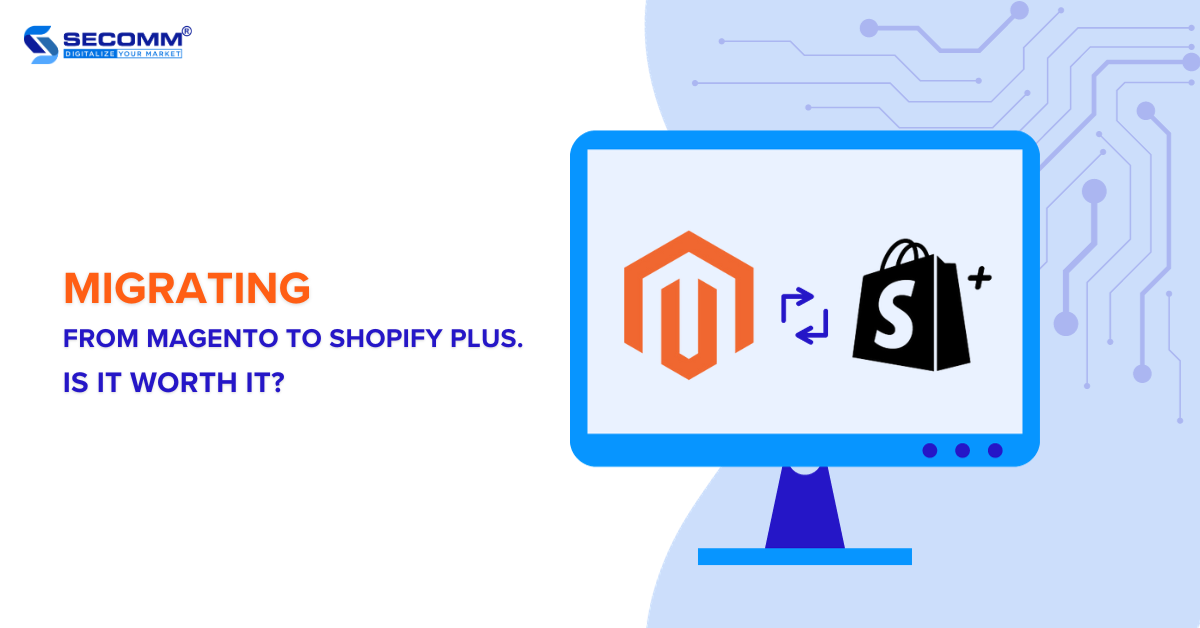
Migrating from Magento to Shopify Plus is a strategic decision that many businesses are considering. While Magento holds a prominent position in the eCommerce market, the ongoing trend of switching to Shopify Plus has raised questions about its reasons, prompting a comparison between the two platforms. Join us in exploring these aspects in this article.
Learn more: Adobe Commerce vs Shopify Plus
Magento is an open-source eCommerce platform with over 140,000 active websites and was acquired by Adobe in 2018. It offers many advanced features, allowing you to tailor your eCommerce websites.
It has two versions: Magento Open Source, a free option to download and install on your servers, and Adobe Commerce (formerly Magento Enterprise), a paid version with premium features such as Adobe’s hosting and security services.
Shopify Plus stands out as Shopify’s advanced SaaS eCommerce platform tailored for large and rapidly growing enterprises. With high scalability, it can handle surges in traffic and sales volumes reaching billions of dollars.
By leveraging Shopify Plus, you can benefit from a robust infrastructure that facilitates easy customization and centralized management of multiple stores, brands, languages, and currencies through a dashboard.
Also, the platform offers a range of superior solutions to enhance eCommerce operations, including Shop Pay, Shopify Flow, LaunchPad, Shopify Scripts, and more.
Many businesses opt to move away from the Magento platform in pursuit of a more optimal solution for their eCommerce websites. However, the following two reasons are widely regarded as the most prevalent.
After launching the Magento 2 (M2) version, the company has declared they’ll no longer support the Magento 1 (M1) version. This means that if you’re using the older version, you won’t receive security updates, bug fixes, and technical assistance.
So, the platform encourages their customers to upgrade to M2 to ensure continued technical support, enhanced security, and access to a variety of new and advanced features.
However, the upgrade process is complex, requiring significant investment in terms of cost and time for source code and interface customization. It may force you to halt your eCommerce operations.
In case you want to keep operating M1 alongside the update process, there’s a potential risk of disrupting system operations, causing significant disruptions to the customer experience, and ultimately affecting sales.
Moreover, there’s also a potential risk of compatibility issues, as some features and modules initially built on M1 may require significant customization to operate effectively on M2.
Faced with these risks, some businesses opt not to upgrade but rather switch to an alternative eCommerce platform. Frequently, these businesses turn to SaaS platforms that offer robust technical support and readily available solutions.
Learn more: M1 vs M2
Some businesses that have upgraded and used M2 for a while have realized that it may not be the best choice. Developing and maintaining a M2 website requires high technical expertise, especially if you want to integrate and customize specific features.
If you don’t have a sufficiently professional technical team or inefficiently collaborate with deployment partners, the customization process is even more complex.
Plus, while the open-source platform offers high scalability, it lacks flexibility. So, if you don’t set up and build your system properly, it may get issues during peak shopping times, leading to crashes and interruptions.
This, in turn, customers to be unable to access the website for purchases, causing significant harm to your brand.
Learn more: The costs of building a Magento eCommerce website
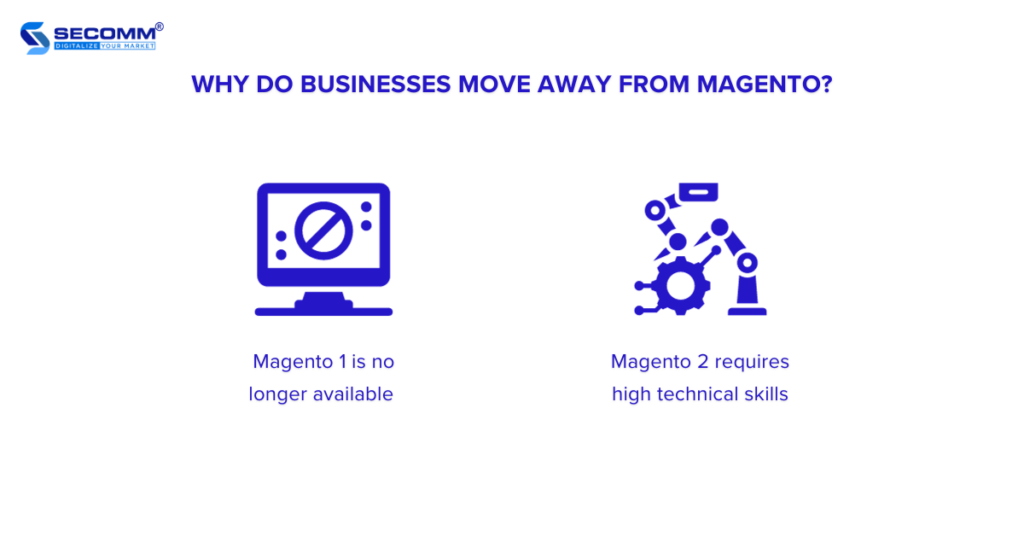
Learn more: 15 reasons why you should migrate to Shopify Plus
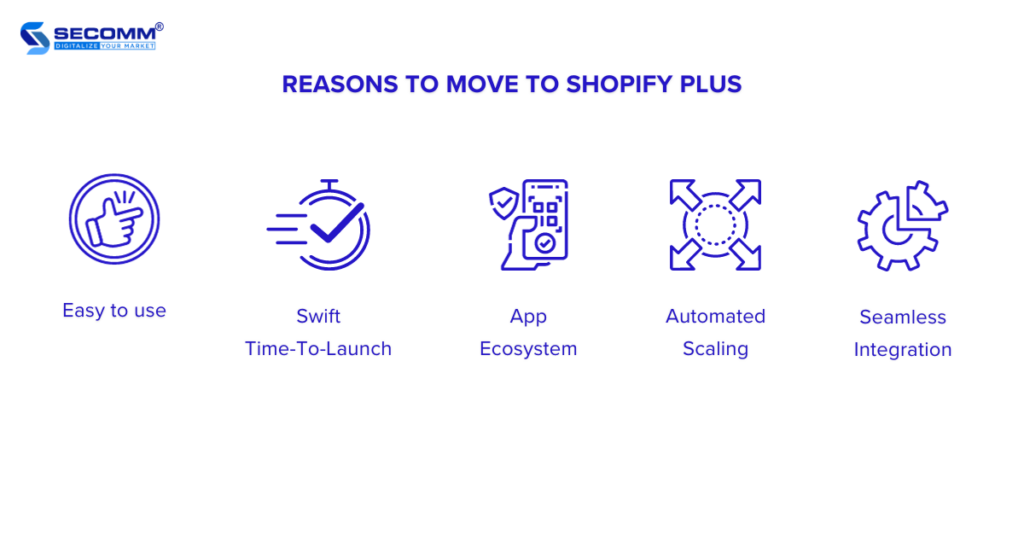
Below are some brands that have previously embraced eCommerce using Magento and switched to Shopify Plus to reduce technical complexities and costs.
Gymshark, a UK-based brand specializing in sportswear and fitness fashion, has emerged as a prominent and favored global sportswear brand since its inception in 2012.
Facing a website crash during the bustling Black Friday shopping season, Gymshark, previously on Magento, made the strategic decision to switch to Shopify Plus.
Despite time and financial investments in repairing and maintaining the system, there was no guarantee of long-term effectiveness.
Upon switching to Shopify Plus, Gymshark capitalized on available solutions such as Shopify POS to elevate both online and offline shopping experiences. The implementation of Shopify Scripts, an exclusive tool for the ‘Plus’ merchants, allowed them to customize and optimize the checkout process.
By using this advanced SaaS platform, Gymshark significantly boosted conversion rates and sales, particularly during major year-end shopping events. This success has firmly established Gymshark as one of the fastest-growing brands globally.

Founded in the United States in 2013, Bombas is a brand specializing in the manufacturing and retail of socks. Renowned for its “buy one, donate one” approach, Bombas pledges to donate a pair of socks to those in need for every pair sold.
Bombas faced website crashes on its previous Magento platform, occurring during Shark Tank program airings and major shopping events like Black Friday and Cyber Monday. These disruptions led to substantial financial losses and incurred significant fees for system repairs over an extended period.
To capitalize on the seamless scalability offered by Shopify Plus, Bombas moved away from the previous. The Bombas website remained resilient during significant year-end shopping events.
The brand not only recouped its investment quickly but also witnessed a remarkable 300% surge in sales compared to the same period the previous year.

Jack Rogers, an iconic American brand specializing in footwear and fashion accessories, has enjoyed widespread recognition globally for an extended period. The brand is not only distinguished for its use of the highest-quality materials in crafting sophisticated and luxurious footwear but also for its global prestige.
After running on the Magento platform for a while, Jack Roger’s eCommerce website started experiencing issues. Each minor update incurred significant time and costs, leading to the decision to switch to Shopify Plus. This move aimed to find a cost-effective solution for operations and maintain the overall stability of the system.
Jack Rogers implemented Shopify Flow to automate both operational and sales processes. The brand also integrated various third-party applications such as Smile, Gorgias, and more to augment the eCommerce efficiency.
Learn more:

Below are some notes to consider during the platform migration process.
There are several methods to migrate data to the Shopify Plus system, such as automated migration, manual migration, and data import/export. You can choose one of these methods or deploy all of them to streamline the migration process and enhance data accuracy.
Customer data
Product data
Transaction data
Switching an eCommerce platform in general and specifically migrating from Magento to Shopify Plus is a complex process that demands detailed planning, precision, and an investment in both budget and time, along with technical expertise.
Therefore, solution architects need to strategize to redesign the system, encompassing system architecture, infrastructure, technology, performance monitoring tools, etc.
When deciding to switch to Shopify Plus, there are some things related to website optimization you need to keep in mind. The URL structure of the two platforms differ, so you should check the navigation of all web pages to ensure the preservation of SEO value and user redirection to the correct pages.
During the platform migration process, a temporary decrease in rankings on search engines like Google or Bing is normal and not a cause for concern. These search engines may take a few days to process the new website and update essential indices.
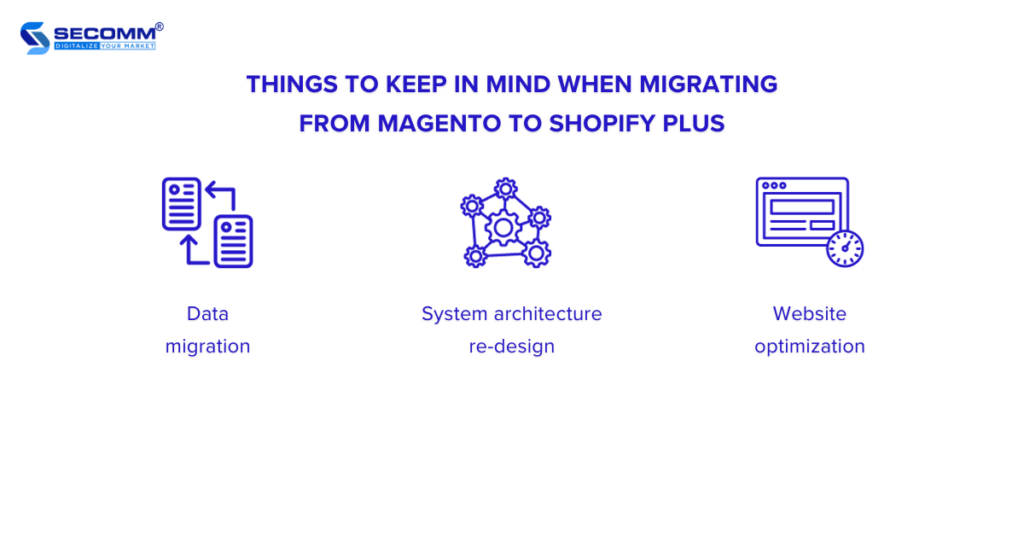
Lately, Shopify Plus has emerged as the preferred choice for businesses making the move from the Magento world.
Having extensive experience in developing eCommerce websites on both eCommerce platforms, and successfully executing the Shopify Plus migrations, SECOMM has become a reliable technology partner for many large enterprises such as Vinamilk and Suzuverse.
Contact SECOMM or call directly at the hotline (028 7108 9908) to start the project of the Magento to Shopify Plus platform migration process tailored to your business.
 2
2
 4,955
4,955
 0
0
 1
1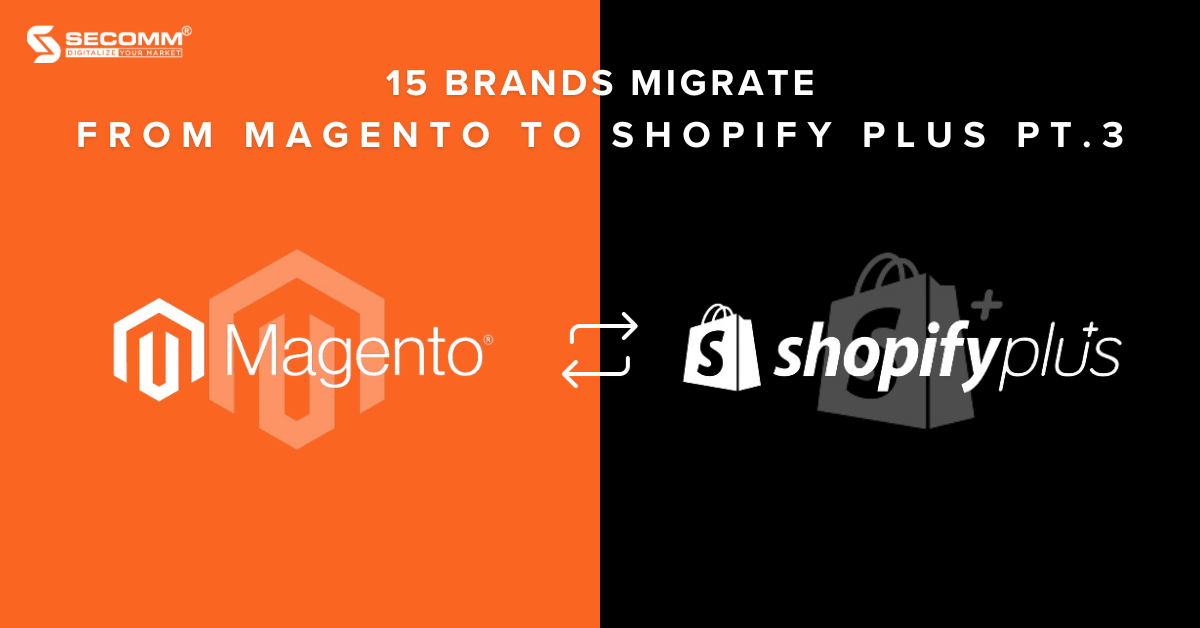
Building upon the narratives in parts 1 and 2, this third part invites you to delve into the stories of the remaining brands within the series of 15 that migrate from Magento to Shopify Plus. Explore how this strategic decision has led to their success in terms of sales and paved the way for sustainable growth in the future.
Learn more:
Beard & Blade is a wholesale business specializing in providing products for hair styling, beard care, and beauty and skincare for men. The brand is known for offering high-quality products tailored for men who aim to maintain their appearance and well-being.
Beard & Blade’s wholesale website was initially built and developed on the Magento eCommerce platform. However, according to the Beard & Blade team, operating the wholesale system on this platform proved to be challenging and required numerous manual tasks.
This resulted in time loss, and the overall cost for their wholesale system to operate on Magento was a considerable amount. Therefore, the brand decided to revamp its platform with Shopify Plus.
After considerable efforts, Beard & Blade’s Shopify Plus wholesale website for men’s products was officially launched.
By utilizing Shopify Plus’s dedicated solutions for wholesalers, Beard & Blade was able to automate inventory management, customize product pricing, and set discount levels based on the quantity of products ordered.
In contrast to the previous operational experience on Magento, wholesale orders on Shopify Plus are processed consistently, without interruptions, and without requiring manual tasks, thus avoiding disruptions to the customer experience.
Since the launch of the new website on Shopify Plus, Beard & Blade’s wholesale revenue has increased by 100%, and the average order value (AOV) for wholesale is five times higher than the retail AOV.

Milligram is a fashion and stationery brand headquartered in Melbourne, Australia. The brand primarily focuses on producing and providing stationery products, including notebooks, pens, and bags made from premium materials with unique designs.
Initially, Milligram built its eCommerce website on the Shopify platform, and later, in pursuit of brand growth, switched to using the Magento platform. After a while, as Milligram expanded its scale with more offline stores, the Magento website system started to operate slowly, and the backend database was overloaded.
Errors and delays occurred during updates, causing disruptions beyond the normal timeframe. Therefore, Milligram returned to Shopify, but this time opting for the advanced version – Shopify Plus.
Leveraging the available solutions of Shopify Plus, Milligram built and customized advanced features, such as an enhanced search function, to provide an optimal shopping experience for customers.
The platform transition from Magento to Shopify Plus was swift and smooth. Milligram easily executes promotional campaigns, uploads products without requiring technical skills, and finds managing and operating the Shopify Plus system more straightforward compared to Magento.
This allows Milligram to focus wholeheartedly on sales, marketing, and enhancing customer relationships.

Eden Park is a prestigious fashion brand originating from France, renowned for its high-end sportswear and fashion products. The brand specializes in providing premium sports and fashion items, with their collections often combining a blend of comfortable and luxurious styles.
In 2021, Eden Park turned its attention to Shopify when contemplating entry into the U.S. market. Moreover, at that time, Eden Park’s eCommerce website faced numerous operational issues.
Bastien Borget, the eCommerce Director of Eden Park, admitted that the business spent approximately 80% of its time operating the Magento website, yet the system consistently experienced errors, and the maintenance incurred substantial costs.
During Black Friday, the Magento website crashed due to overload from a sudden surge in traffic. At that point, Eden Park decided to revamp its platform with Shopify Plus, utilizing solutions within the Shopify ecosystem such as Shopify Payment and Shopify Flow.
Additionally, the superior integration capabilities of Shopify Plus allowed Eden Park to seamlessly integrate with third-party applications like Klaviyo, Gorgias, and Babak.
Eden Park’s Shopify Plus eCommerce website took less than 2 months to launch. One year after the introduction of the new website, Eden Park’s revenue increased by 30%, and the conversion rate rose by 48%.
The solutions provided by Shopify Plus alleviated the operational burden for Eden Park, allowing the business to allocate more time to marketing and sales rather than website maintenance, contributing to impressive business results.

Jack Rogers is a renowned footwear and fashion accessories brand headquartered in New York, USA. The brand is known for producing stylish sandals with traditional designs and premium materials, making Jack Rogers an icon of aristocratic fashion.
For a prominent fashion brand like Jack Rogers, utilizing a website as a potential sales channel remains crucial. However, the Jack Rogers website operating on the Magento platform began experiencing errors after a certain period.
Tasks such as repairs, changes, system operations, or running marketing campaigns consumed a significant amount of time for the technical team, leading to higher costs for Jack Rogers.
Moreover, inventory management posed challenges, with overselling issues occurring, and inaccuracies in the system’s quantity calculations resulting in revenue loss and a suboptimal customer experience.
Therefore, the Jack Rogers team sought to simplify their system, implement automation processes, and reduce technical burdens to focus on more critical business tasks.
The migration from the Magento platform to Shopify Plus helped Jack Rogers address these challenges. The new Jack Rogers website leveraged Shopify Flow solutions to automate operational, marketing, and sales processes, saving considerable time and labor compared to the manual processes of the previous Magento website.
Jack Rogers also utilized Shopify Plus Certified App applications to enhance the customer experience, including Returnly, Smile, Gorgias, and others.
During the Covid-19 social distancing period, Jack Rogers’ Shopify Plus website became the primary sales channel for the brand, experiencing a 60% increase in website traffic and a 30% increase in conversion rates.

Skin Inc is a skincare brand based in Singapore, specializing in providing personalized skincare products based on scientific principles and advanced technology. The brand is renowned for creating diverse and high-quality skincare products, particularly serums and unique skincare items.
With pride in their personalized products, Skin Inc also aimed to build an optimal online shopping experience with a high degree of personalization for customers. However, the business lacked the tools to achieve this.
Each time the technical team made a few changes, the website system immediately slowed down, lagged, and sometimes even had to temporarily suspend operations, causing disruptions to customer shopping.
This issue occurred frequently, especially during major year-end shopping seasons, resulting in substantial losses for Skin Inc, amounting to thousands of dollars.
Therefore, Skin Inc needed an alternative eCommerce solution that could be easily customized to deliver the best customer experience. Skin Inc transitioned from Magento to Shopify Plus and swiftly found solutions to enhance the customer experience.
With multi-store management features, Skin Inc could create multiple versions of eCommerce websites to tailor the experience for different customer segments in various markets.
In addition, Skin Inc implemented Shopify Flow and LaunchPad solutions to automate operational and sales processes. The seamless integration capabilities of Shopify Plus enabled Skin Inc to easily integrate with third-party applications to enhance marketing campaigns and customer loyalty programs.
As a result, this renowned beauty brand was able to reduce operational time by 50% and increase conversion rates by 200%.

So, SECOMM has gathered insights from 15 representative brands that courageously stepped out of the “Magento world” to revamp their eCommerce websites with Shopify Plus. These brands prioritize customer experience and streamlined processes, inspiring others to confidently opt for platform migration.
Contact SECOMM or call directly at (+84)28 7108 9908 for advice and implementation of the eCommerce migration process from Magento to Shopify Plus today!
 25
25
 4,743
4,743
 0
0
 1
1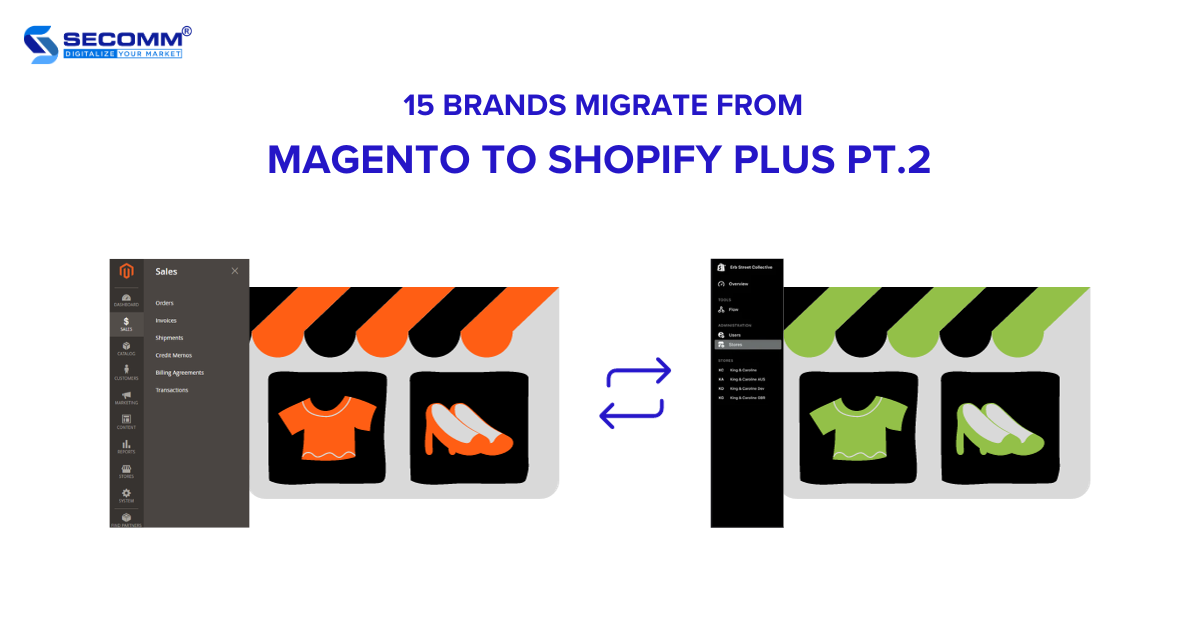
When it comes to brands that migrate from Magento to Shopify Plus, it’s good to read their success stories in sales behind. In the second part of this series, let’s continue to delve into more brands that chose to migrate their eCommerce platforms from Magento to Shopify Plus, and explore how this decision paved the way for boundless success.
Originally established as a wholesaler distributing high-quality underwear through pharmacies, Boody later identified new growth opportunities by venturing into online sales for environmentally conscious fashion enthusiasts.
Boody initially deployed an eCommerce website on the Magento platform, but the absence of a dedicated technology team severely limited management, operations, and customization capabilities.
Also, inconsistencies between the frontend on mobile devices and laptops, utilizing different technological solutions, resulted in a non-uniform user experience and inefficient use of system resources.
To address these challenges and pursue goals of international expansion, Boody sought a platform that could alleviate the burden of management and operations while providing a consistent customer experience.
The fashion brand switched from Magento to Shopify Plus, promptly implementing automated solutions for processes such as email and security checks using Shopify Flow. Boody also adopted Shopify Payments to facilitate online transactions without the need for integration with third-party payment service providers.
The platform overhaul with Shopify Plus significantly enhanced the operations. Leveraging the robust integration capabilities of Shopify Plus, Boody seamlessly integrated with third-party systems to strengthen customer relationships, including platforms like Klaviyo, Gorgias, and Odoo.
Benefiting from the flexibility and solutions offered by Shopify Plus, Boody developed a customized eCommerce website without requiring extensive technical expertise. This allowed the Boody team to focus on multi-channel sales strategies and international expansion.
Shortly after the platform transition, Boody rapidly expanded into 10 international stores, witnessing a 70% increase in online sales and a 5% rise in conversion rates. With Shopify Plus, Boody is realizing its mission to become the world’s most beloved sustainable underwear brand.
Learn more: 15 brands migrate from Magento to Shopify Plus Pt.1

Alessi is a renowned Italian brand specializing in the design and manufacturing of high-quality household and interior decoration products. The brand was established in 1921 and has since become one of the icons of Italian art and design.
Alessi pays attention to every detail in product design while relying on third-party units to enhance the aesthetics of its website design.
However, the Magento eCommerce platform, which Alessi had been using for a long time, suddenly announced the end of support for older versions, obliging merchants to upgrade to a higher version.
Faced with the complex and time-consuming upgrade process, Alessi decided to seek an alternative solution.
Moreover, the outbreak of the Covid-19 pandemic in Italy and across Europe prompted Alessi to make necessary changes to maximize online sales. The business executives aimed to re-establish the platform within just 12 weeks.
In reality, Boody achieved the goal in less than 3 months by completing the e-commerce platform transition from Magento to Shopify Plus.
Since implementing Shopify Plus, Alessi has seen a 233% increase in page views, a 109% increase in conversion rates, a 222% increase in transaction volume, and a 210% increase in total online revenue.
Alessi can now rest assured that customers will have an engaging shopping experience on the website, reflecting the true brand image that the business has spent a century building.

Rebecca Minkoff, a renowned high-end fashion brand from the United States, is well-known for its handbags, footwear, and fashion accessories. The brand’s products often embody a blend of alluring, practical, and creative styles.
Rebecca Minkoff not only focuses on creating aesthetically pleasing fashion items but also consistently leverages technology to provide customers with novel shopping experiences over the past decade.
In addition to this, the customer’s online shopping experience on the brand’s eCommerce website is a particular area of emphasis. The migration from the Magento eCommerce platform to the Shopify Plus platform is also part of Rebecca Minkoff’s strategy.
Utilizing solutions available within the Shopify Plus ecosystem, coupled with robust and seamless integration capabilities, has enabled this fashion brand to implement 3D and AR (Augmented Reality) technologies.
These technologies aim to enhance customers’ unique, detailed, and realistic views of products, ranging from styles to materials.
According to the company, individuals interacting with 3D models are 44% more likely to add that model to their shopping carts compared to those who do not interact. Among visitors who engage with 3D models, they have a 27% higher likelihood of placing an order compared to non-interacting individuals.
Rebecca Minkoff notes that when customers view a product in AR, their likelihood of making a purchase increases by 65%.
This positive step in eCommerce has significantly contributed to business growth. According to Rebecca Minkoff, 65% of customers interacting with AR products tend to make purchasing decisions swiftly, and with 3D technology, this figure is 27%.

Established in 2012 in the United Kingdom, Blakely is a unisex fashion brand known for its youthful and dynamic style. Blakely’s product range includes t-shirts, hoodies, sweaters, leggings, jeans, and fashion accessories. The brand aims to provide high-quality, beautifully designed, durable products that align with current fashion trends.
Blakely’s eCommerce website was initially built on the Magento platform. However, the system frequently experienced crashes, especially during peak shopping periods like Black Friday, affecting customer shopping experiences and the brand’s revenue.
Another concern for Blakely with the previous platform was its limitations in integrating with third-party applications, posing challenges in reaching target customers and efficiently managing customer data to drive real growth. Furthermore, the lack of tools for data management led to issues in the personalization and localization of the customer experience.
Therefore, after careful consideration, Blakely decided to migrate from the Magento platform to Shopify Plus. With the implementation of Shopify Plus, Blakely successfully launched two additional eCommerce websites specifically catering to EU and U.S. customers, enabling the brand to sell more efficiently in international markets.
Blakely also utilized Shopify Plus’s available themes and seamlessly integrated with third-party tools to not only provide an optimal shopping experience for customers but also support effective data management.
Switching to Shopify Plus brought about significant positive changes for Blakely in terms of sales. Specifically, the conversion rate increased from 1.4% to 2.6%, and the EU store witnessed an impressive 30% growth since its launch. Global sales increased by 49%, with a 130% increase in sales in the U.S. and a 60% increase in sales in the EU.

Peepers is a fashion brand specializing in reading glasses and sunglasses with its main headquarters located in Michigan, USA. The brand is known for blending modern design with quality, offering high-quality products at affordable prices.
Despite several redesigns that consumed considerable time and budget, Peepers’ Magento website failed to meet expectations.
The brand aimed to enhance page loading speed and provide customer-centric features, but the costs associated with each change or system update on Magento proved to be a significant expense for Peepers.
Therefore, Peepers made the switch to Shopify Plus to leverage the platform’s flexible customization capabilities with a more cost-effective approach than Magento.
Furthermore, offering a customized payment experience enhances the security of customers’ personal and payment information, thereby increasing customer trust when shopping on the Peepers website.
Since transitioning from the Magento platform to Shopify Plus, this fashion brand has witnessed a 30% increase in conversion rates and a 20% increase in the average order value (AOV).

Here are the next 5 brands in the series re-platform from Magento to Shopify Plus. While Boody’s motivation for the switch is to ease the burdens of management and operations, Alessi, in contrast, seeks to avoid the expenses and time involved in upgrading to a higher platform version.
Rebecca Minkoff, however, aims to capitalize on the existing ecosystem of Shopify to implement 3D and AR technology solutions for their eCommerce website.
Similarly, Blakely and Peepers overhauled their platforms to streamline operational time and costs, leveraging the advanced integration capabilities of Shopify Plus to deliver a distinctive customer experience.
Throughout SECOMM’s process of executing platform migration, the pivotal factor determining success is a detailed and well-structured conversion plan.
Contact SECOMM or directly call the hotline at (028 7108 9908) to collaborate on devising the optimal plan for the platform migration.
 2
2
 5,188
5,188
 0
0
 1
1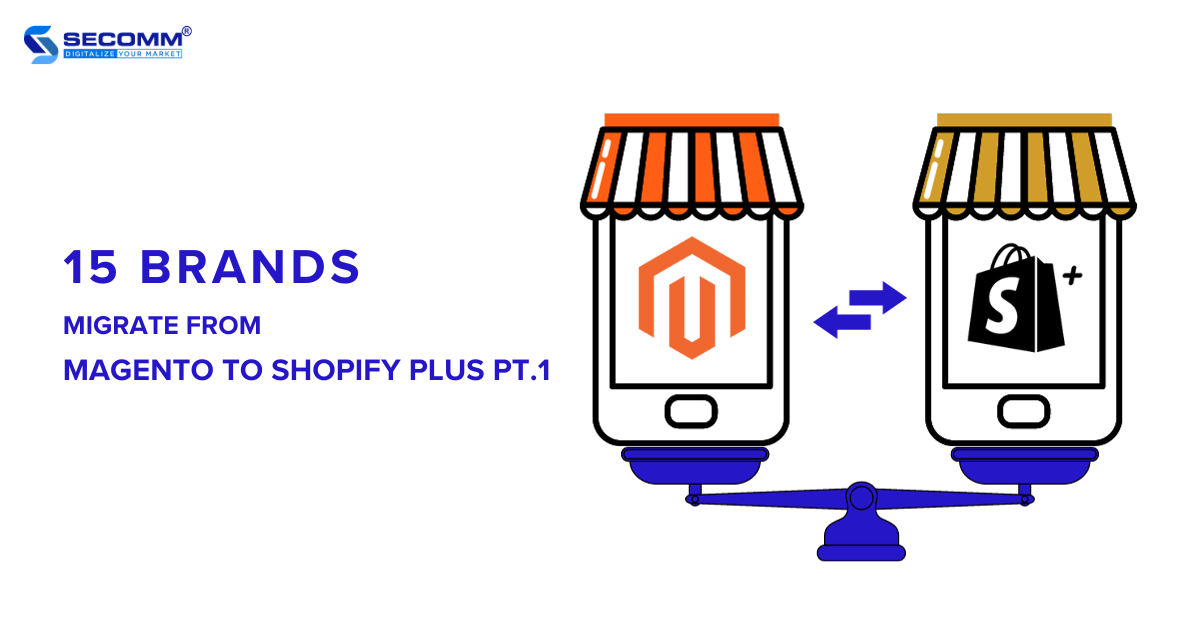
Magento is known as the ‘golden standard’ for many eCommerce businesses. With its scalability and flexible customization, Magento can provide a unique shopping experience.
However, the complexity of deploying, managing, and maintaining the system has led many brands to step out of the ‘Magento world’ in search of more optimal solutions. Shopify Plus is one of the popular choices today for streamlining the migration.
Let’s delve into why the following five brands opted to migrate from the Magento platform to Shopify Plus for their eCommerce websites, and how this strategic decision has contributed to increased conversion rates and sales.
Learn more: 15 Reasons You Should Migrate to Shopify Plus
Established in 2012, Gymshark, a renowned athletic wear retail brand, adopted Shopify Plus. However, before making the switch, the brand had built and developed its eCommerce website using Magento.
For a fashion retailer, year-end shopping seasons, especially Black Friday, represent opportunities for sales growth. Simultaneously, Gymshark’s rapid expansion since its inception required more from a platform capable of managing spikes in traffic and consistently scaling with its business objectives.
Dissatisfied with the existing system, the Gymshark team faced not only the time-consuming setup and operation but also significant costs – amounting to thousands of dollars – for repairing and maintaining the system that crashed precisely during the Black Friday event.
According to Ben Francis, the founder of Gymshark, the eCommerce website was down for about 8 hours, resulting in an estimated damage of over £100,000.
Therefore, Gymshark overhauled its platform with Plus, leveraging Shopify POS and Shopify Script solutions to bridge the gap between offline and online shopping experiences. They enhanced these shopping experiences with custom code snippets at the checkout page.
With these tools, Gymshark only needed to customize based on its specific needs and goals. In contrast, developing such features on Magento could have consumed considerable time and budget.
The platform switch to Shopify Plus helped Gymshark achieve a retail turnover of £41 million and garner over 5.1 million social media followers in 2017, propelling the business to become one of the fastest-growing brands globally.

Arising from an inspiring founding narrative, Bombas, a U.S.-based sock manufacturer and retailer, committed to donating a pair of socks for each pair sold to those facing homelessness. The company garnered successful funding on Shark Tank in 2013, capturing the interest of both investors and American consumers.
However, the joy quickly turned to dismay when Bombas secured a deal with investor Daymond John, and their Magento eCommerce website suffered not one but two crashes—first during the initial airing and then during the subsequent rerun of the episode.
Compounding the issue, the most disastrous moment for Bombas occurred when their Magento website collapsed amid the peak shopping season of Black Friday and Cyber Monday (BFCM).
The system failure hindered customers from completing transactions, resulting in Bombas incurring significant financial losses, additional expenses, and extended downtime for system repairs.
Therefore, Bombas needed a more reliable eCommerce platform that could effectively address the issues they encountered, leading them to choose Shopify Plus.
The infrastructure of Shopify Plus facilitated Bombas in effortlessly and seamlessly expanding their system. Moreover, the eCommerce website system consistently withstood the demands of major shopping events like BFCM and reruns of the Shark Tank program.
Despite the substantial cost of migrating from Magento to Shopify Plus, Bombas swiftly recovered the investment, generating $17.2 million in revenue during the first year of Shopify Plus deployment—a 300% increase compared to the same period the previous year.
The positive outcomes of transitioning to the Shopify Plus platform are evident not only in financial metrics but also in how Bombas has bolstered its reputation and image in the eyes of customers, delivering a premium shopping experience.

In 2010, from the beaches of Costa Rica, two young entrepreneurs, Griffin Thall, and Paul Goodman, started Puravida Bracelets with a mission to collaborate and provide better income opportunities for bracelet artisans in Costa Rica and around the world.
The Puravida Bracelets story gained attention on social media as customers became curious about the close-to-nature lifestyle in South America, particularly in Costa Rica. Over time, the brand expanded its product portfolio to include necklaces, anklets, earrings, and hair ties.
Similar to many other businesses, Puravida Bracelets began its eCommerce journey with the Magento platform.
However, both Thall and Goodman were ambitious young entrepreneurs who desired rapid growth and development for their bracelet brand. Therefore, the challenge was to scale the eCommerce website system while ensuring the most optimal deployment costs.
This led Thall and Goodman to deploy Shopify Plus to find a solution to seamlessly integrate and combine various tools and applications to manage business operations more efficiently, provide a more engaging shopping experience, and increase sales.
The decision to switch from the Magento platform to Shopify Plus helped Puravida Bracelets increase retail revenue by 50% compared to the same period the previous year. Email sign-ups increased by 350%, and email revenue quadrupled compared to before the platform revamp.

PittaRosso is a renowned footwear retail brand from Italy with over 150 retail stores across Europe. The brand’s goal is to provide customers with an omnichannel shopping experience and implement several enhancements for its eCommerce website.
However, issues related to poor website performance, leading to suboptimal product pages on search engines, made PittaRosso hesitate before deciding to pursue the next goal with Magento. The complexity, time, and budget associated with Magento led PittaRosso to revamp its platform with Shopify Plus.
Simultaneously, they implemented a headless architecture for the eCommerce system and redesigned the SEO architecture and content strategy.
The footwear brand customized the frontend and integrated the CMS platform into the Shopify Plus backend to improve page loading speed, user experience, and SEO results. PittaRosso’s strategic shift coincided with the significant growth of eCommerce spurred by the Covid-19 pandemic, boosting the business’s eCommerce sales in 2021.
By 2022, the sales figures even surpassed expectations, with a 37% increase in net profit compared to the same period the previous year.
Building on this success, PittaRosso implemented payment integrations and automation to optimize multichannel sales operations and the overall shopping experience.
Re-platforming from Magento to Shopify Plus helped the business maintain a steady annual increase in conversion rates, sales, and notably, Black Friday Cyber Monday (BFCM) sales.
Learn more: What is Headless Shopify?

After six years of using Magento, the world’s largest retailer of military surplus and collectibles, IMA, fell victim to a hacker attack that resulted in the theft of a considerable amount of customer credit card information.
This incident led to IMA facing substantial fines from VISA, and Alex Cranmer, the Vice President of IMA, criticized Magento for its delayed notification to merchants about this security vulnerability.
IMA spent over $50,000 and three months rectifying security flaws in its system. Shortly after, Magento announced the discontinuation of support for older versions, implying that IMA needed to upgrade to a higher version, incurring potentially tens to hundreds of thousands of dollars in expenses and an extended timeline for completion.
In response, IMA decided to replatform from Magento to Shopify Plus, seeking a more secure solution for IMA’s system and enhancing the customer experience. Besides security and customization, some unique solutions such as Shopify Flow and LaunchPad significantly boosted IMA’s profit margins.
The costs associated with platform usage, maintenance, operations, and updates were notably reduced compared to deploying Magento.
Cranmer admitted to being complacent, thinking that Shopify was only suitable for individuals selling a small volume of products.
However, the Plus version surprised him with its specialized solutions and features designed explicitly for large, unlimited-growth businesses on their journey.

Here are five brands that have witnessed a remarkable change in sales by migrating to Shopify Plus. An important point to note is that while Magento provides high scalability and customization, the process demands a substantial budget and an extended deployment timeline.
Additionally, there is a need for technical expertise to determine when and how the system should expand. Sometimes, businesses may even face security vulnerabilities, as in the case of IMA.
On the other hand, Plus provides flexible customization with optimized costs, a faster time to market, and simplified maintenance and updates, following the platform’s rules.
Through accumulated experience in numerous eCommerce platform migrations, SECOMM is not only a solution provider but also a reliable partner for every business on its eCommerce journey.
Contact SECOMM or call directly on the hotline (028 7108 9908) for professional advice on planning the migration from Magento to Shopify Plus, unlocking unlimited development opportunities in the digital age.
 2
2
 5,488
5,488
 0
0
 1
1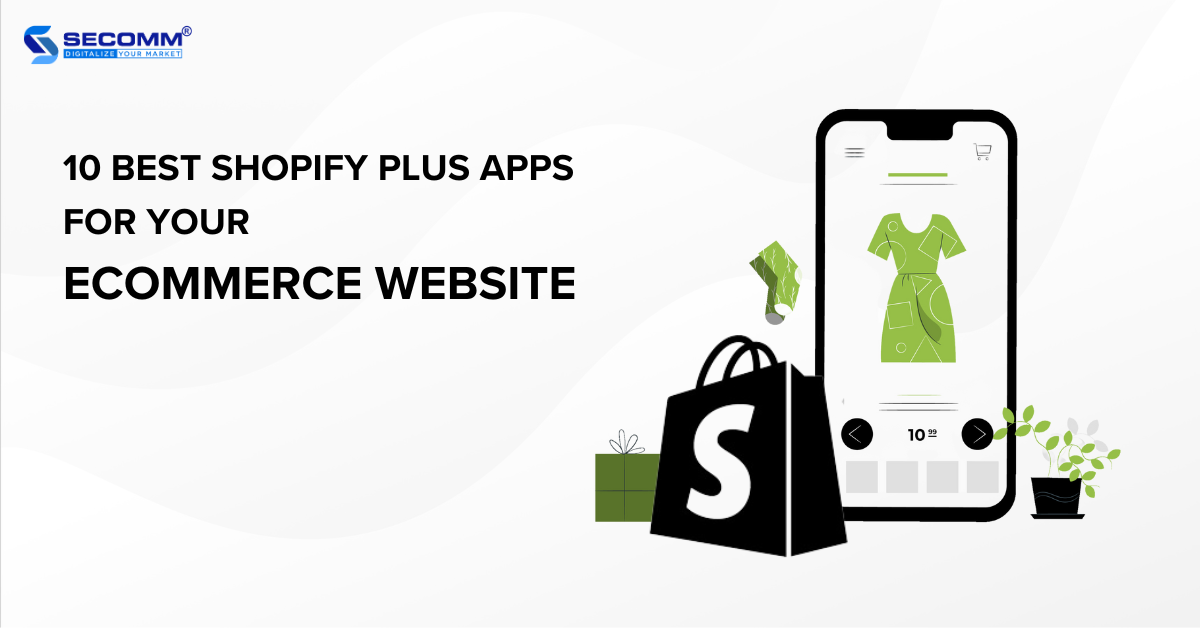
The Shopify Plus eCommerce platform is known not only for its flexibility and high customization but also for its ability to integrate with a variety of apps in the Shopify Plus Certified App, optimizing customer experiences, managing sales, shipping, etc.
The eCommerce world continues to evolve, and choosing the right integrated apps can be a crucial factor in the successful deployment of an eCommerce website.
This article introduces 10 Shopify Plus apps that businesses should consider integrating into their eCommerce websites. These apps not only help optimize operational processes but also ensure that businesses meet all customer needs, create effective campaigns, and increase conversion rates.
Shopify Plus is the premium version of Shopify, offering superior customization and scalability designed to meet the needs of large-scale businesses. Shopify Plus apps are third-party applications or services integrated with the Shopify Plus system to provide management capabilities for various aspects of eCommerce operations, such as marketing, sales, order and shipping management, analytics, and performance reporting.
Using Shopify Plus apps can bring various benefits to businesses, including:
Judge.me is an excellent app designed for businesses using the Shopify Plus platform. This app focuses on collecting, managing, and displaying product reviews and ratings from customers.
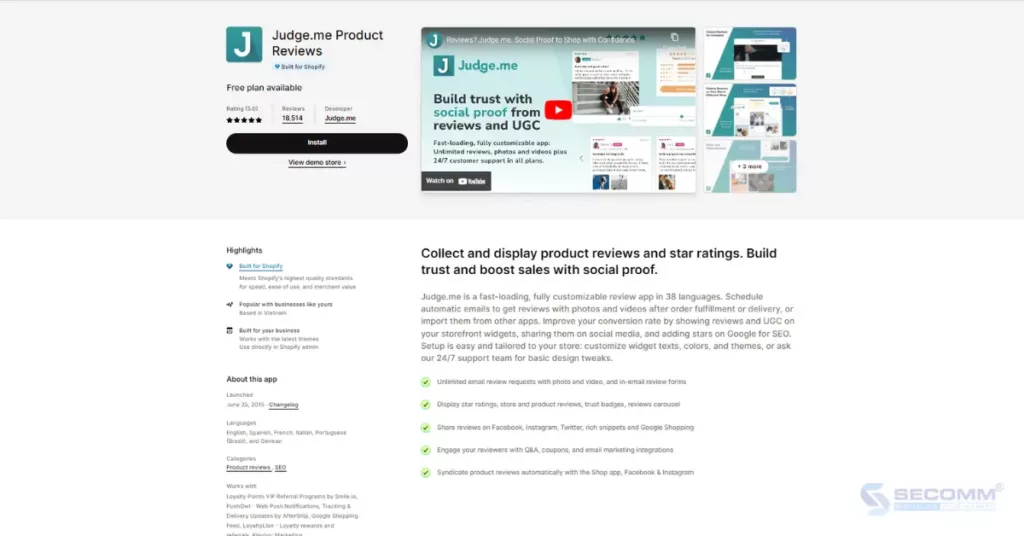
Rating: 5/5
Reviews: 18,391
Core features:
Price: The Judge.me app offers two available solution plans, including:
UpPromote is a Shopify Plus app tailored to meet the needs of affiliate-driven growth for Shopify merchants. This is the top-trusted affiliate marketing solution that supports merchants to build, manage, and succeed in their affiliate programs with ease. UpPromote is suitable for all business sizes, with prices ranging from FREE to $199.99/ month. Furthermore, UpPromote implements customization upon request for Enterprise customers.
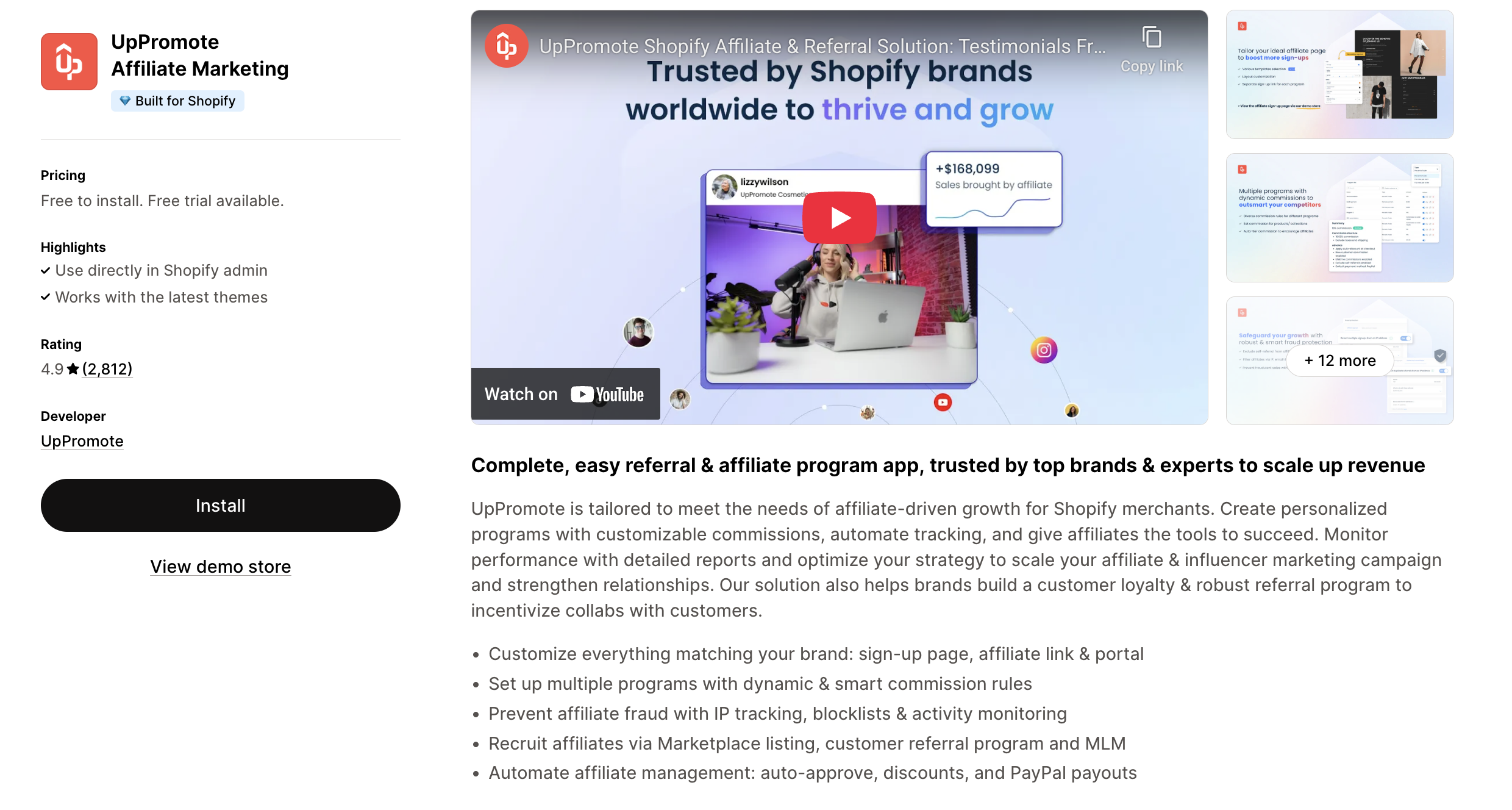
Rating: 4.9/5
Reviews: 2,812
Core features:
Price: UpPromote offers a Free plan and 3 paid plans with a 14-day free trial, including:
This is a Shopify Plus app that allows businesses to design personalized customer experiences. This app ensures that the business website provides suggestions and offers products that customers truly care about to satisfy them and thereby increase sales.
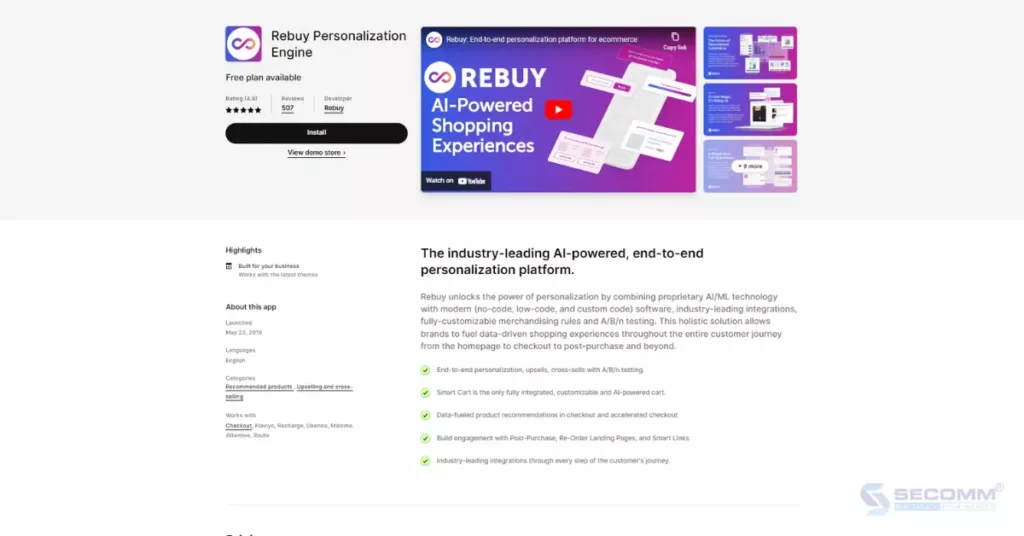
Rating: 4.9/5
Reviews: 508
Core features:
Price: Rebuy offers Shopify Plus users three solution plans, including:
Among the Shopify Plus apps recommended for eCommerce websites, Smile is frequently mentioned for its Loyalty program applications. This Shopify Plus app helps businesses build and manage customer loyalty programs on Shopify Plus stores to enhance customer interactions, increase conversion rates, and attract potential customers.
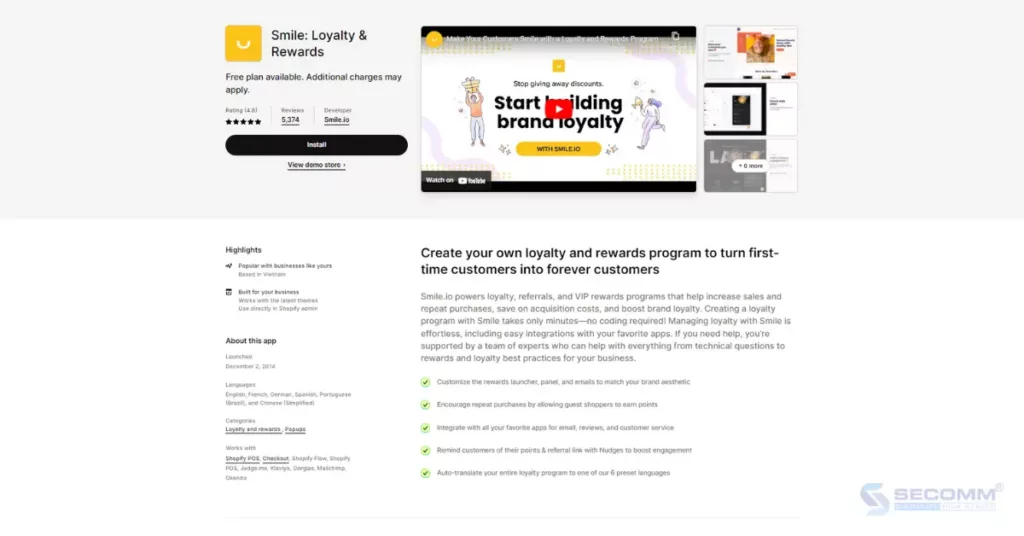
Rating: 4.8/5
Reviews: 5,354
Core features:
Price: Smile offers three solution plans:
Another popular Shopify Plus app is the Shogun Landing Page Builder. This app allows retailers to create beautiful and effective landing pages by providing a visual drag-and-drop editor, enabling Shopify Plus merchants to create custom landing pages without requiring any programming skills.
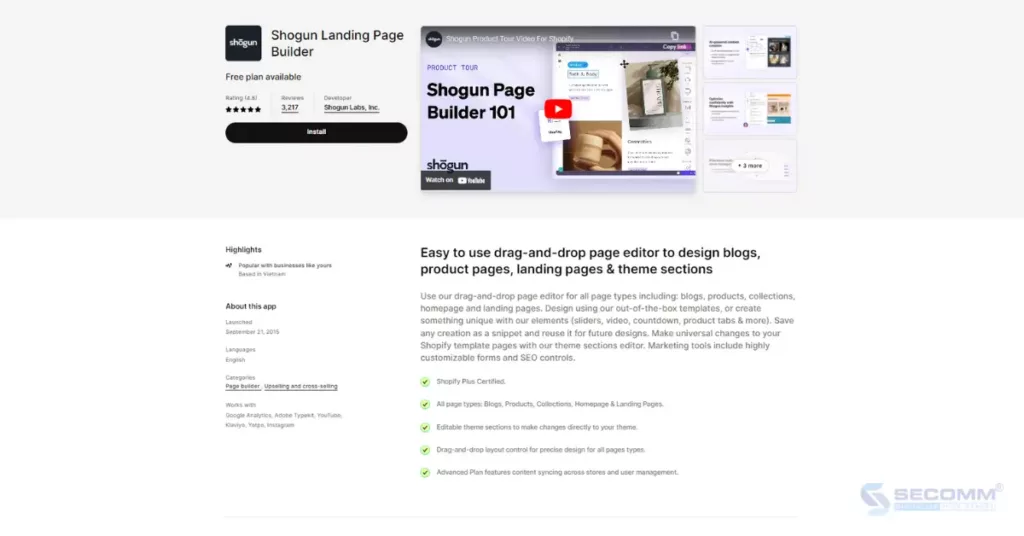
Rating: 4.8/5
Reviews: 3,216
Core features:
Price: Shogun offers four solution plans for Shopify Plus businesses:
Referral is a Shopify Plus app that allows merchants to create and manage referral and affiliate programs. This Shopify Plus app offers a range of features and options to help businesses encourage customers and influencers to refer to their products or services.
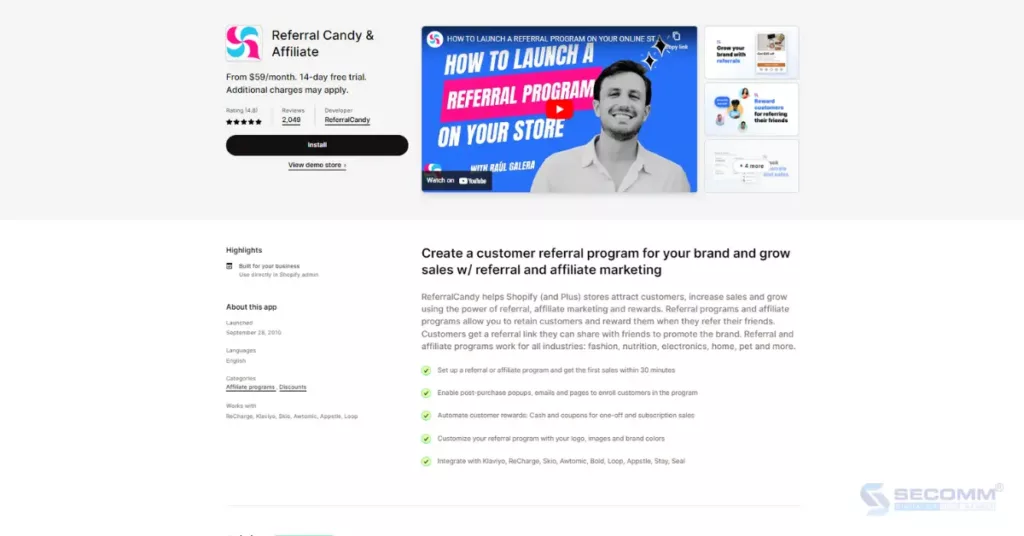
Rating: 4.8/5
Reviews: 2,049
Core features:
Price: Referral offers two solution plans with a 14-day free trial:
AfterShip Returns by Shopify Plus is an optimal solution for businesses seeking to improve the return experience and enhance customer loyalty. The app provides many user-friendly features and options, allowing businesses to automate the return and refund processes and optimize inventory costs.
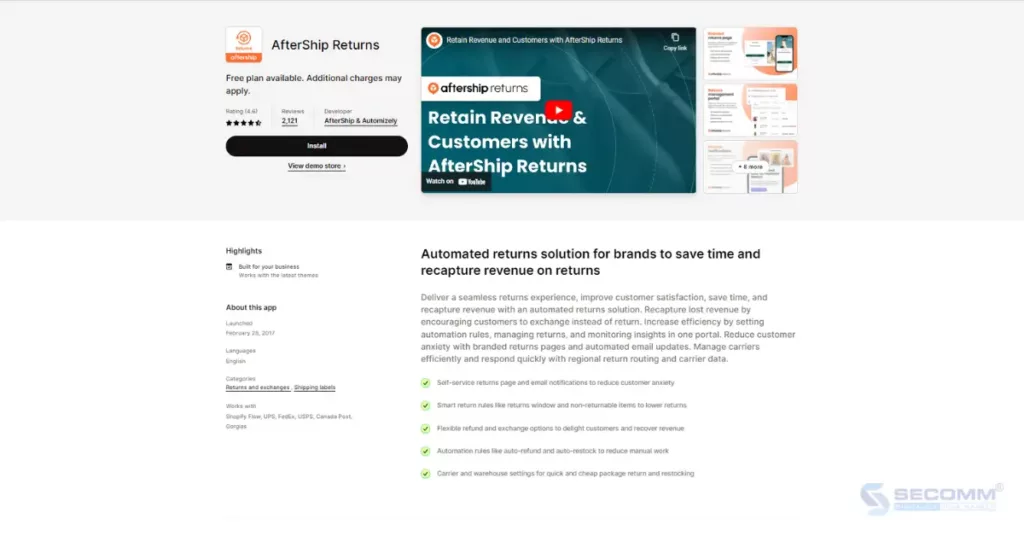
Rating: 4.6/5
Reviews: 2,118
Core features:
Price: AfterShip offers three solution plans for Shopify Plus businesses:
Recharge Subscription is a popular Shopify Plus app that enables businesses to build a seamless shopping journey to maximize revenue and create long-term loyal customers.
With Recharge’s outstanding features, businesses can easily, quickly, and effectively create subscription plans for products or services.
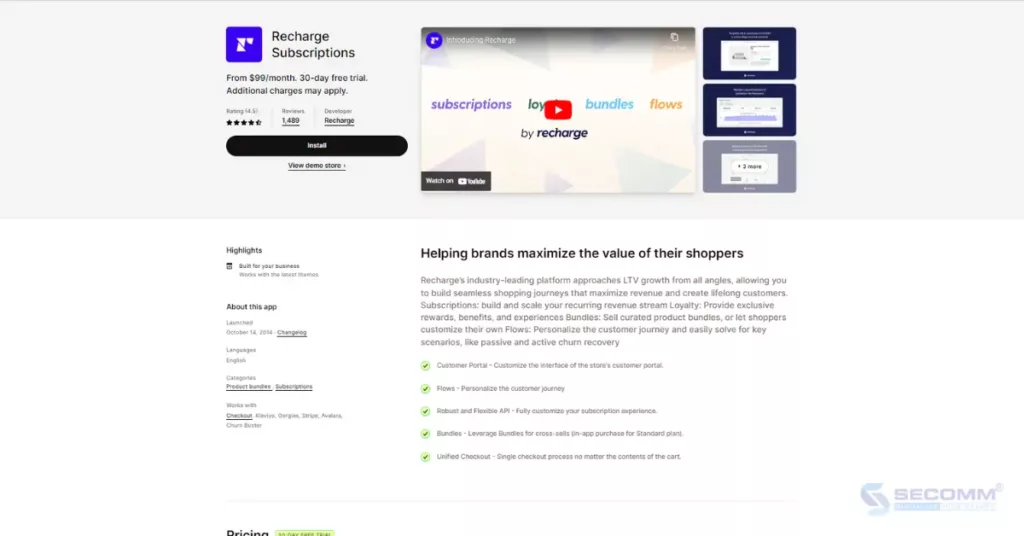
Rating: 4.5/5
Reviews: 1,488
Core features:
Price: Recharge offers a 30-day free trial for businesses.
Gorgias is an app designed for Shopify Plus businesses, focusing on customer service management and online support. Deeply integrated into the Shopify Plus store, Gorgias provides a range of features to help businesses optimize support processes and enhance the customer experience.
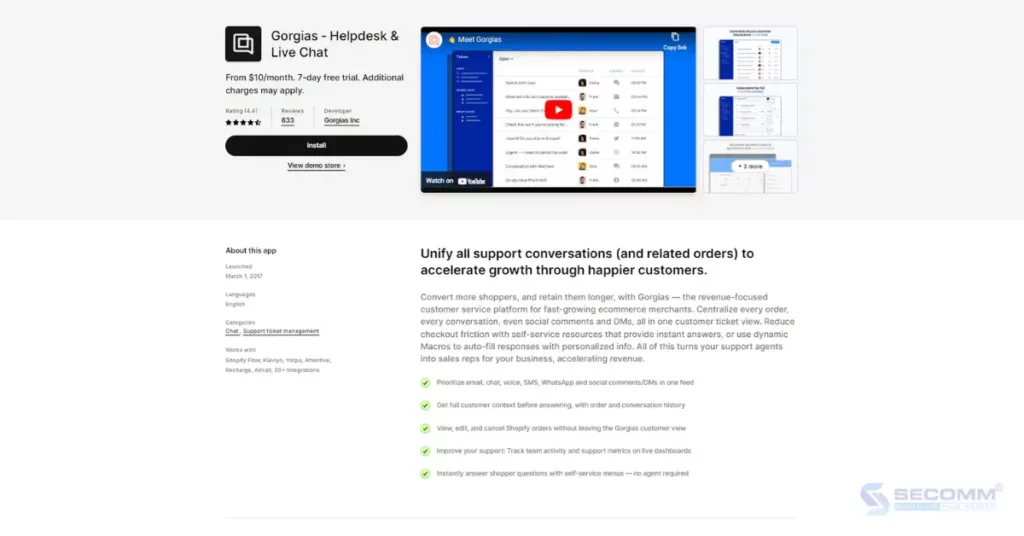
Rating: 4.4/5
Reviews: 632
Core features:
Price: Gorgias offers a 7-day free trial with four solution plans.
Among the Shopify Plus apps, Klaviyo stands out as an application specializing in automated email & SMS marketing. This app helps businesses build and manage automated email or SMS campaigns based on customer data to optimize interactions with customers.
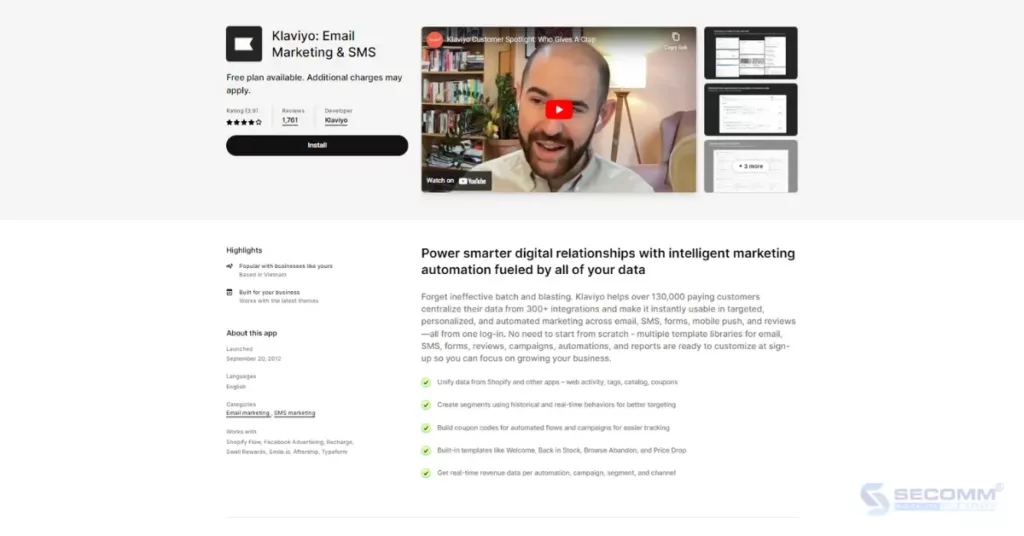
Rating: 3.9/5
Reviews: 1,758
Core features:
Price: Klaviyo offers three solution plans for businesses.
ShipStation is a popular application for managing shipping and delivery processes, integrated into the app store of Shopify Plus. This app helps businesses efficiently manage shipping and delivery processes, optimize label printing, and expedite delivery times.
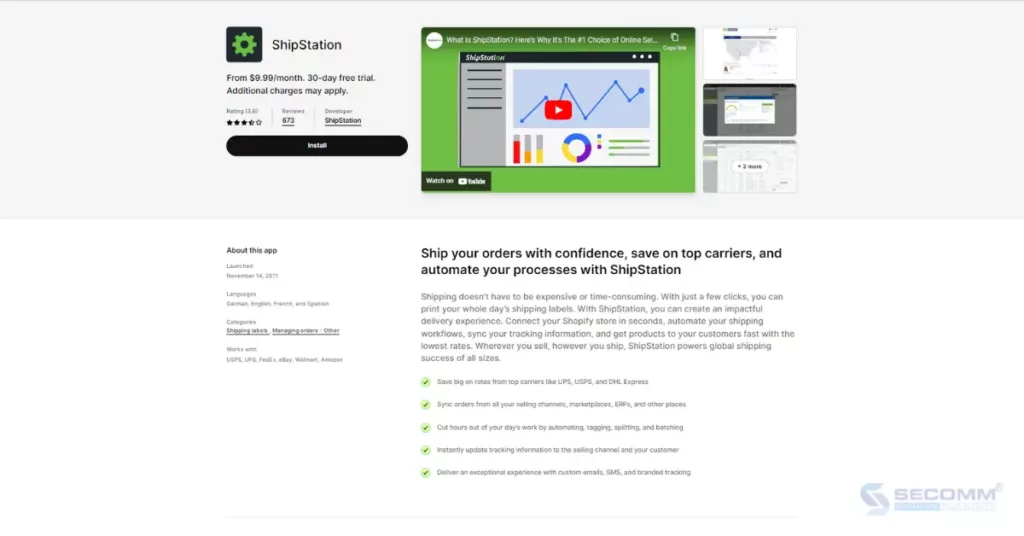
Rating: 3.6/5
Reviews: 674
Core features:
Price: ShipStation offers a 30-day free trial for businesses.
Above are the top 10 Shopify Plus apps in the Shopify Plus Certified App Store. The introduced apps in this article are designed to help businesses optimize the shopping experience, improve sales management, and create more effective marketing campaigns.
However, not all of them may be suitable for every business. Businesses must research and carefully consider before deciding to install and integrate these Shopify Plus apps.
Contact or call SECOMM directly at their hotline (028 7108 9908) for advice on selecting the most suitable apps for your Shopify Plus eCommerce website.
 2
2
 7,704
7,704
 0
0
 1
1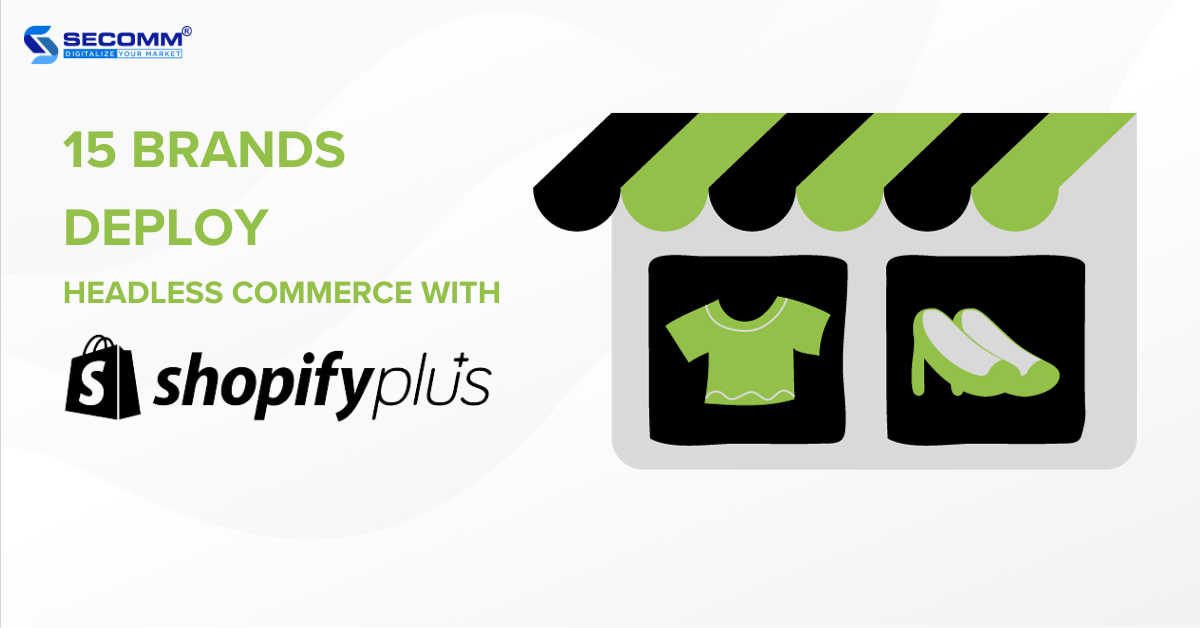
Headless Commerce is one of the fastest-growing trends that contributes to changing how businesses approach eCommerce. Interestingly, Shopify Plus is known as a leading platform in providing superior solutions and tools for businesses to implement Headless Commerce.
The article below lists 15 top brands from various industries that have deployed headless eCommerce websites on the Shopify Plus platform to deliver a more memorable online shopping experience to customers.
Learn more: 15 reasons to switch to Shopify Plus
Babylist was founded in 2011 by Natalie Gordon when she was pregnant and faced difficulty selecting gifts for her baby shower. Babylist is a platform that allows parents to create a list of products they need for their child. This helps party attendees or gift buyers know what items are essential.
It’s crucial for Babylist to optimize for two distinct customer journeys:
This illustrates that shopping involves more than just selecting items from a product catalog; it also extends to registries created by parents, housing product URLs from various sources on the internet. The complexity increases as Babylist enables users to make online purchases and collect items in-store.
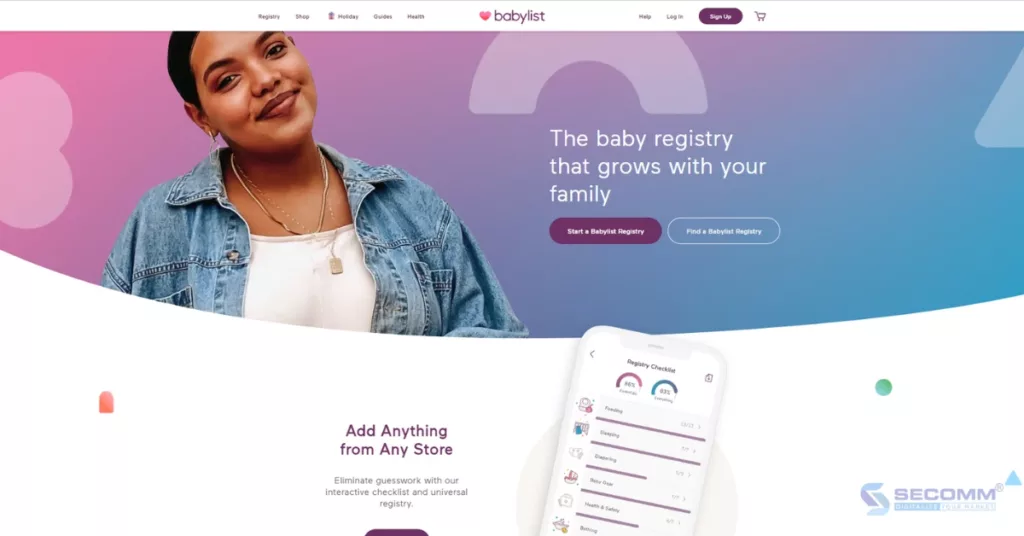
Therefore, Babylist has adopted Headless Commerce with Shopify Plus to customize the customer journey more easily and optimize the management processes of product listings, orders, payments, and inventory. In addition, Babylist also uses a Headless CMS – Contentful to distribute content to the website and mobile app interfaces.
Figs is a high-end medical apparel brand with a focus on minimalist design.
The brand specializes in manufacturing and distributing medical clothing and accessories for healthcare professionals, including households, doctors, dentists, and individuals working in the healthcare industry. Figs’ product range includes medical clothing, jackets, hats, socks, gloves, and shoes.
Prioritizing online sales, Figs has implemented a Headless Commerce strategy using Shopify Plus for backend functions such as product management, order processing, payments, shipping, and more. However, on the frontend, Figs has taken an independent approach to crafting a distinctive and personalized user experience.
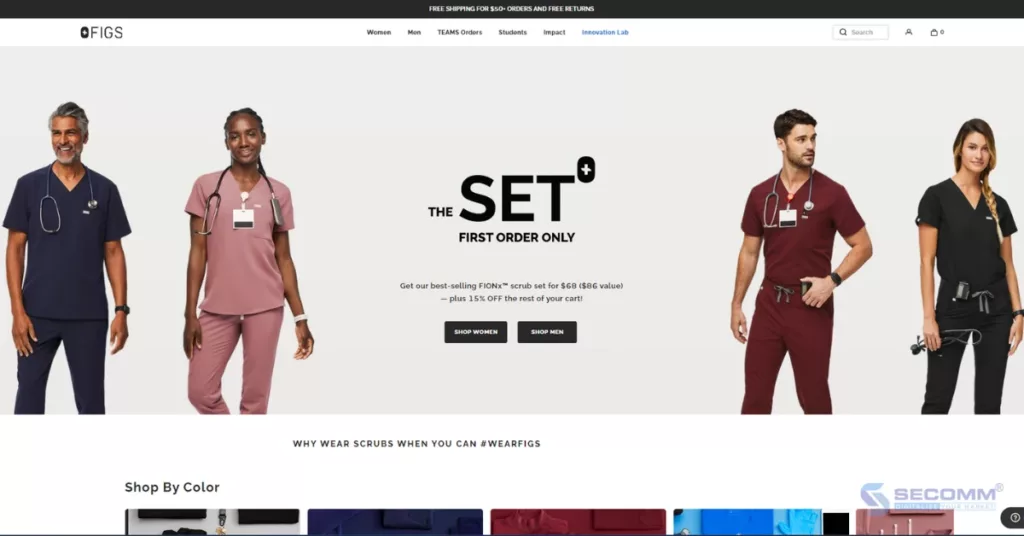
In particular, Figs has utilized Unbounce to create unique and tailored landing pages for products or promotional campaigns. Furthermore, they’ve integrated Next.js to link these customized landing pages seamlessly with the product pages on Shopify.
This approach ensures that when customers visit a specific custom landing page, they can easily locate and purchase products. Therefore, Figs has enhanced the shopping experience for customers, providing a seamless and user-friendly journey to quickly find the products of their interest.
Allbirds is an athletic and footwear brand founded in 2014 by Tim Brown and Joey Zwillinger. The brand is well-known for crafting shoes from sustainable sources and featuring simple, aesthetically pleasing designs. With the slogan “We make shoes to thank the earth,” Allbirds has experienced rapid growth, becoming a prominent name in the fashion industry as a whole and specifically in the footwear sector.
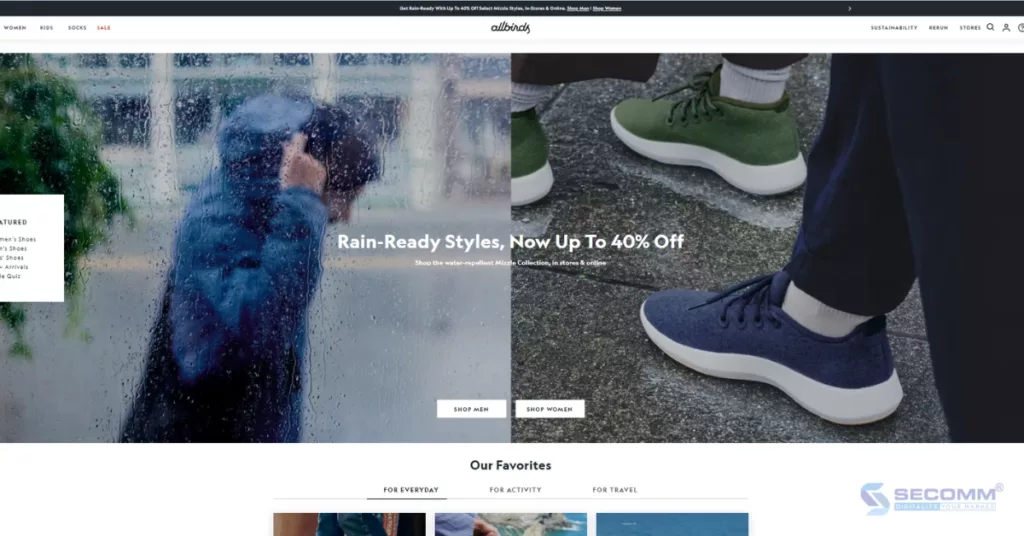
To provide an optimal online shopping experience for customers, Allbirds has deployed Headless Shopify Plus. The Headless architecture allows the brand to customize and control the user interface (frontend) flexibly and efficiently, while Shopify Plus is utilized for managing data and eCommerce operations on the backend.
The deployment of Headless Commerce has enabled Allbirds to create a user-friendly and distinctive interface, providing a unique shopping experience with advanced features.
Headquartered in San Francisco, California, Rothy’s is a well-known fashion brand that specializes in producing footwear from recycled materials, primarily utilizing post-consumer plastic fibers, especially PET. Rothy’s has become an icon capturing consumer interest by combining fashion elements with an environmentally-friendly mindset.
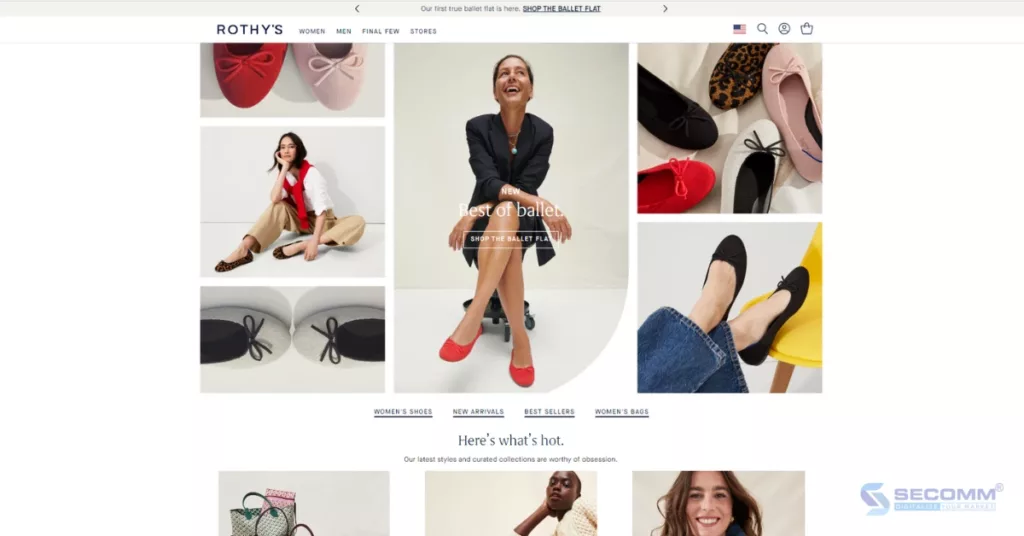
With a desire to “do things differently,” Rothy’s has embraced a Headless architecture to easily expand its presence to various international markets. The Headless architecture allows the brand the freedom to seamlessly integrate preferred technologies into the Shopify Plus eCommerce system.
Meanwhile, Rothy’s can develop independent frontends for each market, enabling adjustments in elements such as pricing and language to suit the specific consumers of each market. This approach helps Rothy’s create a unique and tailored shopping experience for the target customers in each market they serve.
Inkbox is a brand specializing in temporary tattoos that can be easily applied to the skin and nails. It allows users to have the temporary tattoos they desire without the commitment of a permanent one. Inkbox’s ink is made from natural ingredients, ensuring it is skin-friendly with the “Freehand Ink” technology. The brand is an example of leveraging creativity and technology to offer a temporary change for self-expression and image creation on the skin and nails uniquely and excitingly.
Inkbox has implemented Headless Commerce with Shopify Plus to provide an optimal shopping experience for customers, featuring prominent functionalities such as:
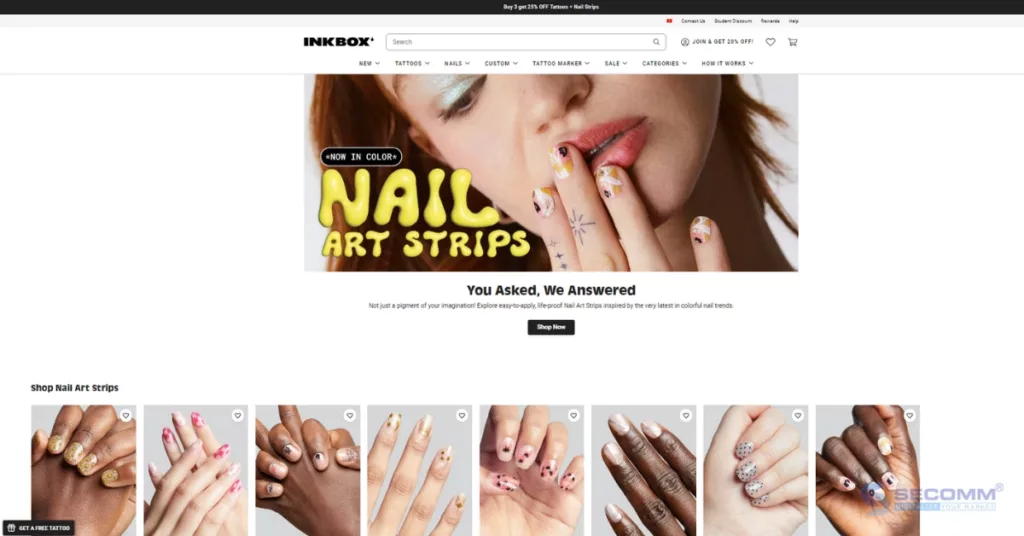
Since its establishment in 2014, Kylie Cosmetics has been widely embraced by consumers throughout North America, and Kylie Jenner was notably honored as a business genius by Forbes. Following the success of Kylie-branded cosmetics, in 2019 Kylie Jenner marked a new milestone by introducing the skincare line named Kylie Skin.
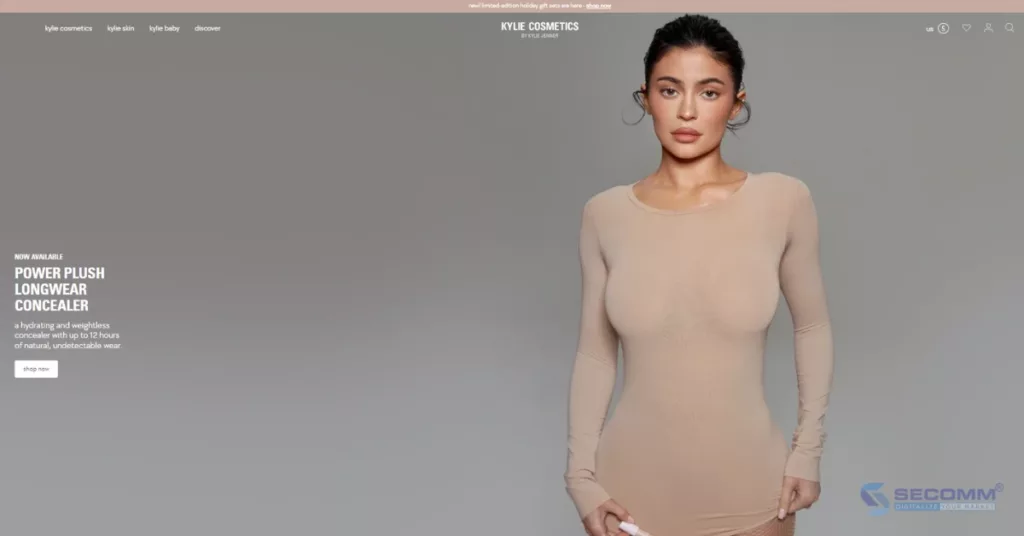
Quick to embrace the Headless Commerce trend, Kylie Cosmetics has implemented Shopify Plus for core functionalities on the backend, such as payment and delivery.
In addition, this platform provides the brand with exceptional flexibility to integrate third-party services for a more diverse range of custom operations on the frontend.
This enables Kylie Cosmetics to offer a unique and appealing online shopping experience for customers while benefiting from the robust and stable infrastructure of Shopify Plus.
Vinamilk is the national brand of Vietnam, offering a wide range of trusted dairy products such as fresh milk, yogurt, condensed milk, ice cream, and more. In 2023, Vinamilk implemented a repositioning strategy to strengthen its position in the domestic market and expand its business activities internationally.
As part of this strategy, Vinamilk integrated its eCommerce website and corporate website to provide a more consistent and seamless customer experience, as well as to manage data more efficiently.

Vinamilk collaborated with SECOMM to make a decisive move towards implementing the Headless Commerce + Headless CMS model based on the Shopify Plus eCommerce platform and a Headless CMS system.
The revamped appearance of Vinamilk’s website signifies a transformation from traditional to modern, from segregation to integration, and from focusing solely on sales to enhancing the overall customer experience.
ILIA is a beloved clean beauty brand that has won numerous consumer awards. The brand was created to help users protect and restore their skin through safe and highly effective formulas.
Initially running on Shopify Advanced, ILIA’s eCommerce website quickly grew and upgraded to Shopify Plus for more flexible customization capabilities.
ILIA implemented Headless to provide diverse and impressive visuals, helping customers find the exact type of cosmetics suitable for their skin without creating a cluttered web experience that could impact performance and page loading speed.
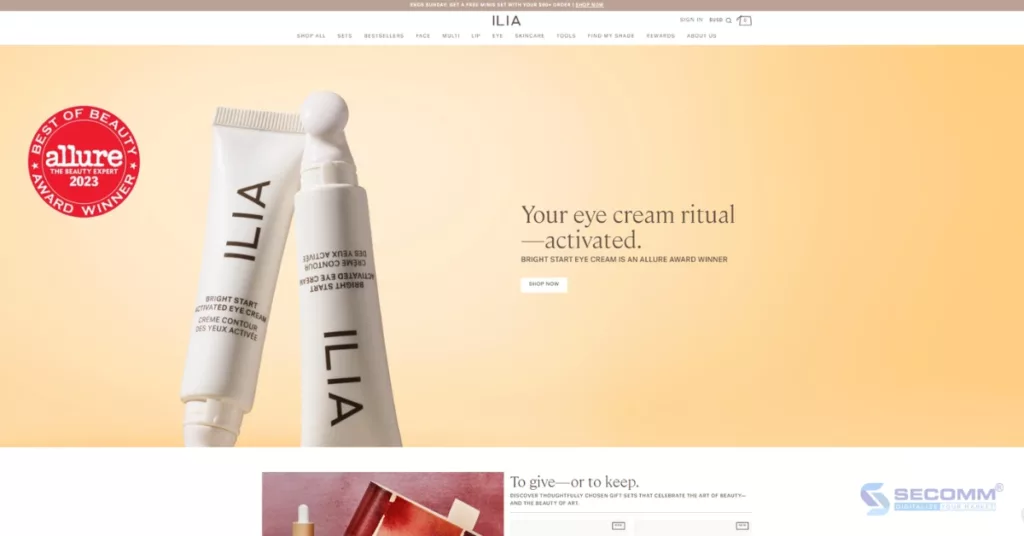
By deploying Headless Commerce on Shopify Plus, ILIA’s developers have the freedom to experiment with various types and formats of content. This approach has significantly improved the frontend capabilities, such as faster page loading speed, and has provided customers with an enhanced shopping experience, including the “Find My Shade” feature.
Established in 1575, Bols is a brand specializing in cocktails that has been present in bars, restaurants, and airplanes worldwide for many years. After years of operation, the brand aimed to sell its products to consumers on a global scale. Therefore, Bols built an eCommerce website for both B2B and B2C models, placing a strong emphasis on customer experience.
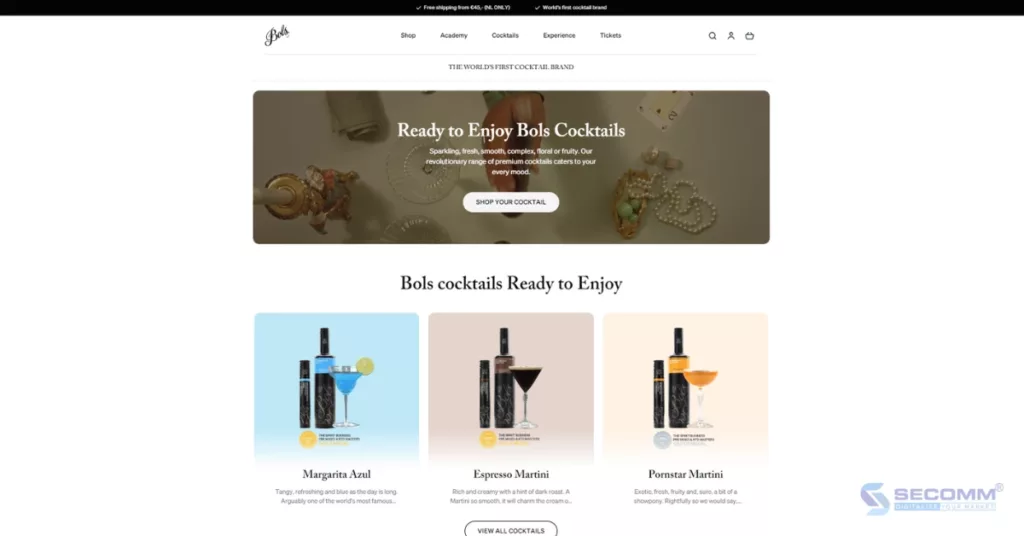
By deploying Headless Commerce on the Shopify Plus platform, Bols can flexibly customize the layout and design of the frontend interface, allowing customers to purchase cocktails, book events, buy event tickets, and register for mixology courses.
To date, Bols has built a community of over 20 thousand followers on Instagram and has integrated this social network into the website to share the latest cocktail recipes.
Victoria Beckham is known as an icon in the global fashion industry, and her talent and dedication are recognized by professionals and fans alike.
Victoria’s passion extends beyond fashion to the realm of beauty. Thus, in 2019, she co-founded the beauty brand Victoria Beckham Beauty.
The brand launched an eCommerce website with a focus on high performance, fast page loading speed, and smooth operation with a multilingual, multicurrency interface.
Therefore, Victoria Beckham Beauty decided to implement a Headless architecture, leveraging Shopify Plus Storefront API, Netlify hosting, combined with the Contentful Content Management System (CMS).
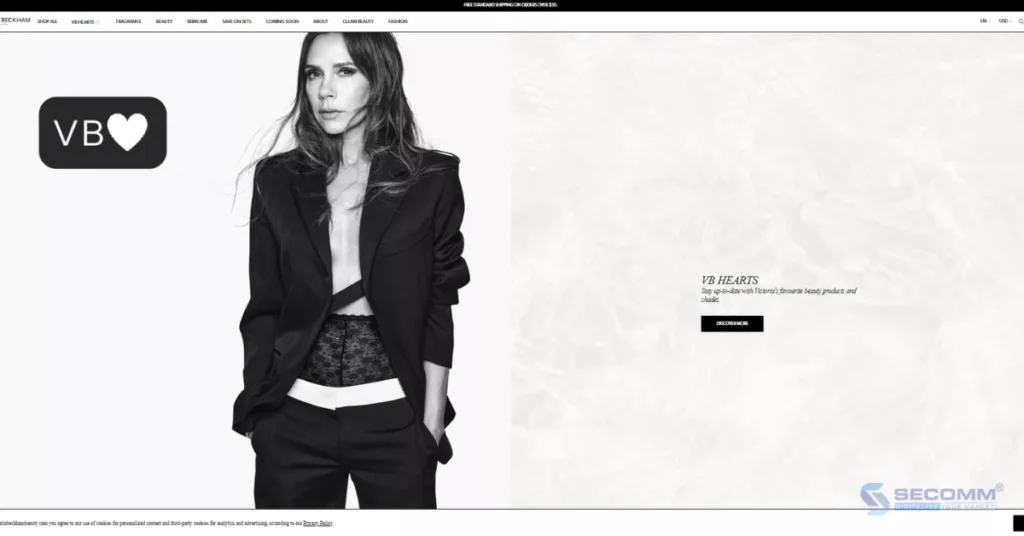
Shopify Plus assists this business in managing customers, orders, and inventory, and integrating multiple payment methods to provide a multi-currency experience. Meanwhile, Contentful provides outstanding CMS features to manage the rich data of Victoria Beckham Beauty.
Kotn was founded with a mission to set standards for creativity and conscious consumerism, designing clothing based on principles that ensure quality, honest value, and a positive impact on society.
After launching a Headless eCommerce website with Shopify Plus in 2014, the brand continued to expand its product portfolio to meet customer demands. To provide customers with an exceptional experience, Kotn adjusted its approach for future development.
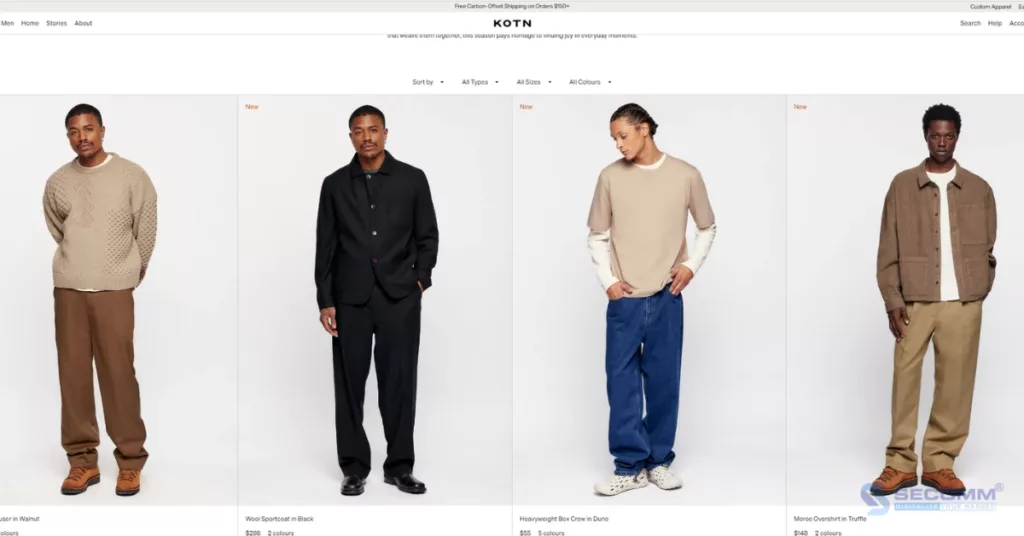
Kotn utilized the Shopify Storefront API to consolidate two stores into one, integrating with a new CMS system and customizing product pages and payment processes. This reduced the need for custom apps and related solutions, empowering staff to manage inventory, sales, and customer experiences more efficiently.
Paul Valentine is a brand specializing in crafting and offering timeless and elegant jewelry. In just 8 years since its establishment in 2015, Paul Valentine has officially become a reputable jewelry brand, serving hundreds of customers worldwide.
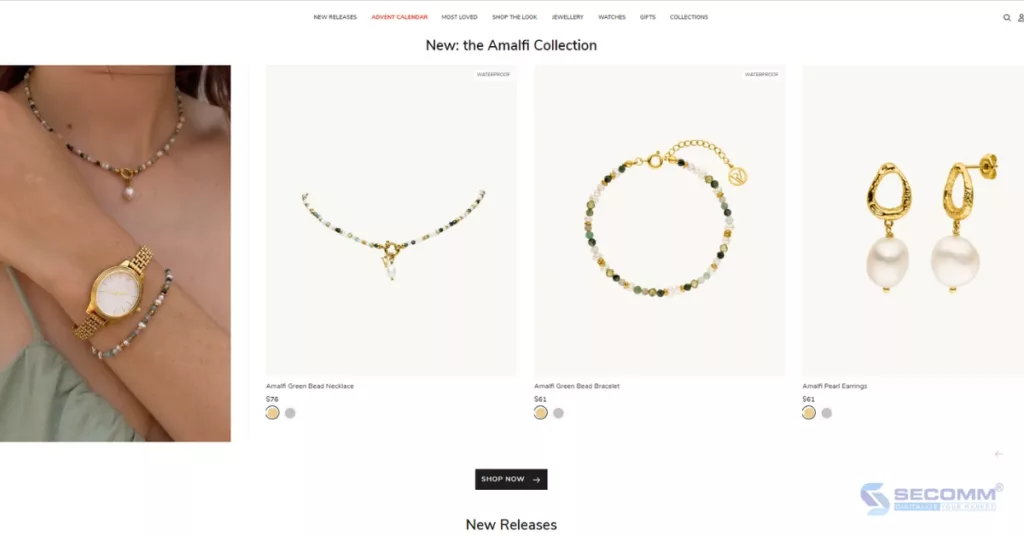
While the Paul Valentine website had previously been operated on Shopify Plus, a reset in its setup made content management across 12 local stores complex and less efficient.
Therefore, implementing the Headless architecture was deemed the most suitable approach to address this issue. Accordingly, Paul Valentine built a custom frontend interface using the Shopify Storefront API and the Vue.js framework.
Additionally, they integrated the Contentful system into the backend to unify content management and distribution across all stores.
This streamlined the management and operation of Paul Valentine’s eCommerce website, accelerated page loading speed, and ensured a smooth and consistent user experience.
Veloretti is a well-known bicycle brand from the Netherlands, specializing in the production and supply of high-quality bicycles and accessories. The introduction of their first modern electric bicycle prompted Veloretti to completely rebuild its eCommerce website.
While competitors focus on technology, Veloretti chooses to design its website with a strong emphasis on fashion and lifestyle, utilizing unique layouts and video content.
For non-electric bicycle product pages, Veloretti uses a bright theme, while a dark theme is employed for electric bicycle product pages, ensuring the provision of sufficient technical information without sacrificing the brand’s fashion and core values.
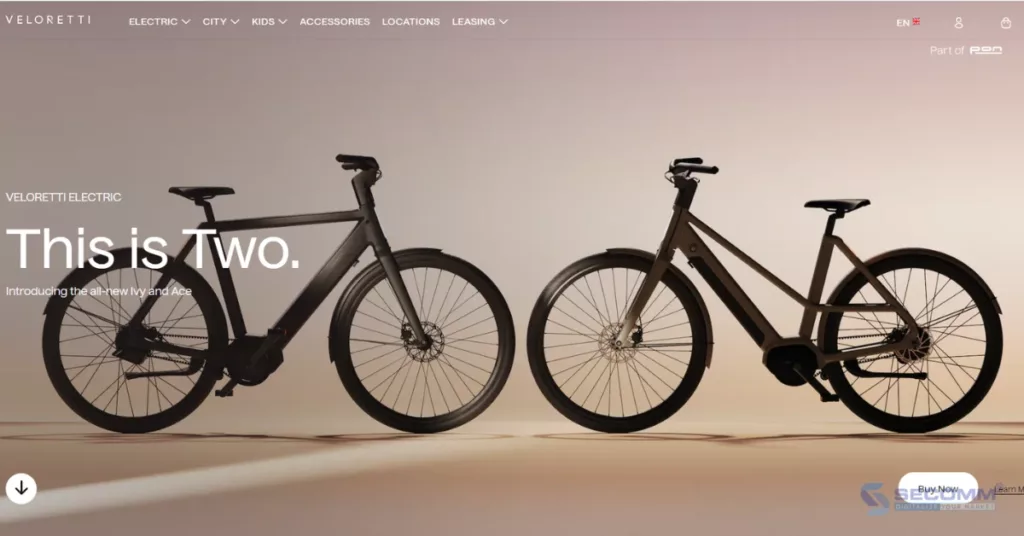
To achieve this, Veloretti has implemented the Headless architecture, with Shopify Plus serving as the backend platform. In addition, they use the Shopify Storefront API to connect the frontend and backend, facilitating easy and flexible access to data and functionality from Shopify.
Furthermore, Veloretti utilizes the React framework to build a custom frontend interface, providing customers with a unique and fashion-forward shopping experience.
BonLook is a renowned eyewear brand based in Montreal, with 37 branch stores across Canada. In addition to selling ready-made glasses, BonLook offers prescription lens-cutting services. Customers can upload their prescriptions, and choose lens materials, anti-blue light and anti-fatigue capabilities, frame sizes, and styles.
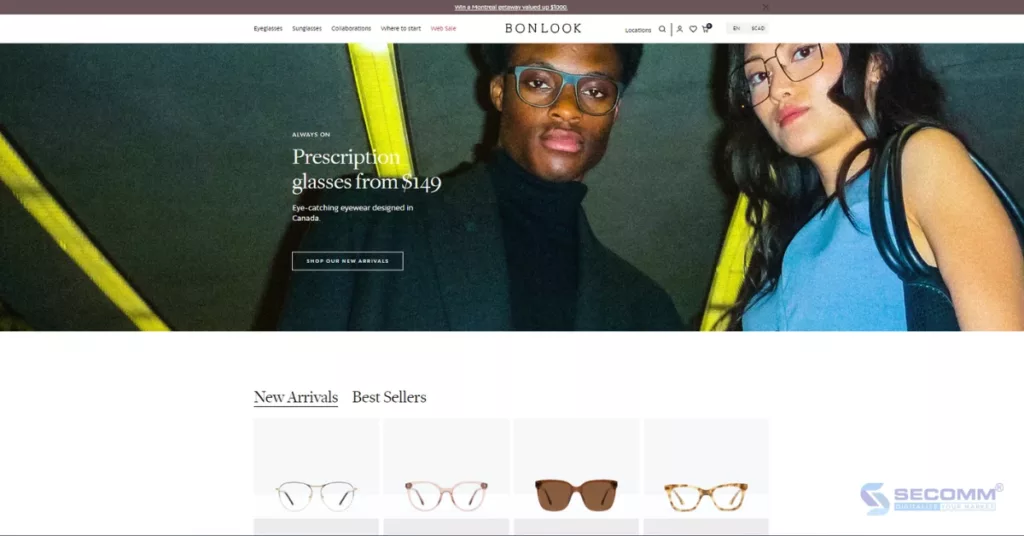
BonLook has developed a Headless omnichannel solution with Shopify Plus to provide a seamless shopping experience across various channels, from online to offline, incorporating unique features such as AR technology with “Virtual Try-On.” The brand also leverages applications within Shopify Plus Certified Apps to enhance conversion rates and foster loyalty through promotional programs and seasonal offers, attracting customers to return for more shopping.
Grass Roots is a cooperative of small-scale family farmers in the United States specializing in the production and sale of clean products such as pork, beef, chicken, lamb, and bone broth.
To provide users with the optimal online shopping experience, Grass Roots decided to implement a Headless Commerce solution on the Shopify Plus platform.
This allows Grass Roots to access the latest web technologies to create its unique customer experience with features such as
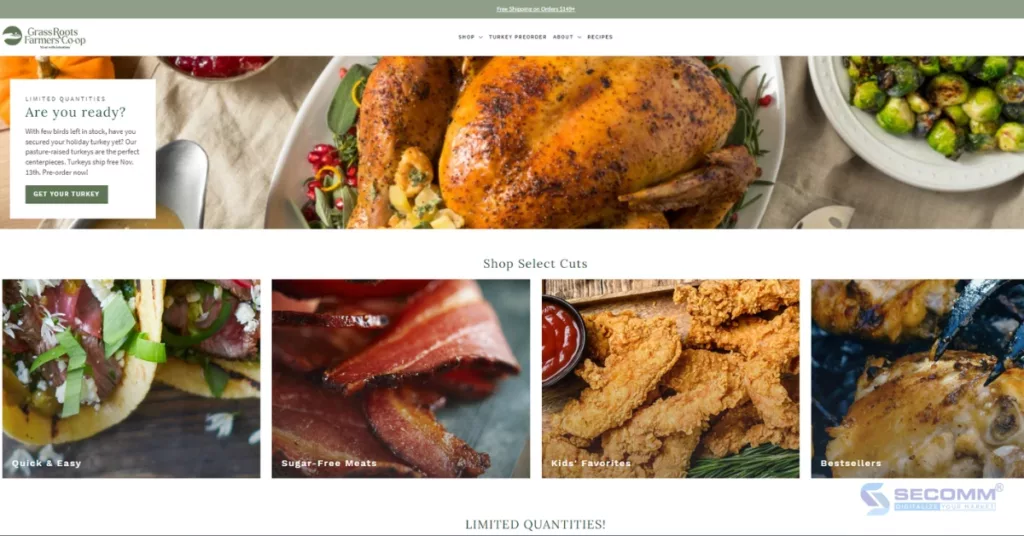
Go Headless with Shopify Plus today!
Here are specific examples showcasing the unique and engaging customer experiences of 15 brands across various industries when implementing Headless on the Shopify Plus platform.
With its outstanding customization and scalability capabilities, Shopify Plus is one of the preferred SaaS platforms for large enterprises considering the adoption of Headless Commerce models, thanks to optimal solutions like Storefront API, Hydrogen + Oxygen, and Commerce Components.
Over the years, SECOMM has become a reliable partner for many large enterprises such as Vinamilk and Suzuverse in establishing Headless architectures for eCommerce websites. We take on the roles of consulting, planning, and accompanying businesses in building Headless Shopify Plus websites through each stage.
Contact SECOMM or call directly on the hotline (028 7108 9908) to start your Headless deployment project with Shopify Plus today!
 2
2
 5,953
5,953
 0
0
 1
1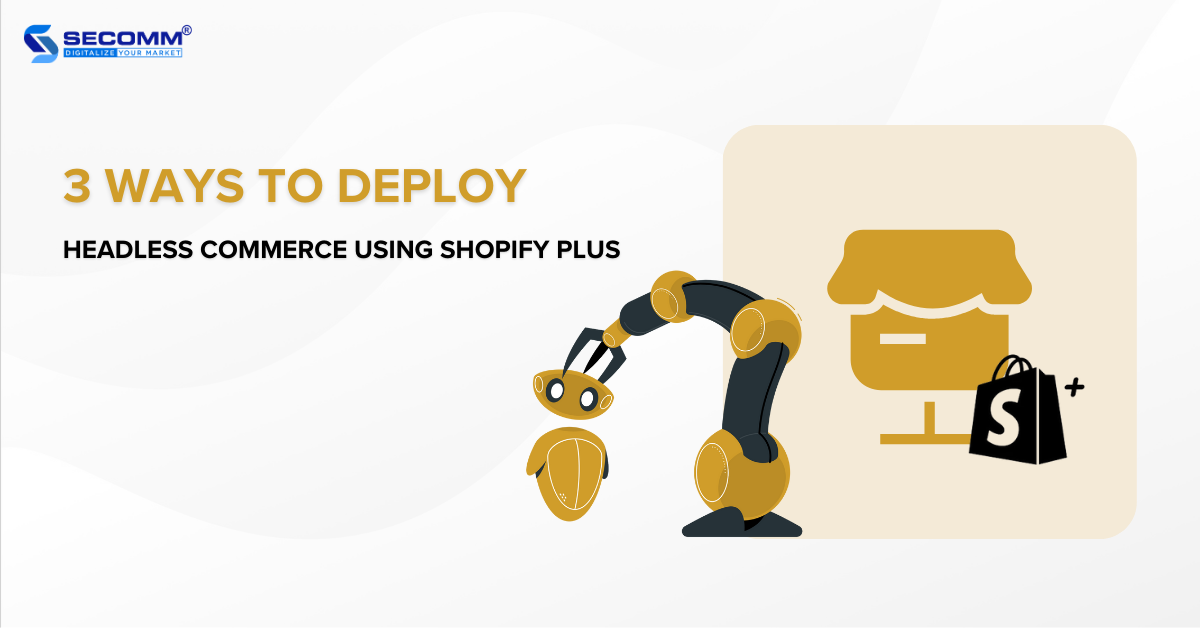
Freedom in creativity and technical flexibility have ushered eCommerce into a new era with the Headless Commerce trend. In this scenario, Shopify Plus shines with its exceptional solutions that have positioned numerous businesses at the forefront of this trend.
Learn more: Brands go Headless with Shopify Plus
The combination of Shopify Plus infrastructure and the Headless architecture opens up various ways for businesses to create unique and customizable shopping experiences for their customers. Below are three common methods for implementing Headless Commerce with Shopify Plus.
The Shopify Storefront API is a GraphQL-based API – a query language for APIs. It enables businesses to connect the frontend of their website to the backend of Shopify, facilitating easy access to data and eCommerce functionalities. Therefore, businesses can use the Storefront API to create unique and personalized customer experiences across various digital channels.
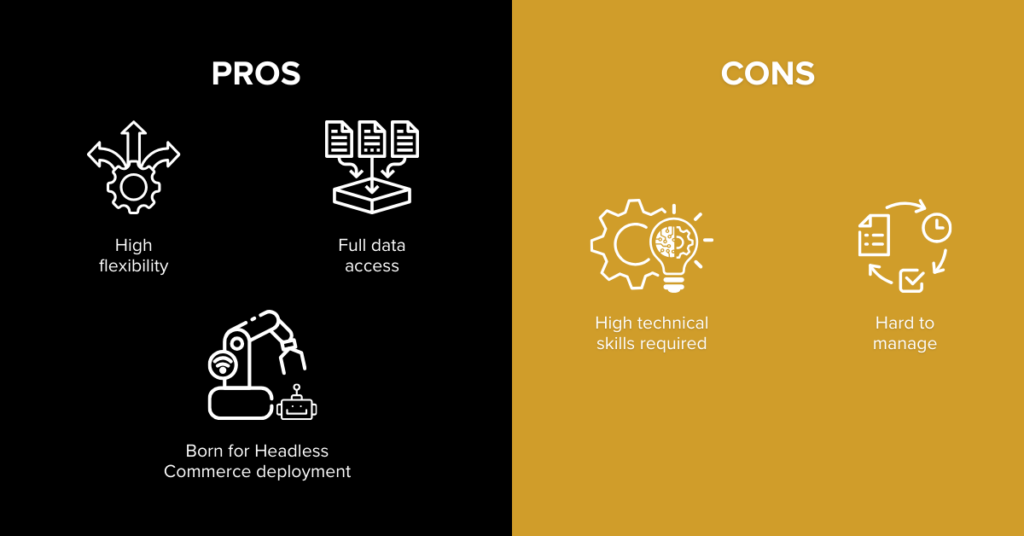
High flexibility: The Storefront API allows you to create independent websites. Instead of adhering to the constraints of pre-built themes, you can flexibly design product pages, homepages, and shopping carts in a style that accurately reflects your brand. The Storefront API also ensures flexibility in integrating with third-party systems while easily adapting the website to embrace new design trends.
Full data access: Through the Storefront API, you can access every aspect of the Shopify Plus database, including detailed information about products, orders, and customer data. This helps manage, monitor, assess trends, and optimize eCommerce data accurately.
Born for Headless Commerce deployment: Embracing the Headless Commerce model, which decouples the frontend and backend, allows for significant flexibility in eCommerce development and operations. The Storefront API is strategically optimized to seamlessly connect Shopify Plus’ backend with diverse frontends, ensuring a cohesive user experience across various channels and devices.
High technical skills required: Deploying Headless Shopify Plus using the Storefront API is a complex process that demands in-depth knowledge of the Shopify Plus platform, programming languages, and frameworks, as well as problem-solving skills to quickly address technical requirements. Particularly, you need to understand the data structure of Shopify, including how customer data, product information, and transactions are organized and stored within the system.
Hard to manage: The flexibility of the Storefront API complicates the process of managing and maintaining the system. While the flexibility of the Storefront API allows to customize every aspect of the eCommerce website, from the homepage to the checkout process, these custom configurations need to be well-managed. When there are too many custom configurations, updates may lead to compatibility issues within the overall system.
The Shopify Hydrogen + Oxygen solution was introduced in 2021, and designed for large enterprises implementing Headless Commerce with Shopify Plus. Specifically, Hydrogen is a React-based framework – a popular framework for building user interfaces, enabling businesses to construct unique and visually appealing storefronts.
On the other hand, Oxygen is a global hosting solution capable of storing custom content. Shopify Oxygen is backed by Shopify’s infrastructure with over 100 server locations positioned worldwide. You don’t need to worry about finding third-party hosting providers or managing technical issues.
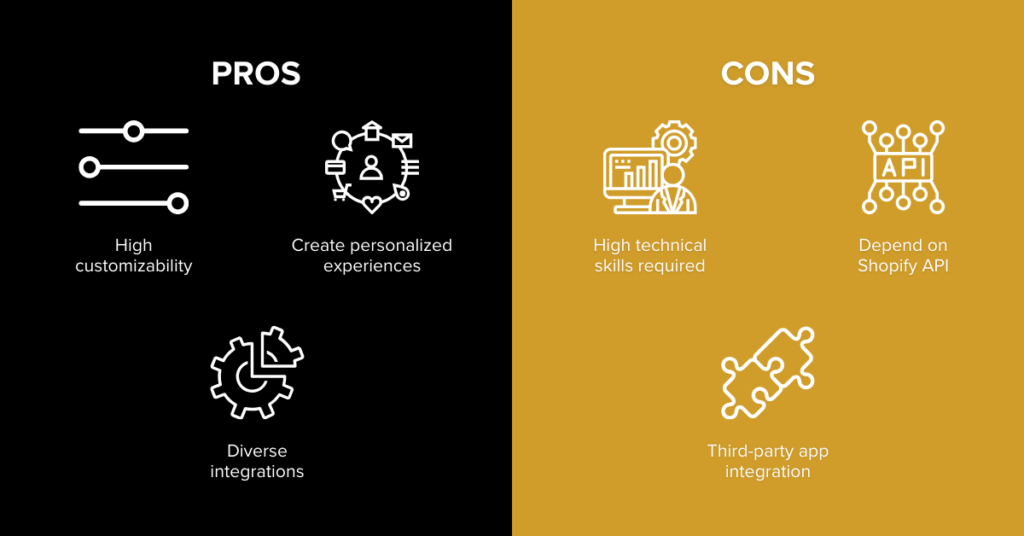
High customizability: Shopify Hydrogen allows you to customize the Headless website interface and implement necessary extensions. This means that merchants can use the latest technologies to build a Headless eCommerce website without worrying about impacting the system’s functionality.
Create personalized experiences: The Shopify Hydrogen solution offers high flexibility and customization, enabling you to implement Headless Commerce with this solution to easily create and deliver personalized shopping experiences for customers.
Diverse integrations: To help you create a seamless omnichannel experience, Shopify provides the capability to integrate the Headless Hydrogen website with various third-party applications such as Klaviyo, Gorgias, etc., as well as Headless CMS systems like Contentful, Sanity, Builder.io, etc.
High technical skills required: Shopify Hydrogen is a technically intensive solution and doesn’t have a drag-and-drop builder. Therefore, the process of implementing Headless Commerce with Shopify Hydrogen will demand a high level of technical expertise from the business.
Depend on Shopify API: This solution is developed exclusively for Shopify’s API. This means that the Hydrogen framework can only be used to build the Shopify website interface.
Third-party app integration: While Shopify allows you to easily integrate with 3rd-party apps and CMS, if you want to use a CMS or app for your online store that isn’t compatible with the Hydrogen framework, you’ll need to integrate it through a middleware app.
The third method to adopt Headless Commerce with Shopify Plus is by using Shopify’s latest solution – Commerce Components. This is a modular component tech stack developed by Shopify specifically for large enterprises aiming to build Headless eCommerce websites. Shopify Commerce Components offer 30 components, encompassing core features across various business aspects such as Cart, Checkout, Data, Shipping, and more.
You can integrate these components based on deployment needs to create a customized solution for your Headless Shopify website. Since its launch, many world-leading businesses, including Mattel, JB Hifi, Glossier, Coty, Steve Madden, Spanx, and Staples, have utilized this new tech stack from Shopify.
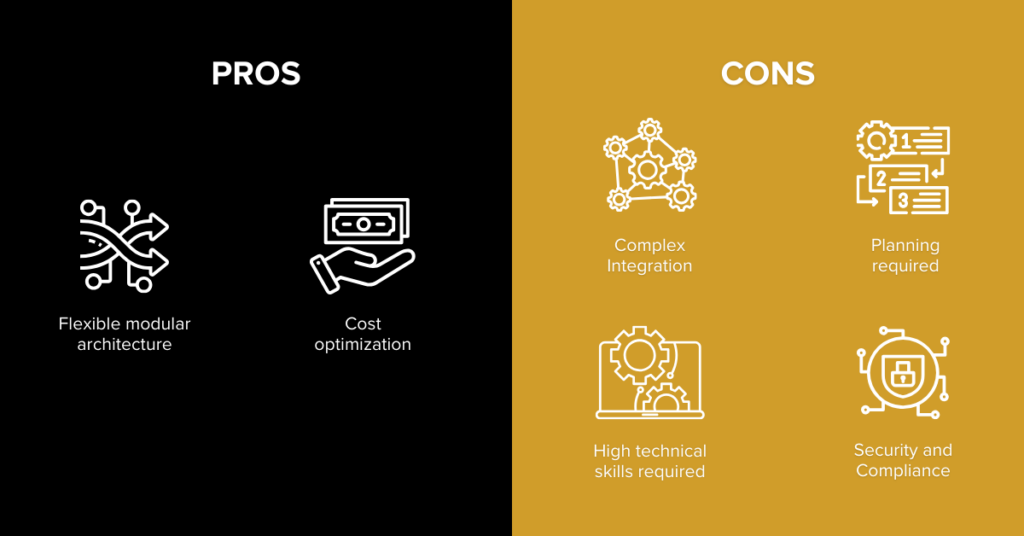
Flexible modular architecture: Commerce Components with a modular architecture provide unlimited API connections. This means you can integrate and use an unlimited number of components, while also easily adding, removing, and customizing these components without fear of affecting the system.
Cost optimization: Commerce Components have a pricing model based on the number of components used, meaning businesses pay for exactly what they use. Additionally, the cost of Commerce Components is billed annually, making it easier for businesses to accurately predict the fees they will incur.
Complex Integration: The process of integrating multiple components can be complex and time-consuming. Businesses need to ensure that the components operate independently and seamlessly within the same system efficiently.
Planning required: To ensure the effective operation of the components on the system, you need to meticulously plan which eCommerce components will be integrated, choose suppliers, deployment solutions, and deployment stages.
High technical skills required: Building and maintaining a Headless website system using the Commerce Components solution will demand a certain level of technical expertise and knowledge of integration and technology. You can invest in developing an in-house technical team or collaborate with highly specialized agencies.
Security and Compliance: Each provider for each eCommerce component will have its security protocols and compliance rules. You must ensure compliance with these rules when integrating their components, while also ensuring that this compliance doesn’t impact the operation of the remaining components and the entire system.
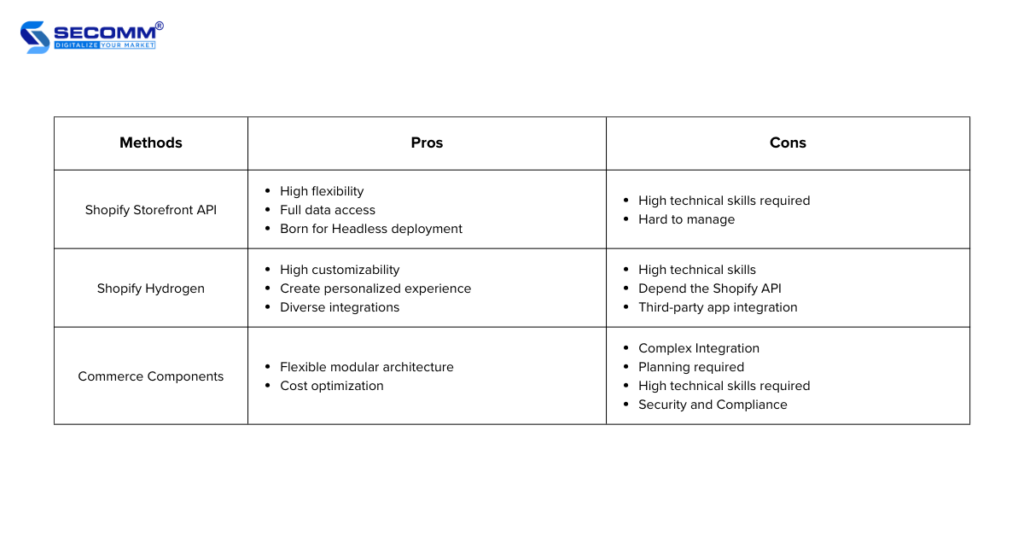
Choose your best-fit Headless Commerce deployment!
On the journey of building a Headless eCommerce website with Shopify Plus, choosing the deployment method is a crucial decision to ensure system flexibility and performance while providing the optimal customer experience.
If you need detailed guidance or want to explore how Shopify Plus can support your Headless deployment strategy, please contact SECOMM or call directly at (+84)28 7108 9908 to receive advice and assistance from our experts in choosing the right Headless Shopify Plus deployment method for the business model and goals.
 2
2
 2,935
2,935
 0
0
 1
1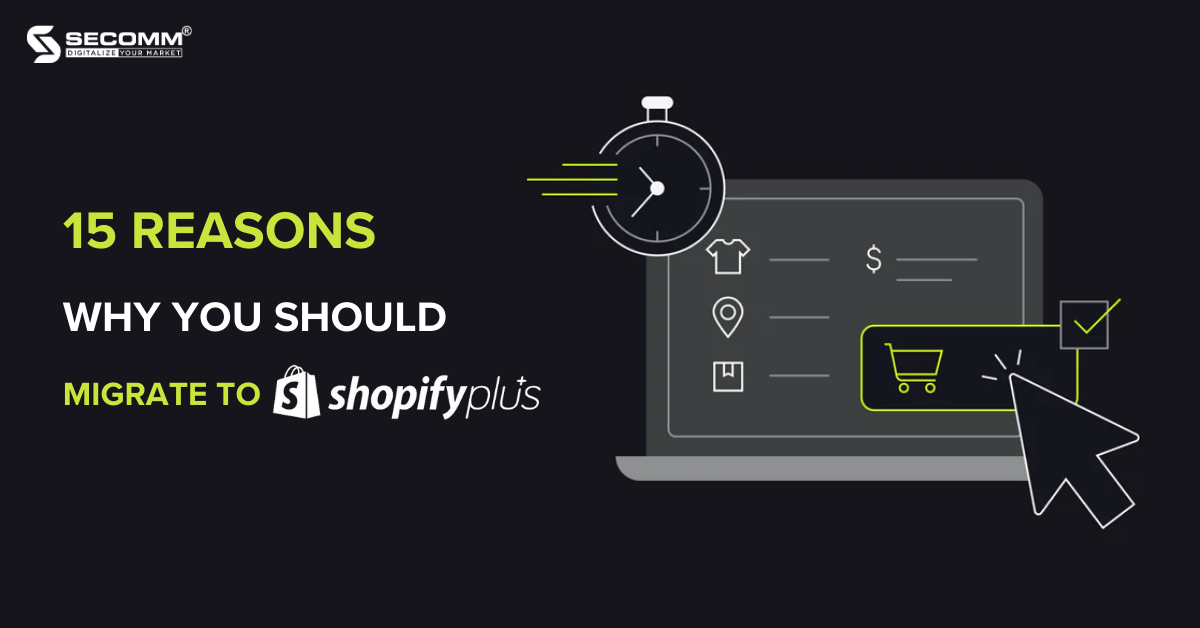
According to the Deloitte 2022 Retail Industry Outlook, up to 67% of businesses acknowledge that the eCommerce platform is their top investment priority due to issues they face with deploying outdated platforms.
Plus, a survey by Digital Commerce 360 revealed that about 27% of businesses are trying to switch their eCommerce platforms despite the associated costs.
Among the myriad of leading platforms today, Shopify Plus stands out as a perfect choice for businesses when deciding to re-platform.
This article will show you 15 reasons why you should migrate to Shopify Plus. Why the platform gains the attention of business leaders and how it can be the key to your development and success in today’s eCommerce landscape.
It is a premium solution of the popular eCommerce platform – Shopify. This version is specifically designed to meet the needs of large businesses with a high investment budget for eCommerce.
It offers flexibility, scalability, and integration, not only helping efficiently build and run an eCommerce website but also providing advanced tools and features to optimize the customer shopping experience.
Here are 15 notable advantages that the platform offers for your business growth, laying the groundwork for you to consider migrating to Shopify Plus.
The dashboard interface is designed to be intuitive and user-friendly, catering to end-users and administrators who directly manage the Shopify store. The intuitive interface allows you to concentrate on developing business strategies and enhancing the customer experience, minimizing the learning curve on how to use the system.
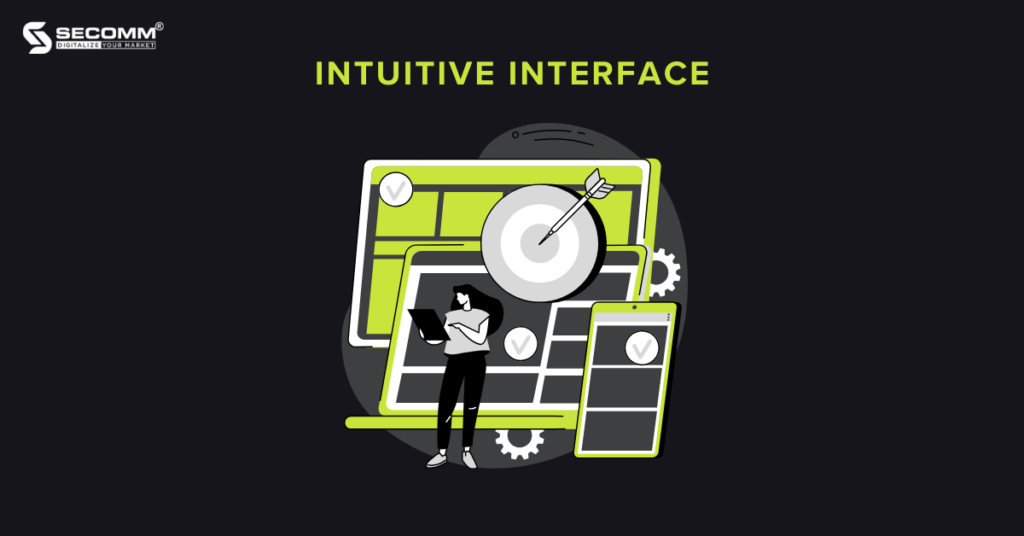
The second reason to migrate to Shopify Plus is the transparency in estimating and managing deployment costs. Typically, when using this platform, you may consider platform fees, transaction fees, app and add-on fees.
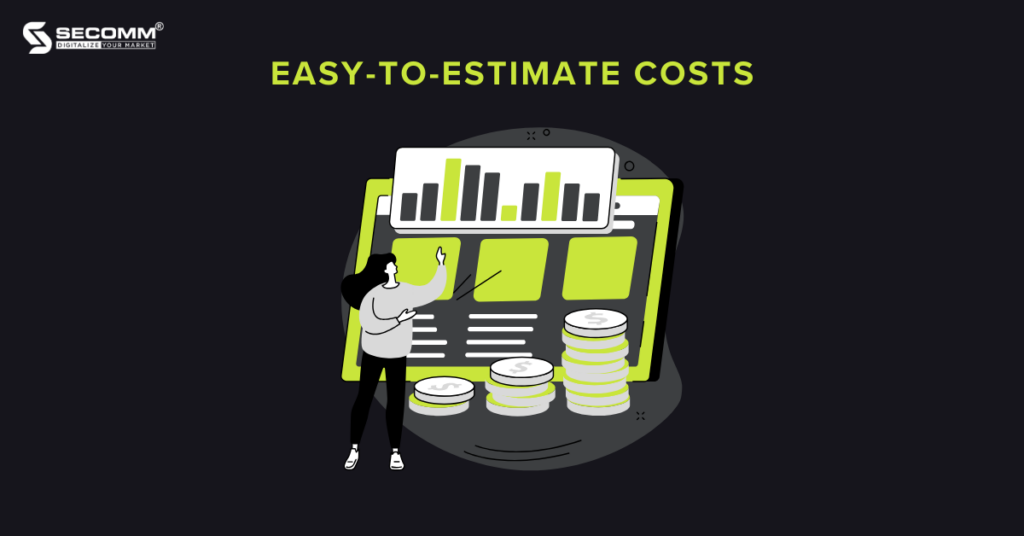
The Shopify Plus pricing system is clear and understandable, helping you know all the fees you need to pay monthly. This helps financial planning, avoiding unexpected fees during the deployment process.
Plus, if you partner with highly specialized technical development teams like SECOMM, we’ll conduct a detailed analysis and propose a phased deployment plan for the Shopify Plus eCommerce website. This approach allows you to gain clarity on how your system will be deployed at each stage, facilitating easy adjustments and flexible optimization of financial resources.
Another advantage of Shopify Plus is the automation feature. The platform provides two exclusive tools to help you facilitate this process: Shopify Flow and LaunchPad.
These automation tools help enhance efficiency and save time by streamlining various processes, allowing you to focus on strategic aspects of your operations.
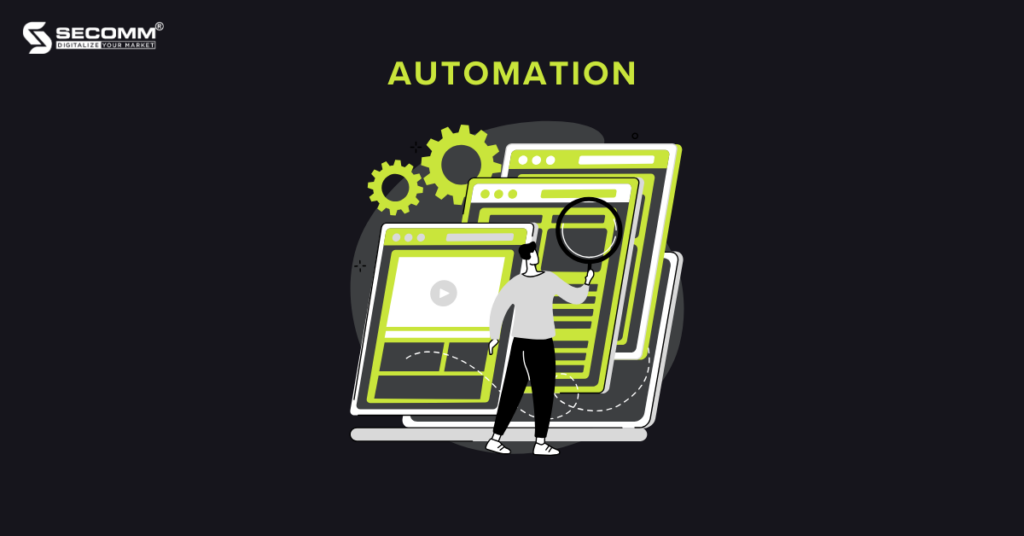
Shopify Plus allows you to reach a broader audience through various sales channels, spanning from offline to online, including leveraging social media for sales and implementing B2B business models.
Plus, you can integrate the Shopify POS solution into their offline stores to offer services such as BOPIS (Buy Online, Pick Up In-Store) and BORIS (Buy Online, Return In-Store). This allows customers to shop in the manner that suits them, combining both online and in-store shopping experiences.
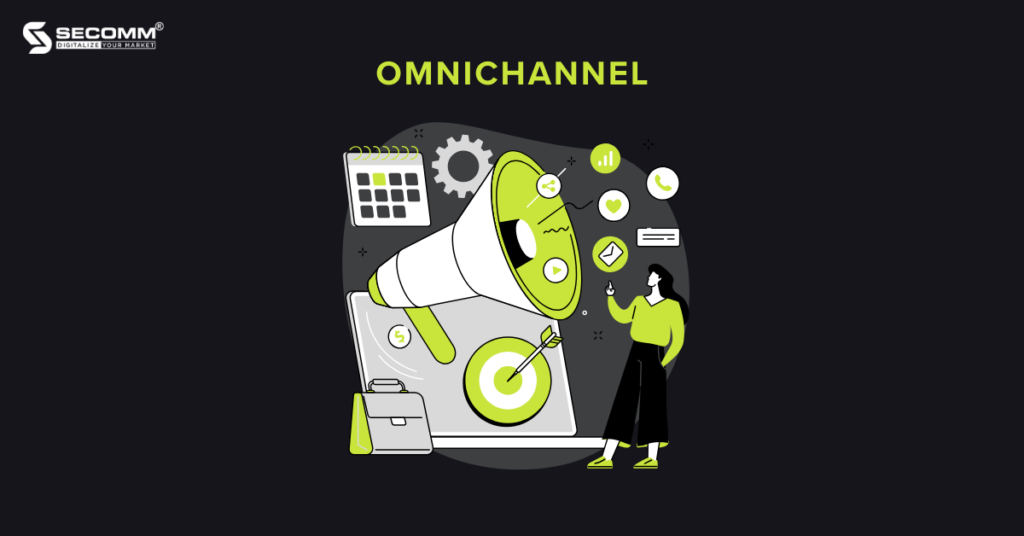
In 2021, Shopify introduced a comprehensive cross-border selling solution called Shopify Markets. With Shopify Markets, you can easily customize their stores for each specific target market. This includes setting prices, languages, payment methods, and delivery options to align with the preferences of local customers.
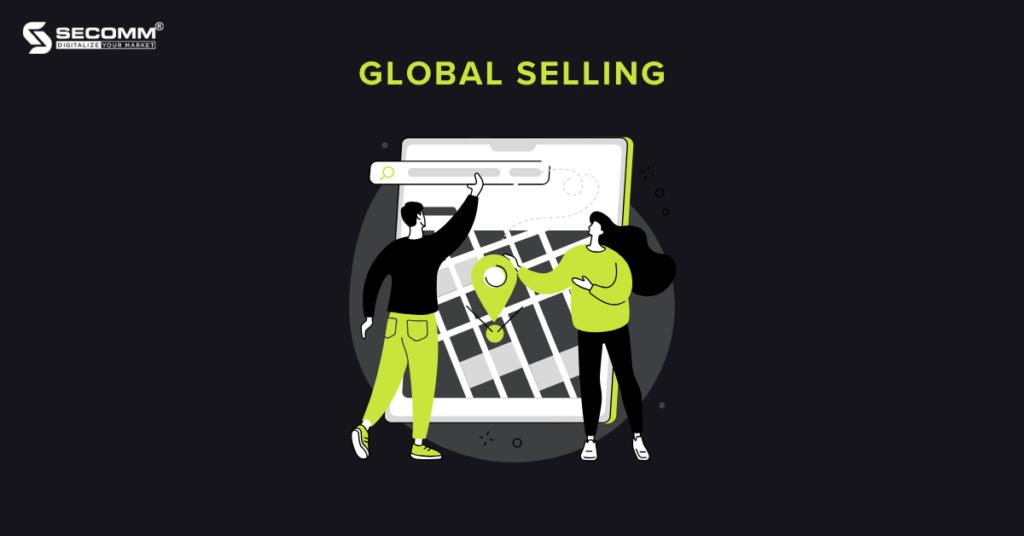
The robust customization is another reason for businesses to switch to Shopify Plus. This platform allows you to freely customize from the frontend to the backend without being constrained by any limits. In particular, you can easily customize the backend with Shopify Functions and Function APIs. Some use cases for Shopify Functions include:
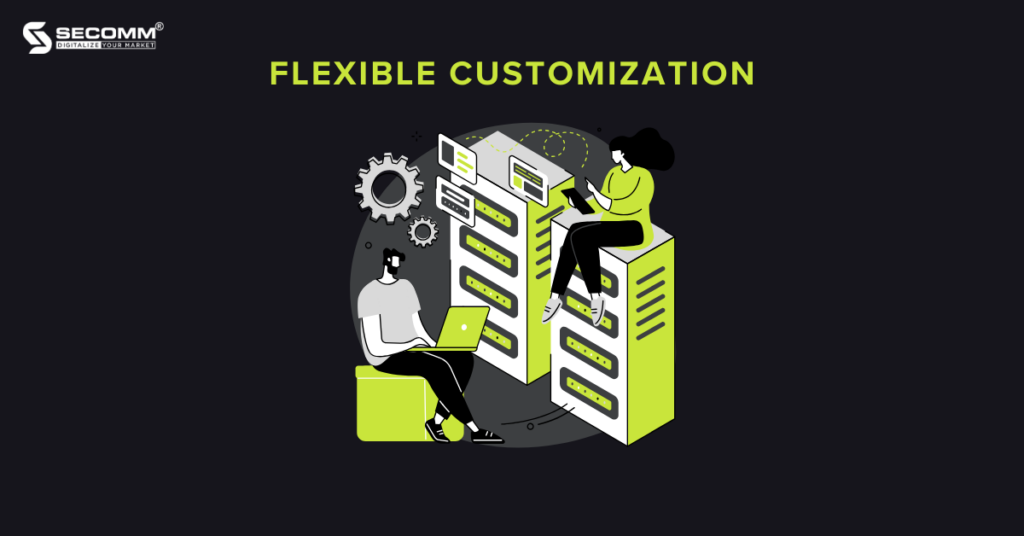
With the popularity of Shopify and Shopify Plus globally, it’s not surprising that Shopify owns a host of useful applications, some of which are specifically developed for businesses deploying Shopify Plus. Moreover, the ‘Plus’ provides diverse documentation and resources (Shopify Plus Certified App Program) for developers to create applications and extensions, contributing to the vast ecosystem of Shopify applications.
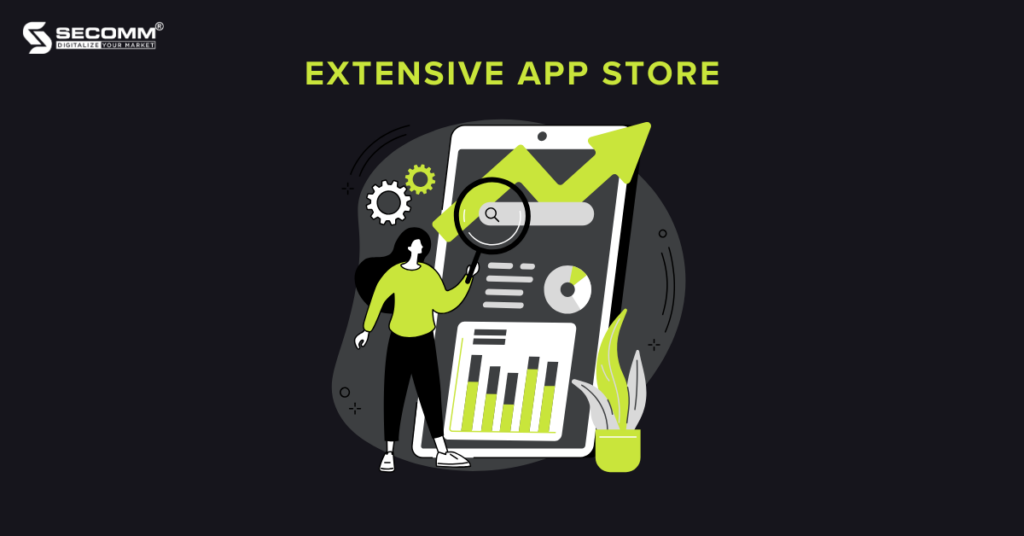
Beyond integrating with solutions within Shopify, you can also integrate with third-party systems such as:
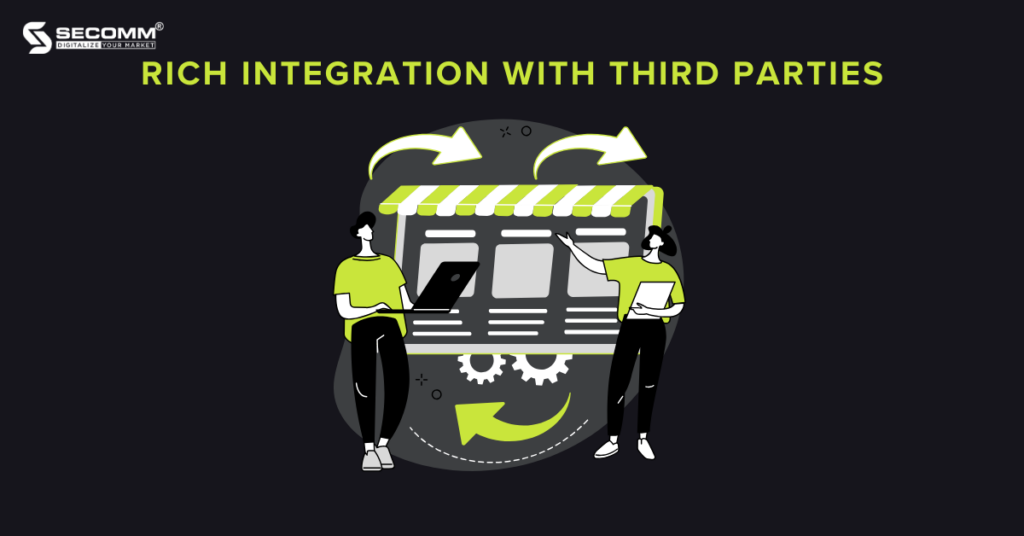
Shopify’s cloud infrastructure can cater to over 600,000 merchants and process speeds of up to 80,000 requests per second during peak periods. This system is built on a dedicated server cluster running Docker and utilizes Rails applications, alongside integrated additional features based on the AWS platform.
Therefore, Shopify Plus can provide powerful processing speed not only for the website but also during the checkout process. It can handle a massive number of visits while maintaining speed and ensuring a positive customer experience, processing over 10,000 orders per minute.
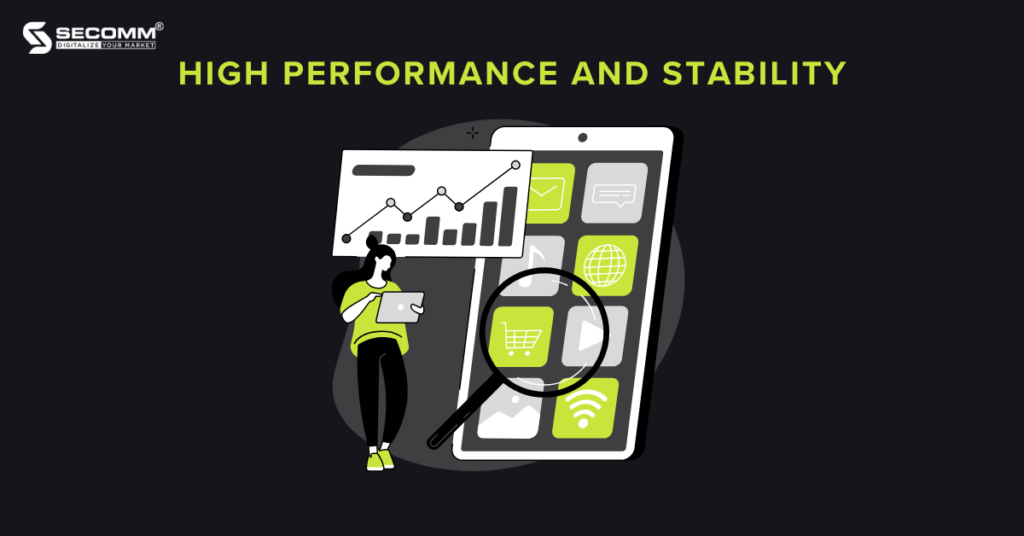
With unlimited bandwidth and flexible infrastructure, Shopify Plus can effortlessly scale to manage increased traffic during peak shopping seasons such as Black Friday, Cyber Monday, and Christmas. This enables you to handle high volumes of customers during peak times without concerns about technical issues or website disruptions.
The flexible customization of Shopify Plus also extends to providing maximum support for deploying Headless Commerce. Moreover, in 2021, the platform introduced the Hydrogen solution – an outstanding tech stack that can meet the highest requirements for building a Headless Commerce system.
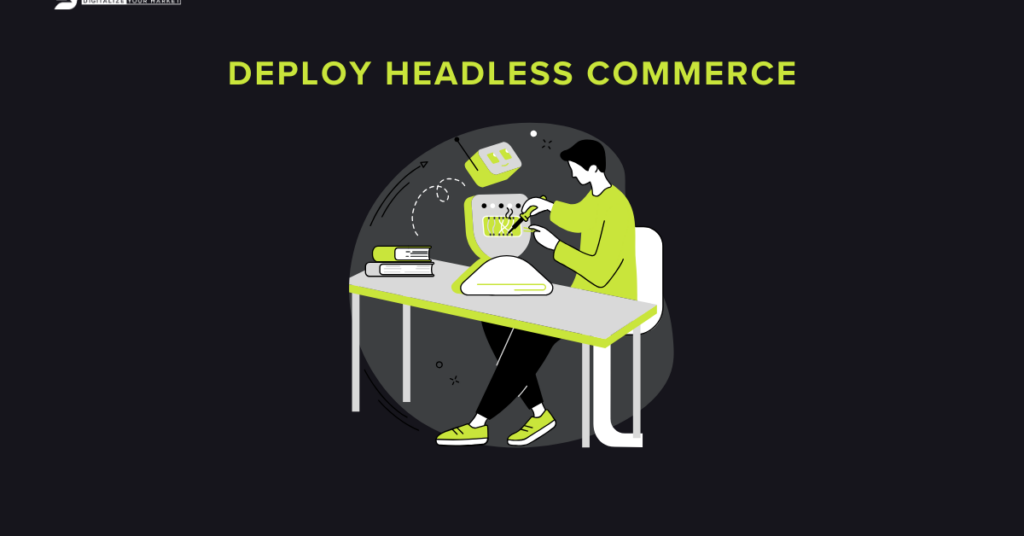
As the demand for flexibility and scalability continues to rise, alongside Headless Commerce, large businesses worldwide are increasingly focusing on the Composable Commerce model. Fortunately, Shopify is keenly attuned to customer needs and has recently introduced the Commerce Components by Shopify solution in early 2023.
As of the time of writing, Shopify stands as the first SaaS platform to provide a tech stack that can address nearly all the development needs of Composable Commerce.
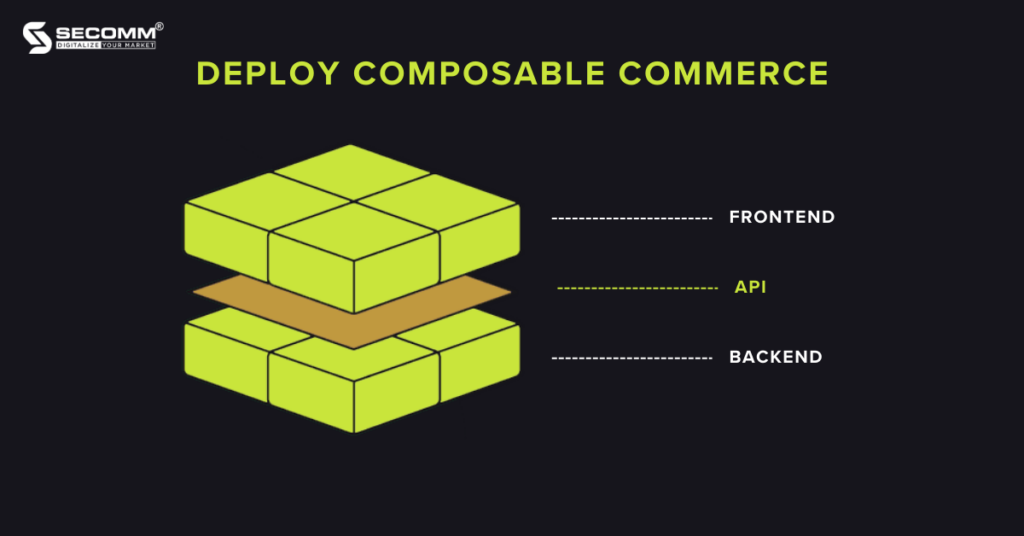
While you may require considerable time to tailor your Shopify Plus store to your specific needs, the nature of SaaS ensures that the go-live process for Shopify Plus remains quicker compared to open-source platforms like Magento.
On average, the deployment and go-live time for the Shopify Plus platform is around 2-5 months, whereas with Magento, businesses take from 6-12 months to deploy and go live.
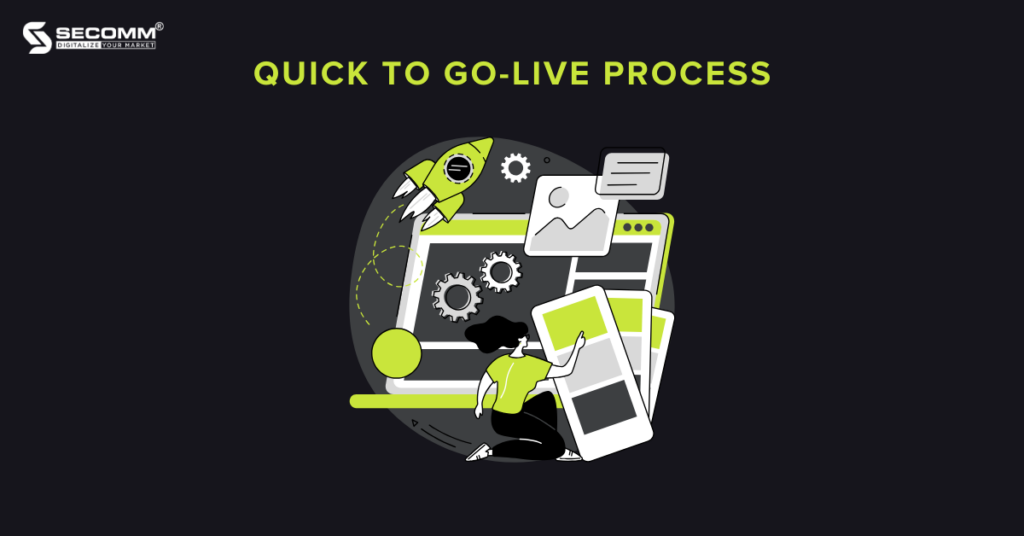
Shopify Plus provides a range of security measures and features to ensure that business data, customer information, and payment transactions are safeguarded to the highest extent possible. This includes:
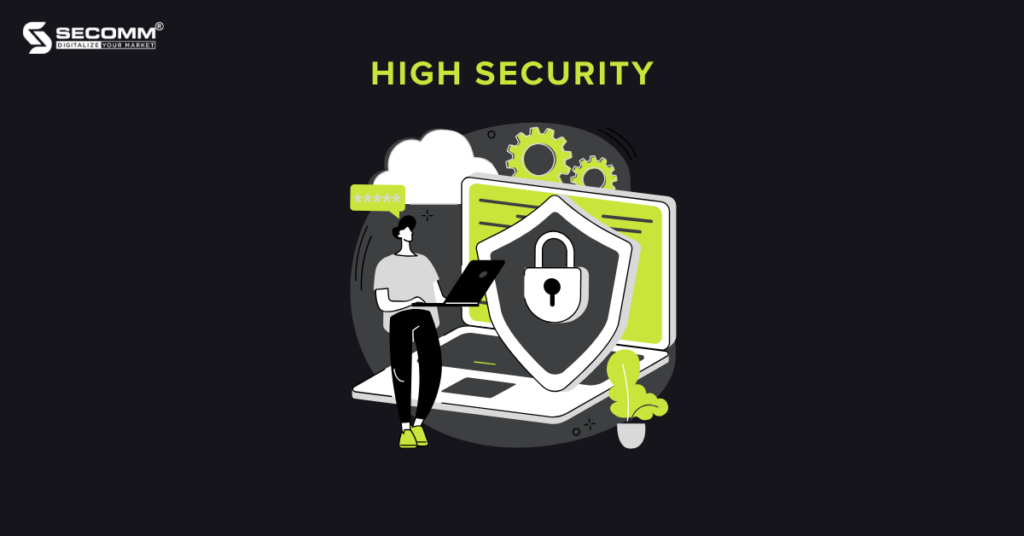
Similar to other eCommerce platforms, Shopify Plus provides businesses with 24/7 support through hotlines, emails, and video calls in various languages. Additionally, this platform offers instructional materials, API documentation, and the Shopify Plus Merchant Success program where businesses can access:
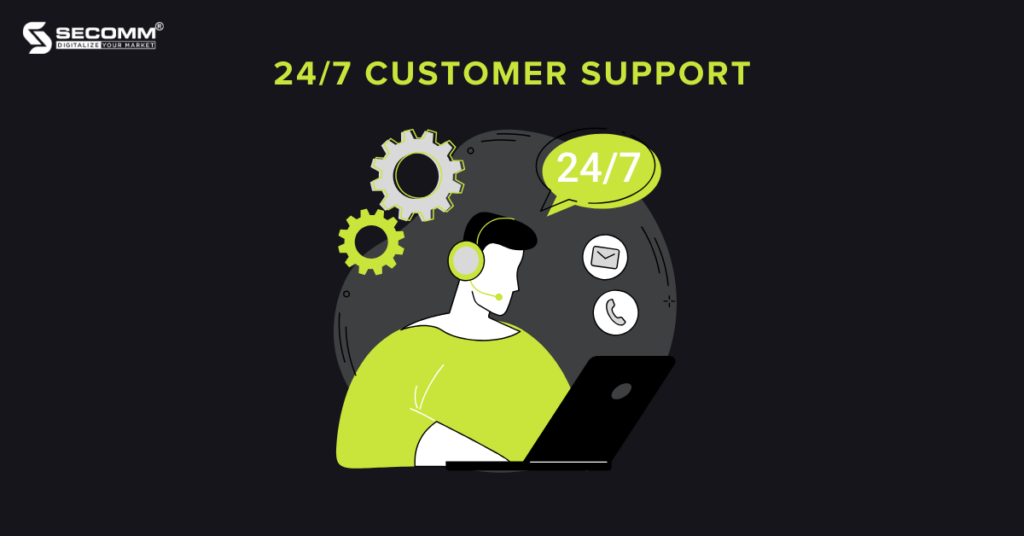
Shopify Plus has a vast and diverse user ecosystem, including businesses, developers, and marketing experts. With numerous leading global businesses choosing Shopify Plus as a key tool to drive their growth and success, it is undoubtedly a testament to the excellence of this platform.
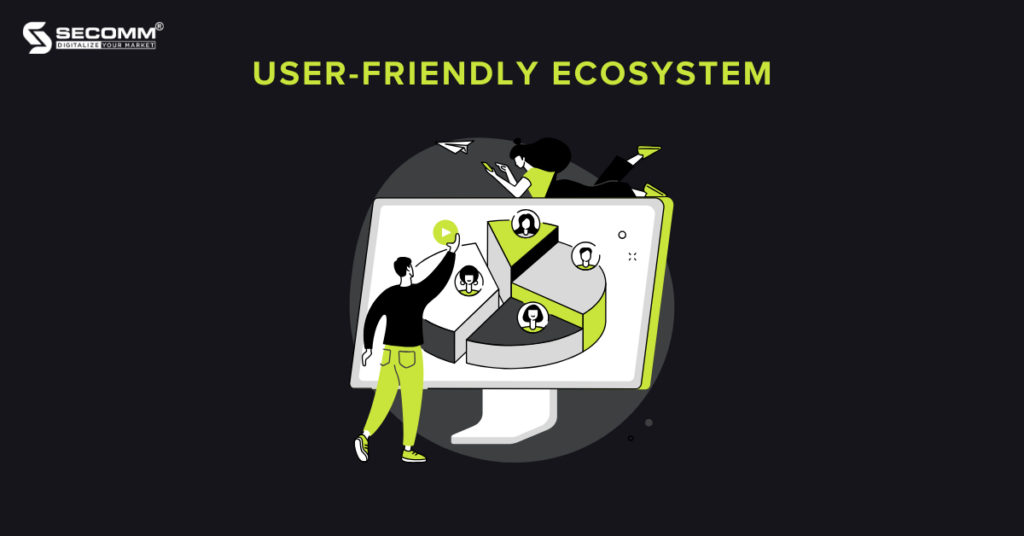
Renowned names such as Gymshark, Glossier, MZ Wallace, and Emma Bridgewater have leveraged the power of Shopify Plus to create customized shopping experiences, expand sales volumes, and reach a broader customer base. Their presence has added another reason encouraging you to switch to Shopify Plus.
With flexible customization, scalability, and support from a reliable team of experts, the decision to deploy eCommerce with Shopify Plus or migrate from another platform to Shopify Plus has been right for sustained and competitive growth in the eCommerce landscape.
Contact SECOMM or call the hotline at 028 7108 9908 for advice and support to swiftly and effectively switch to Shopify Plus.
 2
2
 6,514
6,514
 0
0
 1
1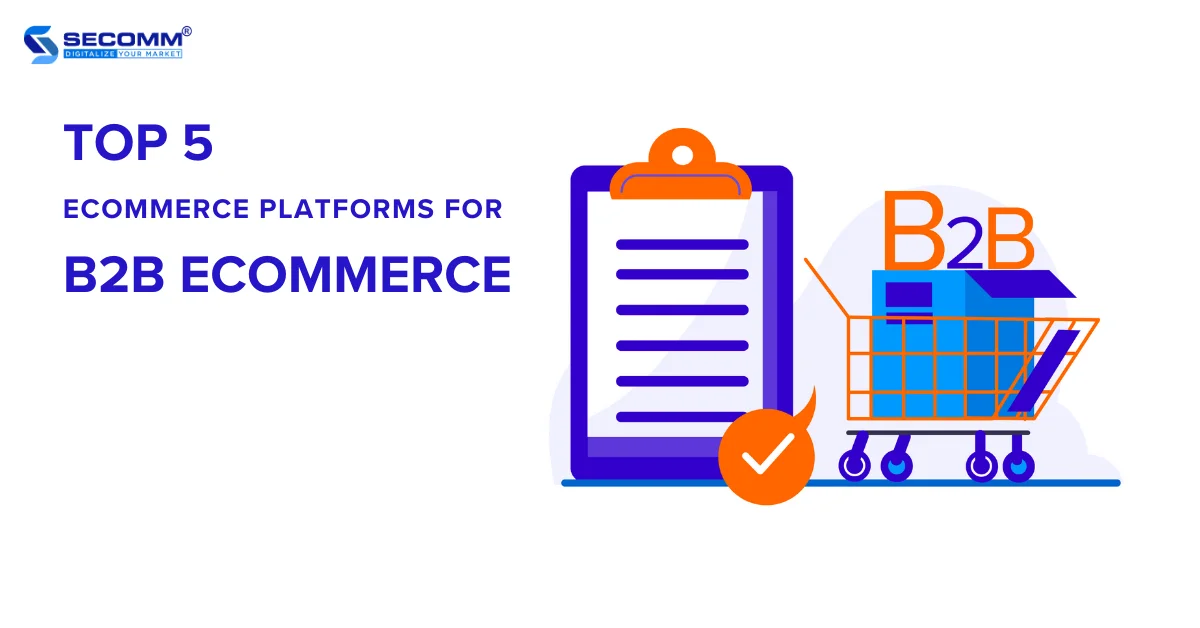
The global B2B eCommerce market is expected to reach $18.771.4 trillion by 2027.
According to McKinsey & Company, B2B enterprises are expanding their touchpoints in eCommerce, with 80% making online channels perform better than offline channels.
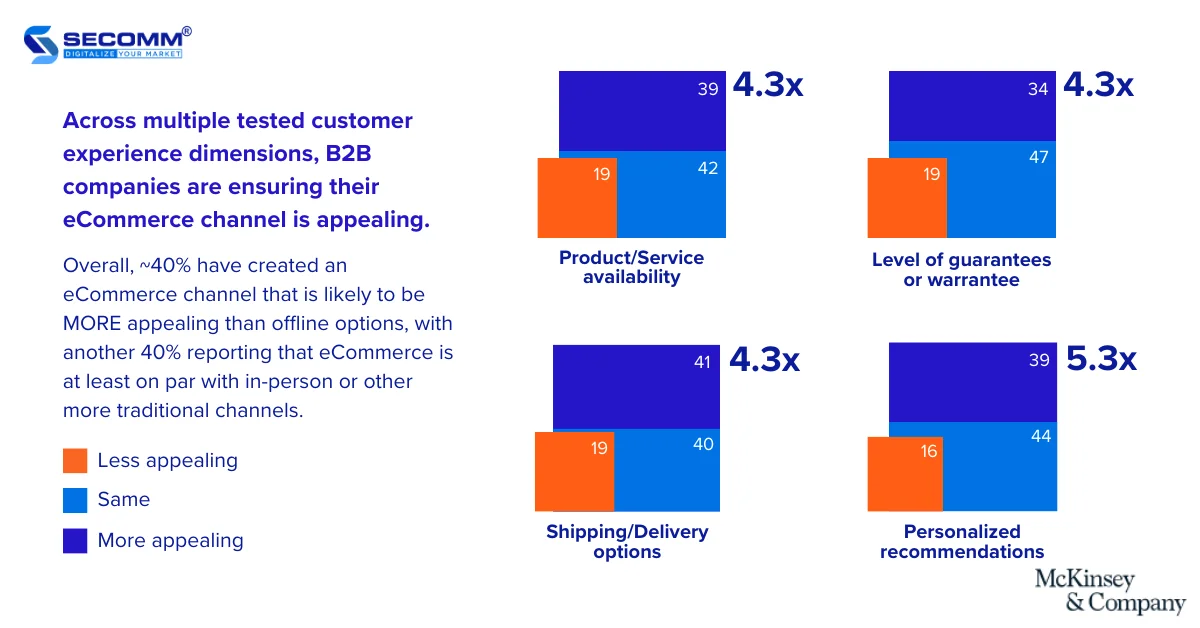
Therefore, B2B eCommerce is a rapidly growing market, with projected sales expected to reach 12.2 trillion USD by 2023. To succeed in this market, businesses always need a robust eCommerce platform.
It is crucial for businesses to clearly define the specificities and considerations of B2B eCommerce before deciding on which eCommerce platform to implement.
Specifically, Business-to-Business (B2B) eCommerce involves commercial transactions between businesses. As a result, B2B eCommerce has distinct characteristics compared to Business-to-Consumer (B2C) eCommerce, namely:
To succeed in B2B eCommerce, businesses need to take note of the following considerations:
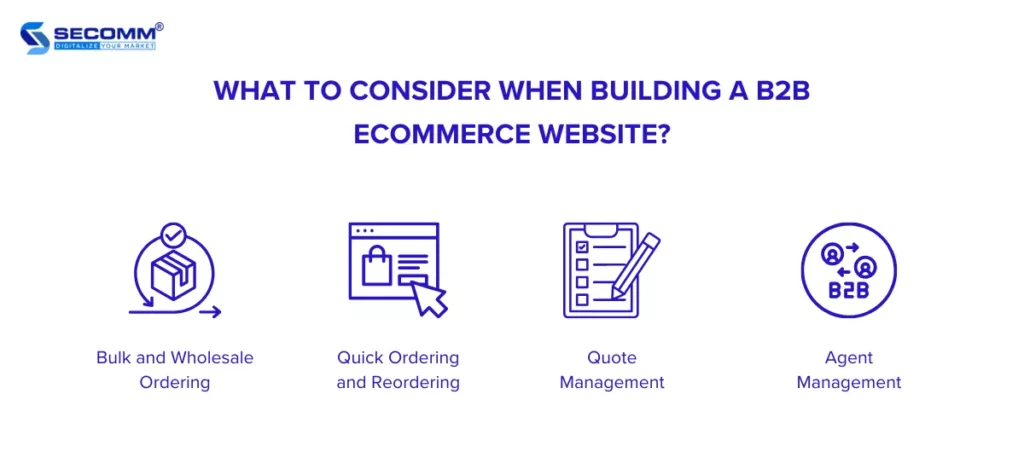
Bulk and wholesale ordering are crucial factors in the revenue of B2B businesses. The quantity and pricing can vary for each business depending on the customer group and the purchased product categories.
To efficiently handle these orders in B2B eCommerce, businesses need to use order management systems and establish clear, detailed, and appropriate order processing workflows.
The feature of quick ordering is often provided by B2B eCommerce platforms, allowing customers to create and place orders with just a few clicks. Quick ordering can be implemented through various methods, such as:
Unlike individual customers, B2B customers often repeat purchases of specific product categories in seasonal quantities. Therefore, B2B businesses should also incorporate a feature to remember previous orders for quick reordering.
Quote management in B2B eCommerce is a crucial process that helps businesses provide accurate and timely pricing information to customers, ultimately increasing sales and improving profits.
Specifically, in quote management, negotiating prices with multiple quote versions or from different suppliers is an important part of many B2B eCommerce models, allowing businesses to negotiate prices for large or complex transactions.
Managing information about agents, such as agent details, agent approval processes, agent hierarchies, credit limits, stock management for each agent, and managing discounts/commissions for agents, is essential.
Additionally, for B2B models involving multiple manufacturers and distributors, there may be a need for additional management of relationships between these entities and agents.
Therefore, depending on the current offline business model and the B2B eCommerce business model that the business aims to establish the most effective agent management process should be detailed.
Below are the top 5 eCommerce platforms for B2B businesses, capable of addressing the specificities of B2B eCommerce.
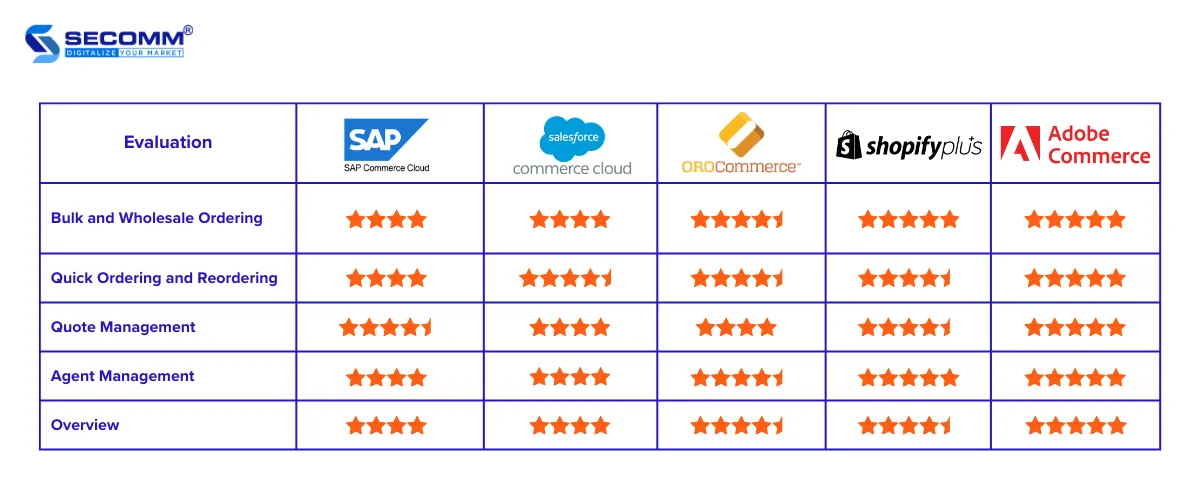
SAP Commerce Cloud is a powerful eCommerce platform suitable for B2B eCommerce businesses.
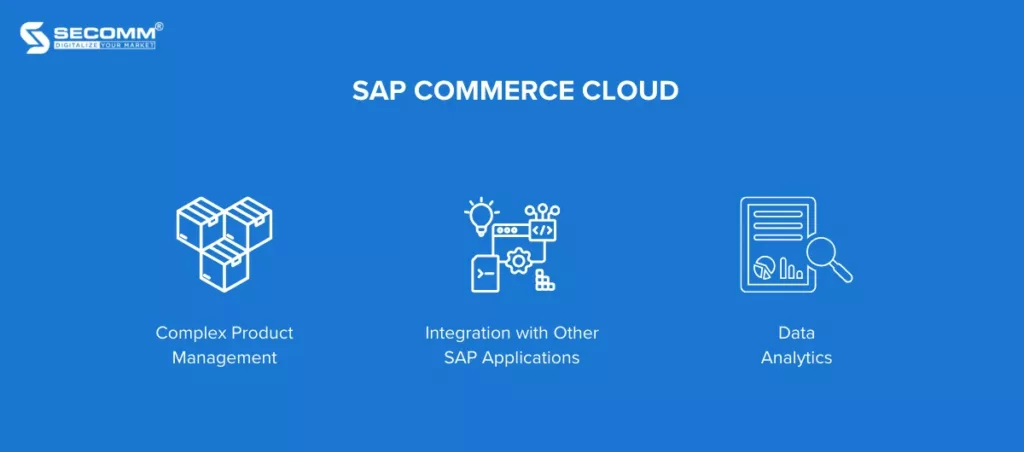
Here are some ways in which SAP Commerce Cloud can cater to B2B eCommerce:
Therefore, SAP Commerce Cloud can align with B2B eCommerce by offering features and customization capabilities to meet the specific requirements of businesses in the B2B industry.
Salesforce B2B Commerce is an eCommerce platform designed for large enterprises, including B2B businesses.
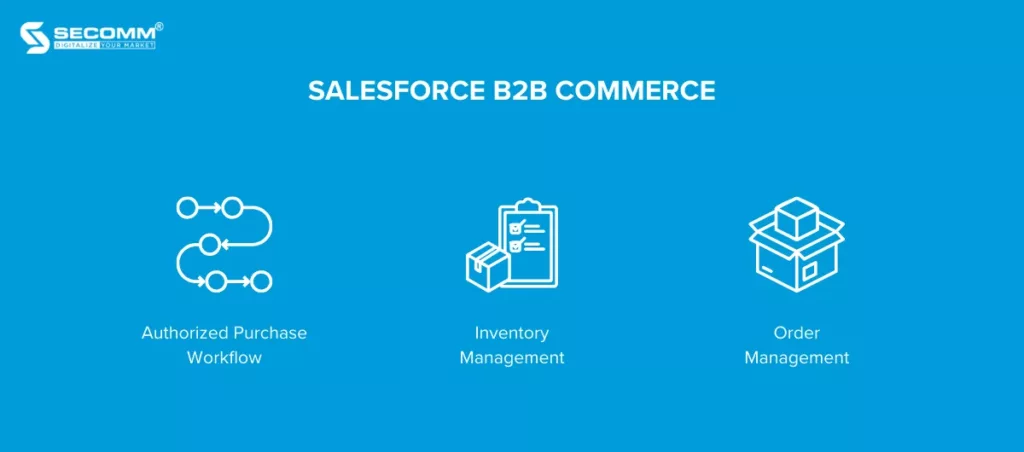
Here are some specific features and functionalities of Salesforce B2B Commerce that are suitable for B2B eCommerce:
In summary, the B2B functionalities of Salesforce B2B Commerce help B2B businesses enhance sales and customer service effectiveness.
OroCommerce is an open-source eCommerce platform designed for B2B enterprises. This platform provides powerful and flexible features, catering to the needs of B2B businesses of all sizes.
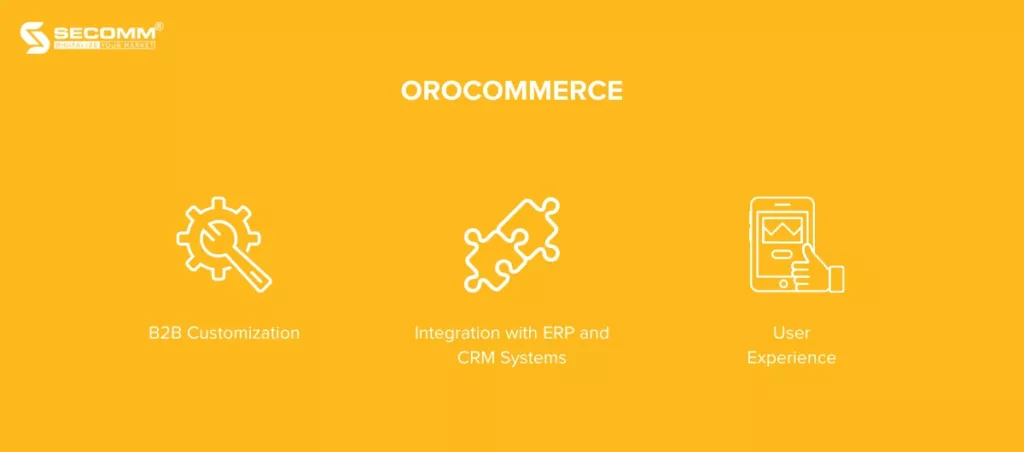
OroCommerce offers several features and functionalities specifically suitable for B2B eCommerce, including:
Overall, OroCommerce is a robust eCommerce platform worth considering for B2B enterprises.
Shopify Plus is a cloud-based SaaS eCommerce platform designed for large enterprises, especially B2B businesses.
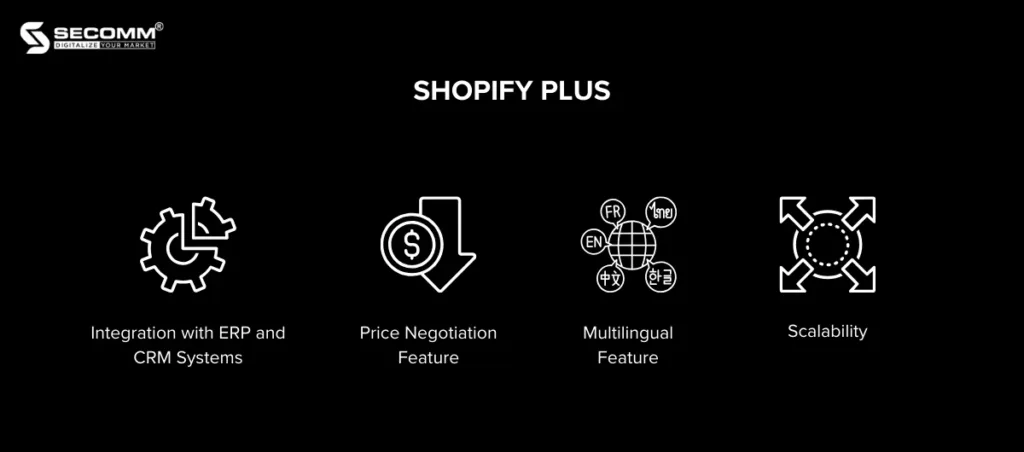
Shopify Plus provides powerful features and functionalities to meet the needs of B2B enterprises, including:
Some notable features of Shopify Plus that businesses can leverage include Shopify Flow, Shopify Launchpad, Shopify Payments, Shopify POS, etc.
Therefore, Shopify Plus is also an excellent choice for B2B businesses looking for a robust, flexible, and scalable eCommerce platform.
Xem thêm: 15 Lý do để chuyển đổi sang nền tảng Shopify Plus
Adobe Commerce (Magento) is a powerful and flexible eCommerce platform suitable for various types of businesses, including B2B enterprises.
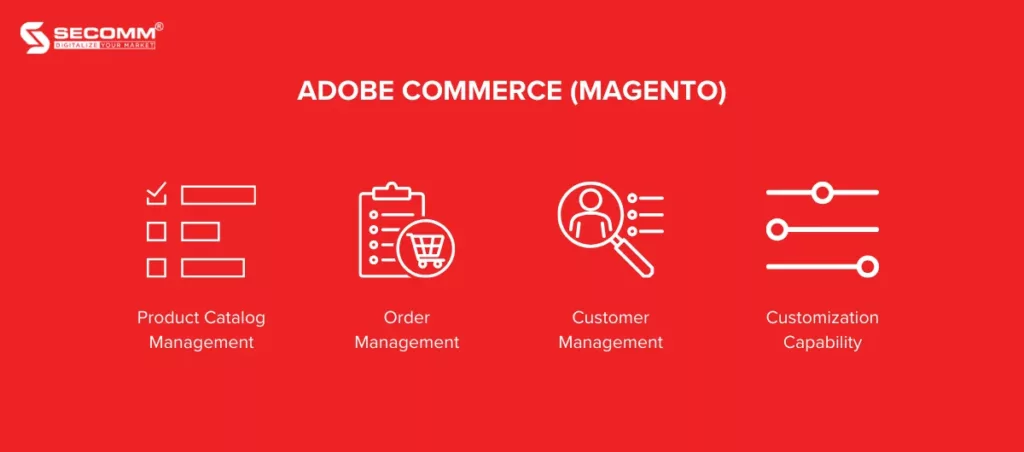
Adobe Commerce offers many features and functionalities that are well-suited for B2B eCommerce, including:
Moreover, Adobe Commerce can quickly deploy B2B-specific features thanks to its diverse ecosystem. It is also the most customizable platform among the five mentioned.
Additionally, Adobe Commerce has a large and active user community, providing support and resources for B2B businesses.
Read more: Shopify Plus vs Adobe Commerce: Key Differences 2023
Above are 5 popular platforms preferred by B2B businesses to build eCommerce websites, serving online business goals for brands.
However, choosing the most suitable platform for each business will depend on various factors, including business strategy, budget, deployment timeline, and the long-term direction set by business managers.
With deep expertise and the development of complex eCommerce systems for clients such as Changi Airport Group (Singapore), Trentham Estate (Australia), and The Warehouse (Vietnam), SECOMM understands the challenges in choosing a platform and deploying eCommerce that businesses are facing.
Contact SECOMM now or call directly at the hotline number (028 7108 9908) for free advice on the eCommerce website building roadmap!
 2
2
 8,110
8,110
 0
0
 1
1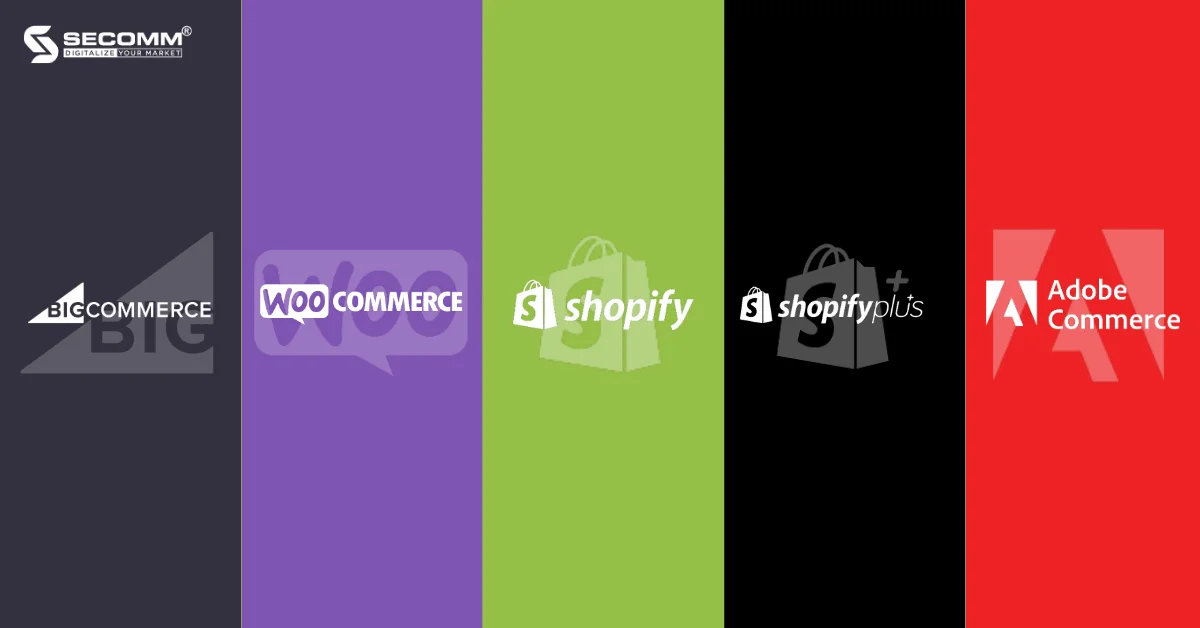
The global B2C eCommerce market is valued at 4.44 trillion USD in 2023 and is projected to reach 7.45 trillion USD by 2030, with a compound annual growth rate (CAGR) of 7.6% during the forecast period from 2021 to 2030.
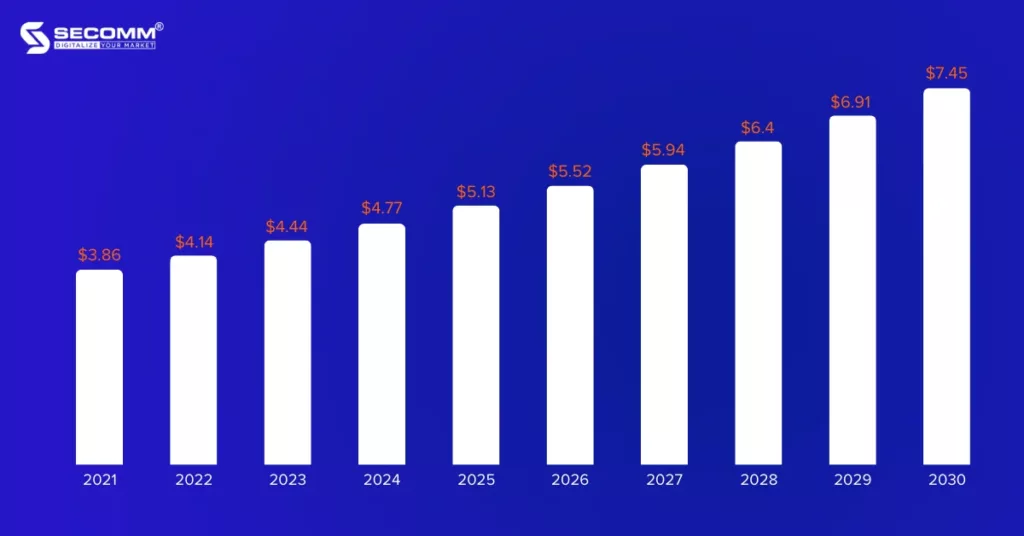
This demonstrates that eCommerce is increasingly thriving, becoming a crucial sales channel for B2C businesses. To build and develop a successful online store, businesses need to choose an eCommerce platform that aligns with their needs and business objectives.
B2C eCommerce platforms typically provide a seamless shopping journey, and user-friendly interfaces, allowing customers to easily navigate, search for items, and complete transactions quickly.
This is achieved through professional UI/UX design and advanced functionality systems for eCommerce websites.
An exemplary example is CHARLES & KEITH, a fashion eCommerce website, designed with sophistication and appeal, along with easy navigation and search capabilities.
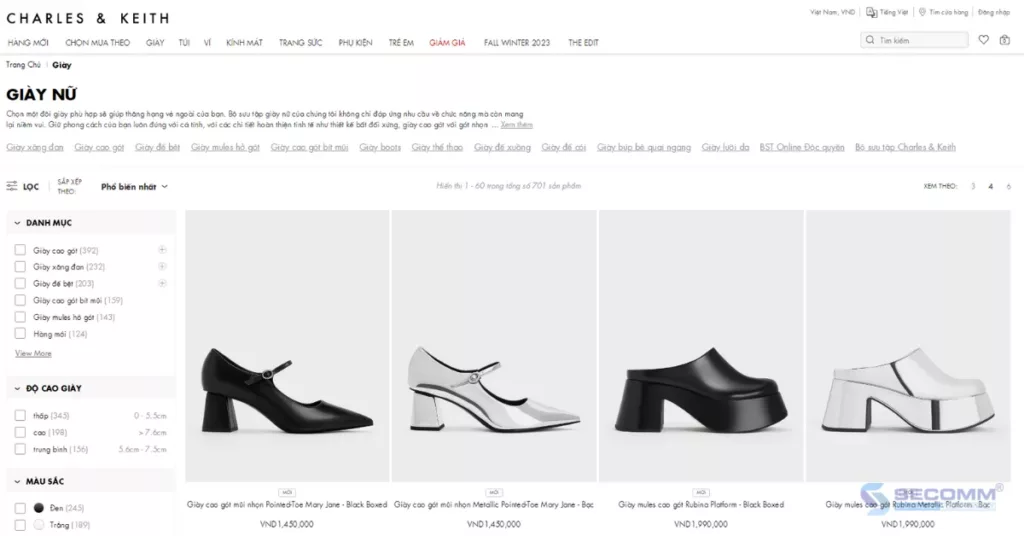
According to Statista’s statistics, the expected number of smartphone users worldwide is projected to reach 4.96 billion by 2025. This indicates that mobile commerce is virtually indispensable in B2C eCommerce strategies.
Consumers increasingly desire the ability to shop anytime, anywhere, even while on the move, and optimizing eCommerce websites for mobile devices will meet this consumer demand.
Choosing a suitable eCommerce platform will support a range of mobile-optimized themes catering to various industries and preferences, enabling businesses to establish an effective online store and navigate for mobile users.
Leading B2C eCommerce platforms will have a streamlined order processing system, ensuring a hassle-free payment experience for both business owners and buyers.
OneStep Checkout is a typical example that allows customers to complete their order payment on a single page. This simplifies and facilitates the payment process for customers, potentially increasing conversion rates.
Businesses can refer to PNJ’s Checkout page for comprehensive information on streamlining the shipping process all within one webpage.
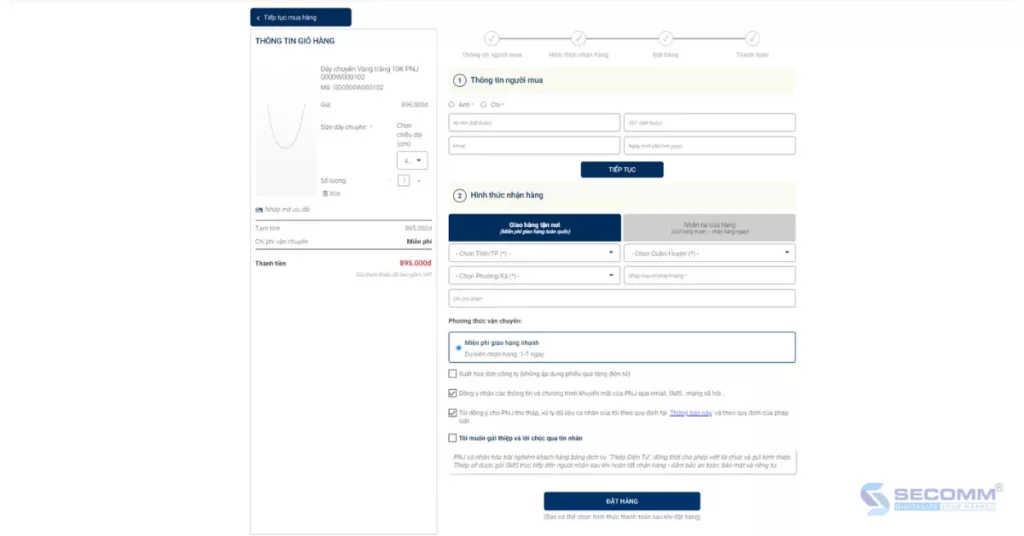
Personalization tools allow businesses to tailor content and promotions based on consumer behaviour and preferences, supported by AI.
By integrating personalized features at relevant touchpoints within an eCommerce website, businesses can enhance conversion rates and ROI (Return on Investment).
Major eCommerce brands like Amazon, Alibaba, Best Buy, etc., consistently incorporate product recommendation features to encourage shopping behaviour from customers.
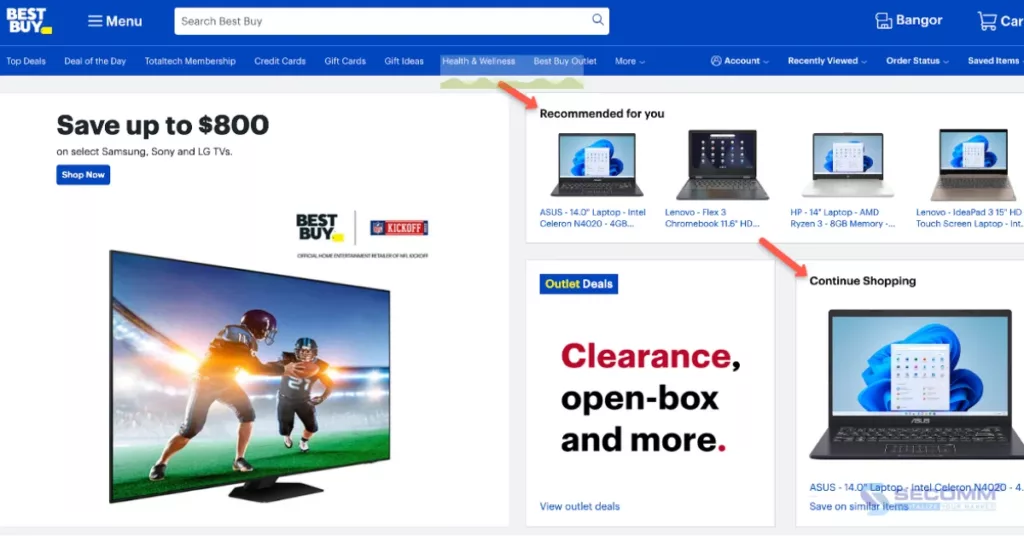
Another crucial aspect of B2C eCommerce is the ability for pages to load quickly and efficiently, ensuring the website maintains stable performance and effectively delivers content on all devices.
To ensure website performance, businesses should opt for major eCommerce platforms such as Adobe Commerce (Magento), Shopify Plus, BigCommerce Enterprise, etc. These platforms offer advanced performance features and robust caching mechanisms, tailored for various industries and preferences, enabling businesses to establish online stores with responsive feedback and faster page loading.
Below are the top 5 eCommerce platforms that SECOMM has evaluated as suitable for businesses following the B2C model.
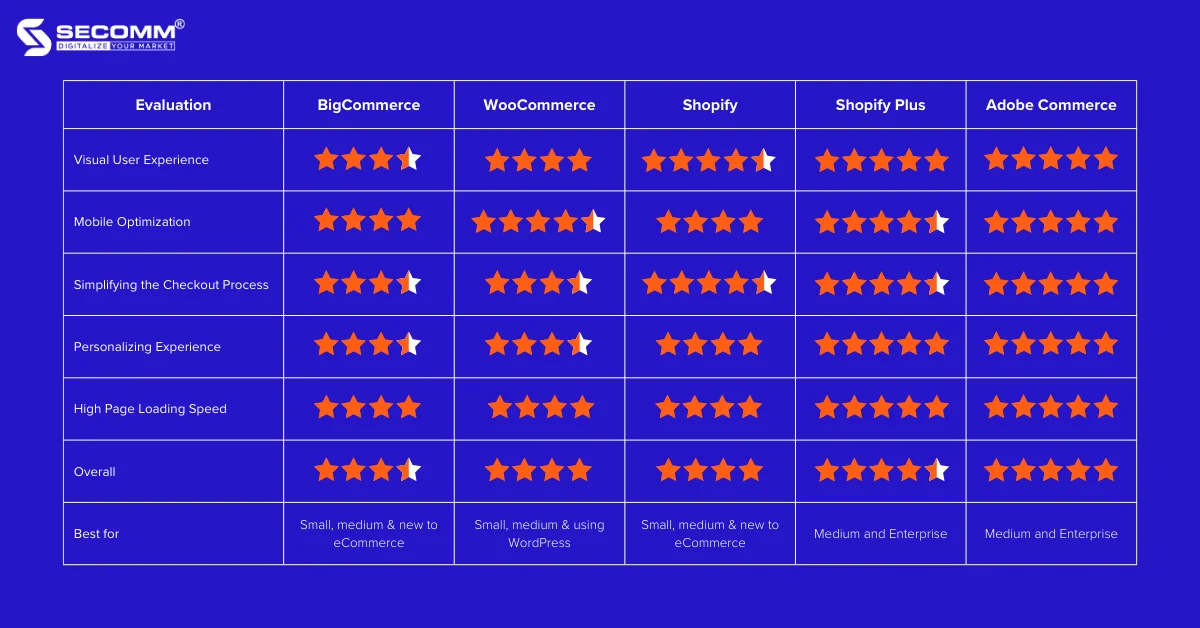
BigCommerce is an eCommerce platform designed for ease of use to assist businesses in initiating their journey to build an eCommerce website.
After years of development, BigCommerce has become one of the feature-rich platforms available for creating websites, optimizing search tools, marketing, etc., with reasonable deployment costs.
Compared to other popular platforms mentioned in this article, the performance, features, and application ecosystem of BigCommerce are not overly outstanding. However, BigCommerce remains a good choice for small, and medium-sized businesses, or those entering the market.
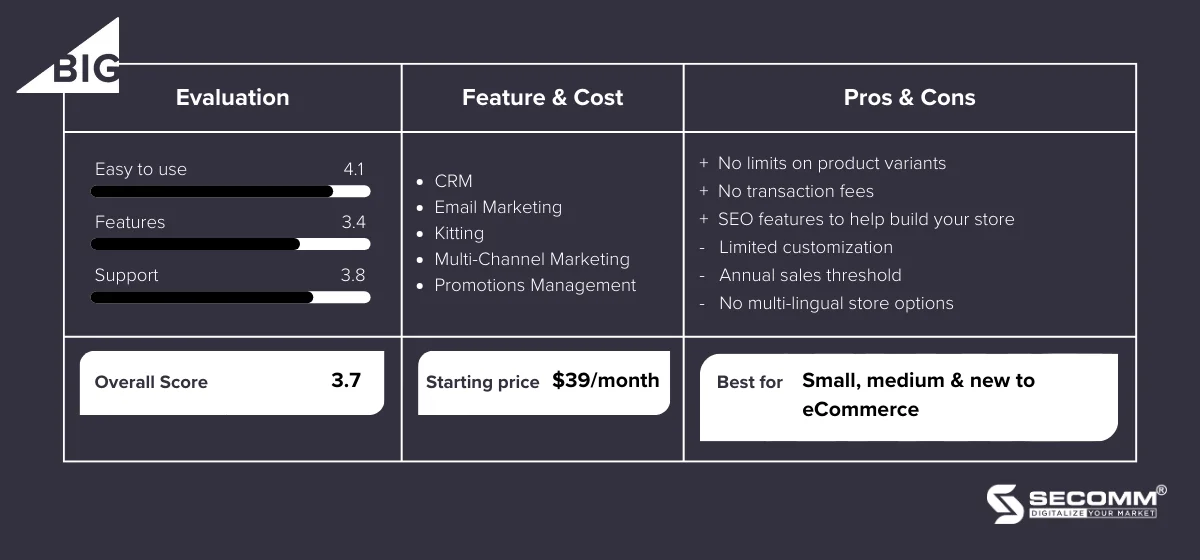
Read more: Shopify vs BigCommerce: Which platform is right for you?
WooCommerce is a free WordPress plugin that enables brands to establish an eCommerce website by adding eCommerce functionality to an existing WordPress site. The WooCommerce plugin helps transform a regular WordPress website into an eCommerce site with all the necessary features, easily customizable with just a few clicks.
Businesses can leverage the extensive ecosystem of WooCommerce to upgrade both functionality and design for the most suitable interface. Therefore, WooCommerce is also a good choice for small or medium-sized B2C businesses, especially those that have previously used WordPress.
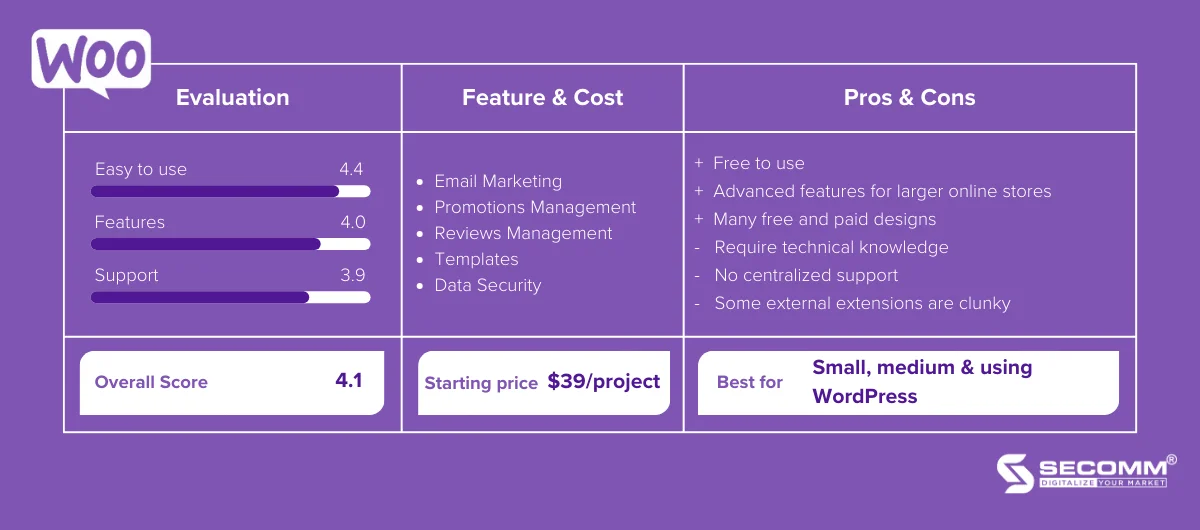
Shopify is one of the popular eCommerce platforms that businesses can use to build, develop, and manage online stores.
Shopify operates on the SaaS (Software as a Service) model, so businesses pay a monthly fee to use the platform and must adhere to its regulations.
However, Shopify manages hosting and takes responsibility for technical issues to ensure the safety and efficient operation of the business’s eCommerce website.
The platform provides the necessary features and benefits for businesses to successfully build and develop an online store. In terms of suitability for B2C businesses, Shopify is most suitable for small to medium-sized enterprises or those entering the eCommerce market.
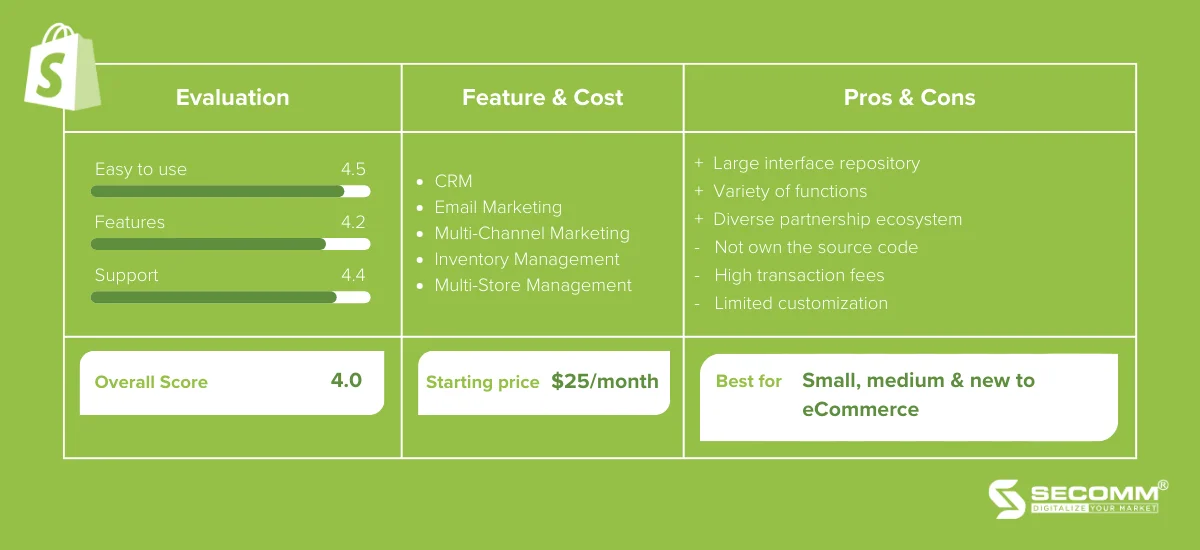
Shopify Plus is the enterprise-level version of the eCommerce platform provided by Shopify, specifically designed for large brands with an annual transaction value of over 1 million USD and high growth rates.
Unlike Shopify, Shopify Plus follows the PaaS (Platform as a Service) model, allowing businesses to utilize the development environment of Shopify Plus to develop databases, web servers, functionality, etc., for their eCommerce system.
The initial cost for using Shopify Plus is around $2,000 per month and increases gradually based on revenue. Therefore, using this platform to meet the needs of B2C eCommerce or any industry-specific requirements is relatively straightforward.
However, Shopify Plus is more suitable for medium to large-scale businesses as it requires technical knowledge and involves relatively high usage costs.
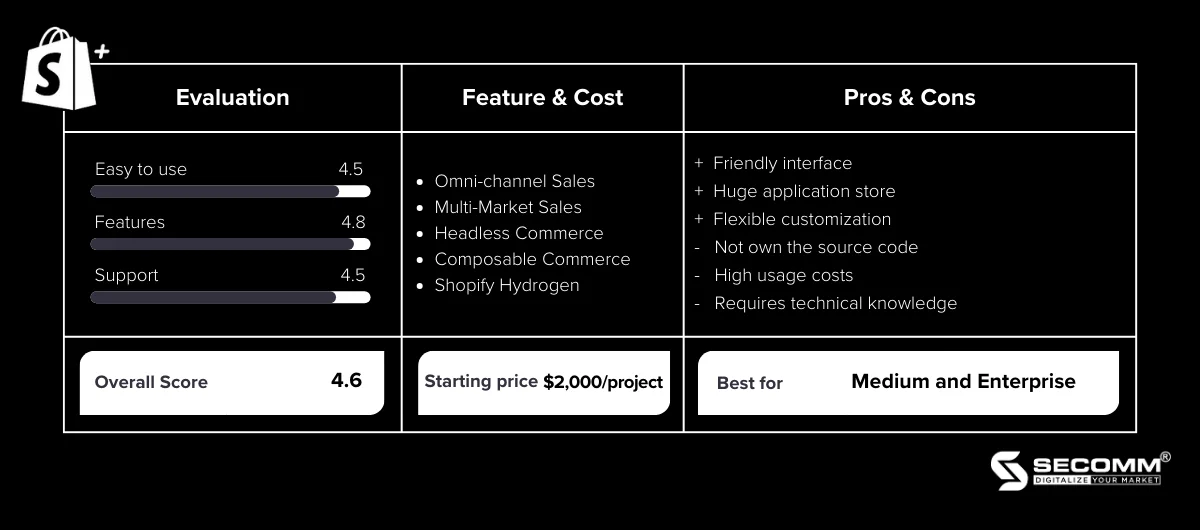
Read more:
Adobe Commerce is an open-source eCommerce platform specially designed to serve medium to large-scale businesses, offering high customization and scalability. Currently, Adobe Commerce has two main versions: Adobe Commerce Cloud and Magento Open Source.
As one of the leading platforms in eCommerce, Adobe Commerce is consistently highly regarded across all scales and industries, including B2C eCommerce businesses.
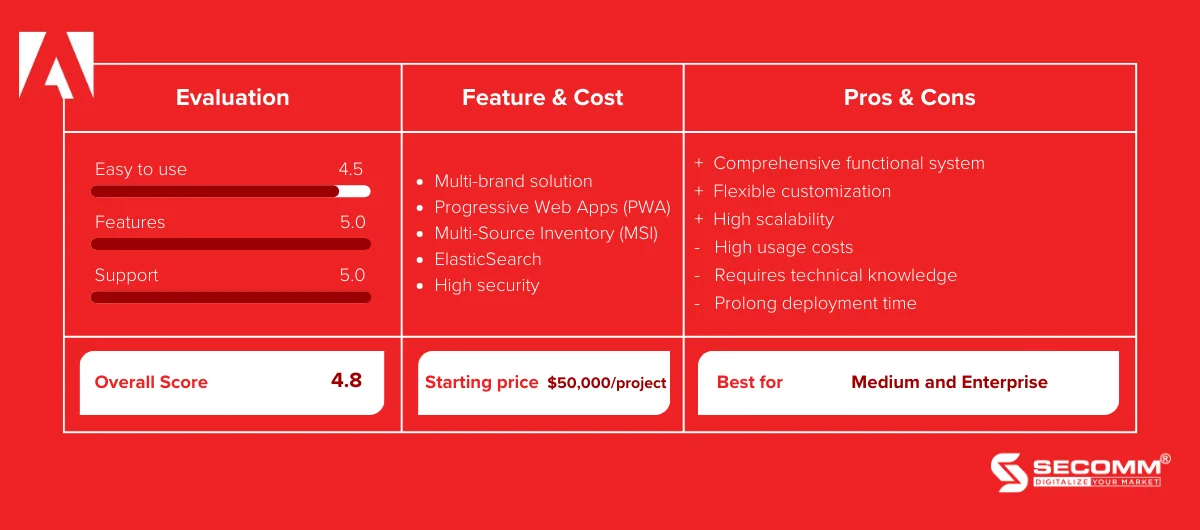
Read more:
Above are the 5 popular platforms that B2C businesses prefer to use for building eCommerce websites, catering to online business goals for their brands.
However, choosing the most suitable platform for each business will depend on various factors such as business strategy, budget, deployment time, and the long-term direction set by business managers.
With deep expertise and the development of complex eCommerce systems for clients such as Changi Airport Group (Singapore), Trentham Estate (Australia), and The Warehouse (Vietnam), SECOMM understands the challenges in choosing a platform and deploying eCommerce that businesses are facing.
Contact SECOMM now or call directly at the hotline number (028 7108 9908) for free advice on the eCommerce website building roadmap!
 2
2
 9,219
9,219
 0
0
 1
1
The jewelry eCommerce sector is a promising market experiencing swift growth. According to statistics, the global eCommerce jewelry market is currently valued at about 57.4 billion USD and is anticipated to reach approximately 117 billion USD by 2027.
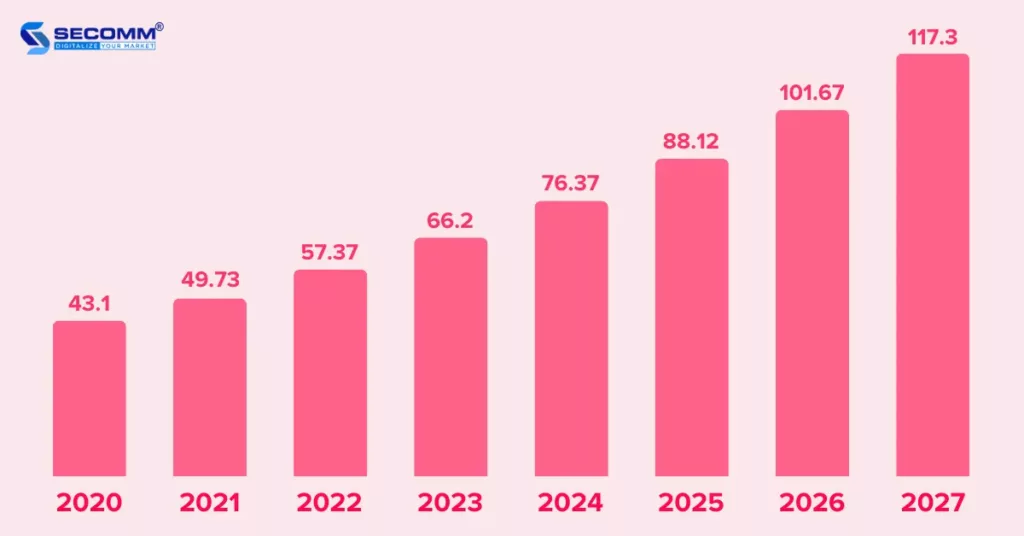
Jewelry eCommerce involves selling various jewelry items, including necklaces, rings, earrings, bracelets, gold, silver, diamonds, pearls, gemstones, and other pieces, conducted through online channels.
This type of eCommerce involves the purchase and sale of jewelry products through websites, applications, or online marketplaces.
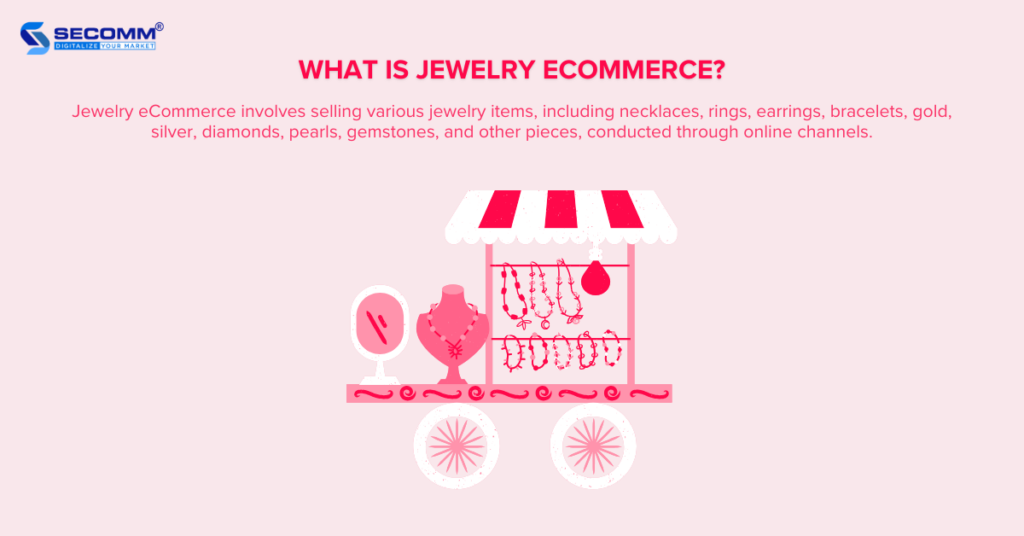
Jewelry eCommerce is increasingly thriving, especially in the context of the COVID-19 pandemic. According to a report from the Vietnam eCommerce Association (VECOM), the Vietnamese jewelry eCommerce market is estimated to reach 10 trillion VND in 2022, showing a growth of 25% compared to 2021.
Several factors are driving the potential of jewelry eCommerce, including:
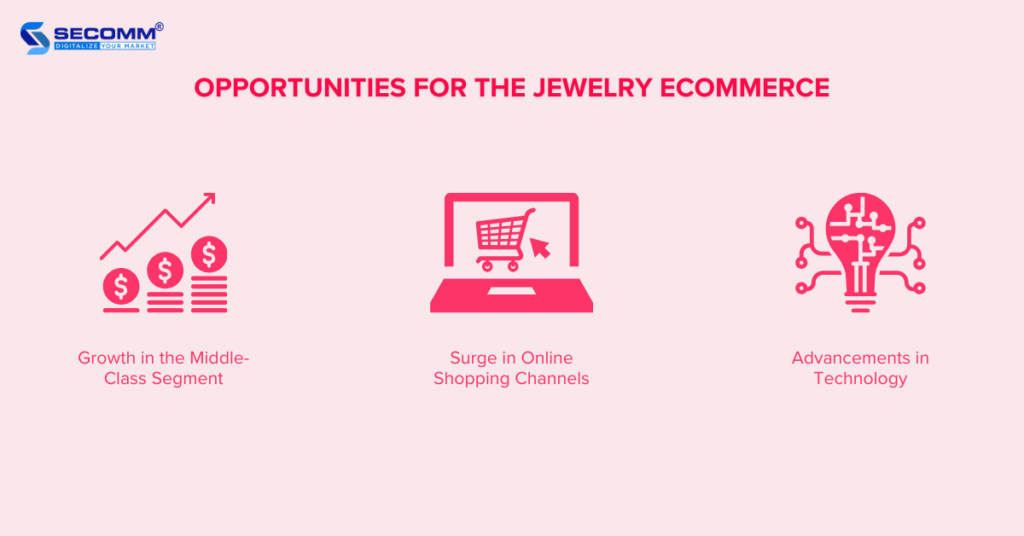
According to the World Bank report, the middle class in Vietnam is steadily increasing, from 13% of the population in 2016 to 26% in 2026. It is expected that the middle class in Vietnam will continue to grow in the coming years.
On a global scale, according to the McKinsey Global Institute report, the global middle class is projected to increase from 1.8 billion people in 2020 to 4.9 billion people in 2030. This growth will generate significant demand for premium products and services, including jewelry and gemstones.
According to Metric report, as of June 2023, Vietnam has over 100,000 eCommerce websites, a 20% increase compared to 2022. The most popular product categories on Vietnam’s online marketplaces include fashion, home appliances, electronics, and jewelry.
On the international market, according to Statista’s report, as of June 2023, there are over 280 million active eCommerce websites worldwide.
The growth of online shopping channels, specifically individual eCommerce websites, has created many opportunities for jewelry eCommerce businesses to reach a larger audience, including customers in distant regions away from the main stores.
The advancement of technology is one of the crucial factors driving the potential of jewelry eCommerce. When integrating innovative technologies like VR/AR, and AI into your jewelry website will enrich the online shopping experience, making it more engaging and appealing to customers.
Alongside the opportunities, jewelry brands still have to confront the challenges of the market
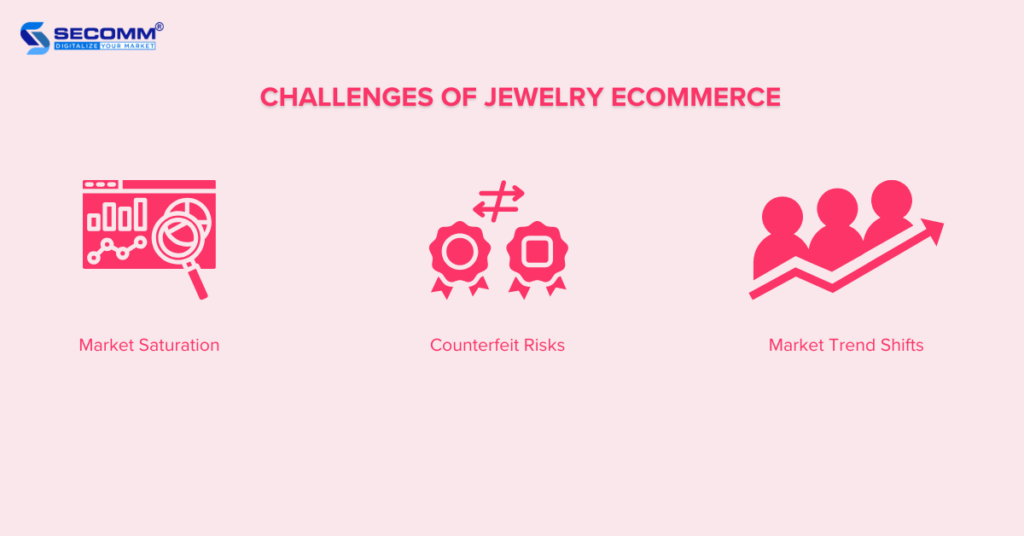
The jewelry industry faces intense competition, with numerous businesses, both large and small, vying for market share. This requires jewelry brands to exert efforts to compete in terms of pricing, product quality, and the services they provide on their eCommerce website.
Counterfeit goods are often made from low-quality materials and are significantly cheaper than genuine products. This poses a significant challenge for the online jewelry market, as consumers struggle to differentiate between authentic and fake items, leading to adverse effects on jewelry brands.
Market trends are always changing, particularly in the jewelry eCommerce industry. It requires you to stay constantly updated to cater to evolving customer demands.
When purchasing jewelry products, customers desire an online shopping experience similar to in-store shopping. Because they want to view products directly, read reviews from other customers, and receive guidance from sales staff.
Tiffany & Co. is a premium jewelry brand headquartered in New York, USA, established in 1837 by master jeweler Charles Lewis Tiffany. The company embraced eCommerce early on and has become one of the largest online jewelry retailers globally.
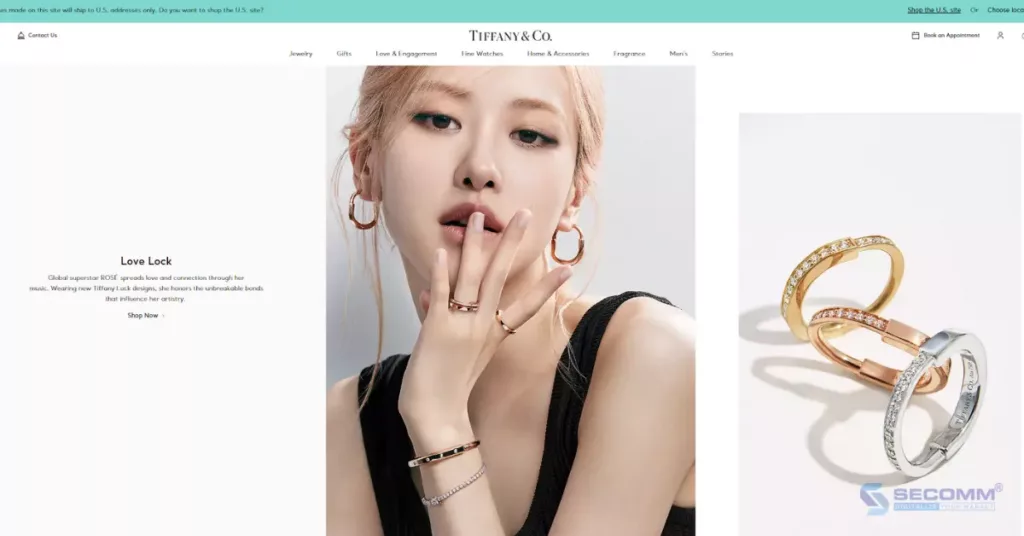
Tiffany & Co.’s eCommerce website is built on the Adobe Enterprise Cloud platform, enabling the business to provide flexibility and scalability to meet customization needs and long-term development goals.
Leveraging resources from the leading Adobe Commerce eCommerce platform, the business has utilized Adobe Experience Platform Launch, Adobe Target, Adobe Experience Platform Identity Service, and more to deliver customized and personalized services for its customers.
Pandora is a retail jewelry brand established in 1982 by Per Enevoldsen in Copenhagen, Denmark. The brand is known for customizable bracelets and other specially designed jewelry lines.
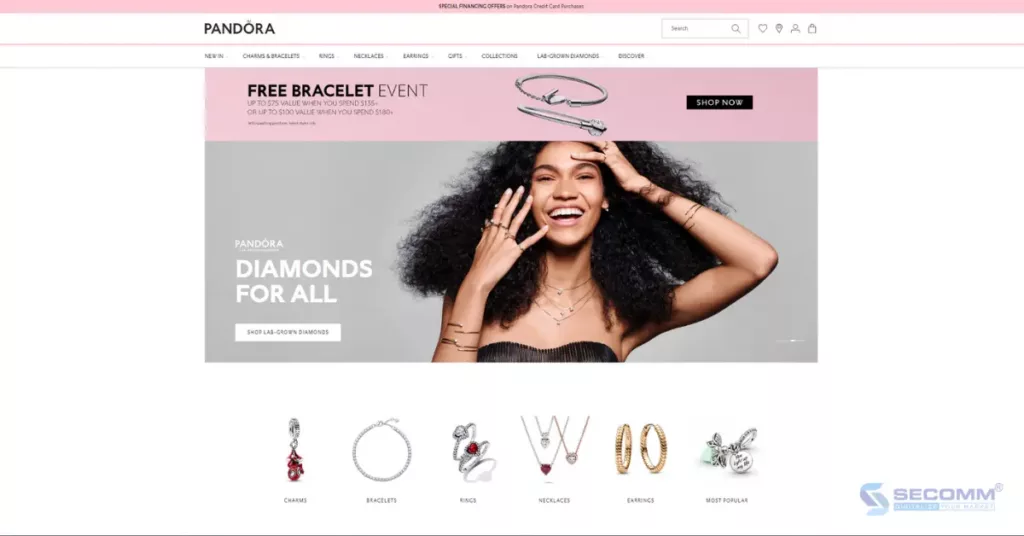
Pandora’s eCommerce website for the US and UK markets is built on the Salesforce Commerce Cloud platform, while the Vietnamese market utilizes Haravan. Therefore, the US and UK versions will have more specialized features such as wishlists, quick view, product comparison, loyalty programs, etc.
PNJ, or Phu Nhuan Jewelry, is a reputable jewelry brand with a long history and a widespread network of stores across Vietnam. Founded in 1988 in Phu Nhuan District, Ho Chi Minh City, Vietnam.

Initially, PNJ’s eCommerce website was built on the CS-Cart platform. As it grew, PNJ re-platform to WooCommerce to design its eCommerce website. This move benefits the PNJ website with many amazing features, including diverse payment method integration, product size customization, store location search based on province/city and district, and the flexibility of choosing between home delivery and in-store pickup.
The Bottom Line
In general, jewelry brands face numerous challenges and opportunities to make strides in the eCommerce landscape. Achieving success in this industry requires innovation, responsiveness to customer demands, and staying abreast of the latest technological trends.
Learn more: 10 Jewelry eCommerce Websites in Vietnam & Worldwide
Understanding both the opportunities and challenges when deploying jewelry eCommerce websites, SECOMM has a team of experts and a wide range of solutions to help you make it a reality.
Contact us or call the hotline at 028 7108 9908 to get started!
 2
2
 9,930
9,930
 0
0
 2
2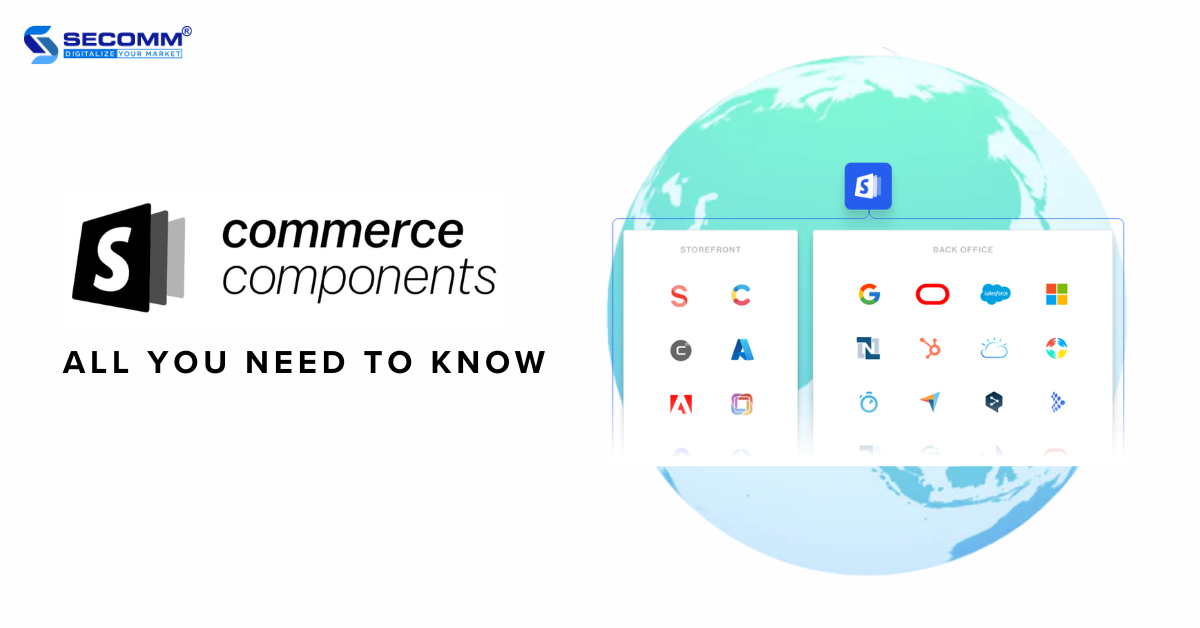
Today, with the growing demand for flexible and scalable eCommerce system development, large-sized businesses turn their attention to solutions like Headless, Microservices, and Composable Commerce. The Composable approach will allow you to integrate independent components to tailor and enhance the eCommerce experience.
Knowing this insight, Shopify has unveiled the Commerce Components solution, offering you — as a large-sized business — the most straightforward approach to deploying Composable Commerce.
Learn more: What is Composable Commerce?
Commerce Components is an innovative tech stack designed for large businesses. Rather than introducing new features, the company has transformed its infrastructure into modular components that can be combined to build and customize adaptable eCommerce websites. This means you can select components based on your deployment needs and seamlessly integrate them into your existing tech stack using flexible and unlimited API connections, ensuring a smooth customer experience across all devices.
“We’ve always approached innovation by anticipating what retailers need and then providing those solutions,” said Harley Finkelstein, president of Shopify. “Commerce Components opens our infrastructure so enterprise retailers don’t have to waste time, engineering power and money building critical foundations it has already perfected, and instead frees them up to customize, differentiate and scale”
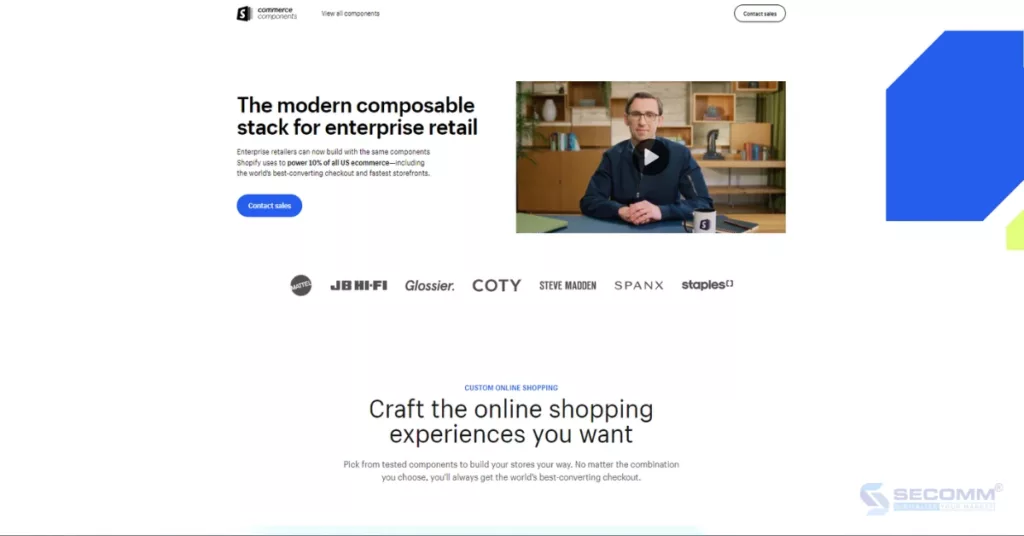
The solution offers six main categories including over 30 components, allowing you to build a tailored solution that aligns with your needs.
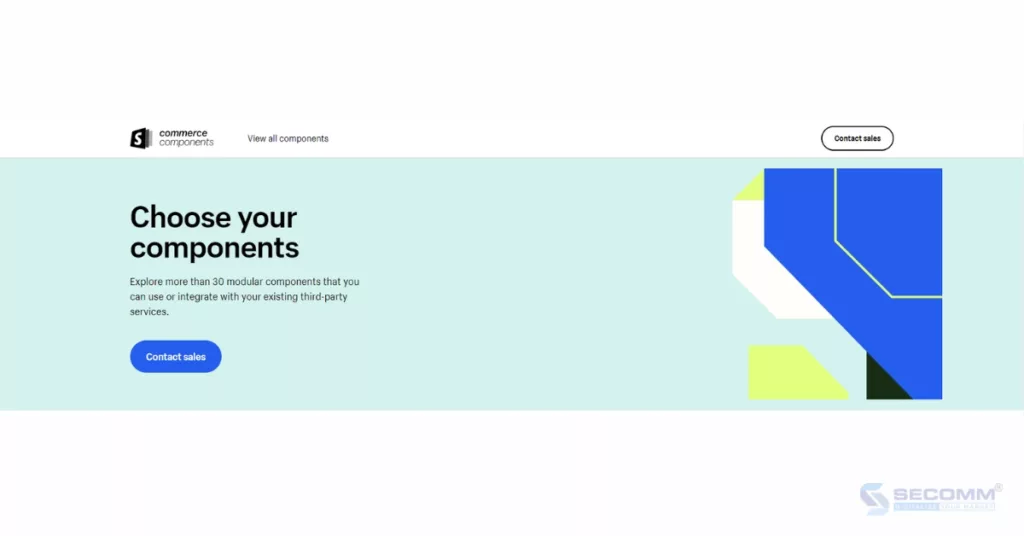
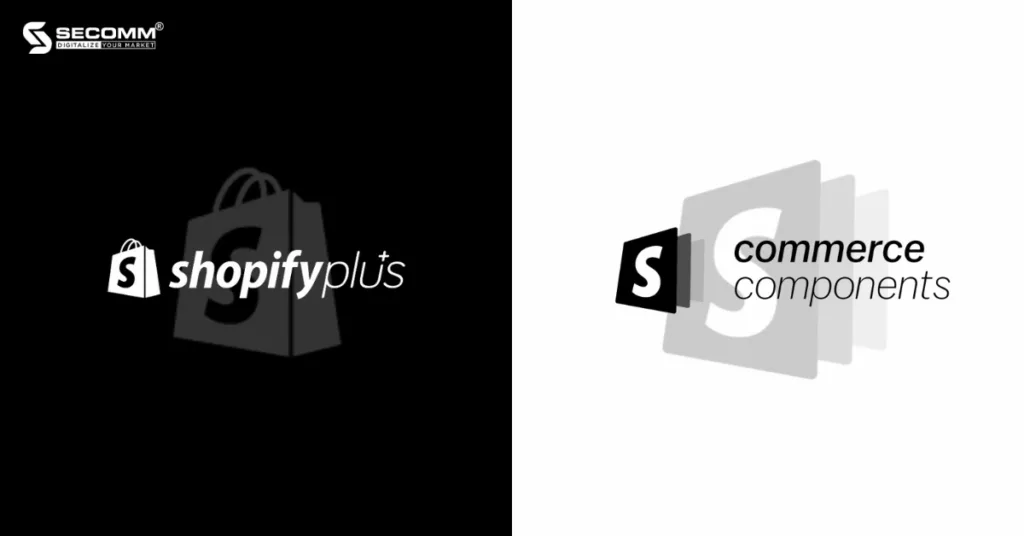
Although both ‘Plus’ and Components are enterprise eCommerce solutions, they differ in several aspects:
If you don’t prefer to deploy pre-packaged eCommerce platforms. Composable architecture is the ideal choice. It allows you to select and purchase components based on your needs, integrate them into your existing systems, and customize them.
With its modular architecture, the tech stack provides unlimited API connections, meaning there is no limit to the number of components and add-ons that you can use to build your tech stack.
Moreover, since components are entirely independent, you can add, remove, and modify components without affecting the entire system.
Commerce Components employs a pricing model structured around the level and quantity of components used. This means you only pay for the components you require. Furthermore, as you acquire and utilize more components, you’ll benefit from increasingly significant discounts.
Additionally, the annual payment structure of Components helps you facilitate precise cost predictions.
Since its inception, the platform has proudly highlighted the trust and adoption of its solution by major global businesses. Notable among these are Glossier, JB Hi-Fi, Coty, Steve Madden, Spanx, and Staples.
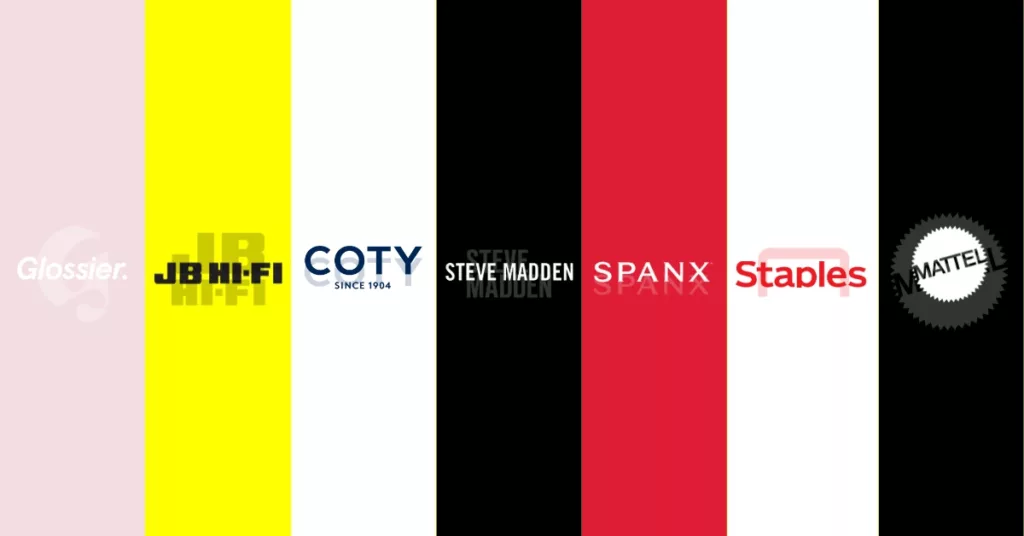
Leading U.S. toy brand Mattel is one of the first enterprises to successfully implement this technology solution. Sven Gerjets, Mattel’s CTO, said in a statement.
“We first worked with Shopify on a project called Mattel Creations, a platform for creators to reimagine the most iconic toys in the world. Creations empowered Mattel to move quickly, meet our customers where they are, and most importantly leverage its infrastructure to scale globally. It was hugely successful, and we’re excited to transform our brand offerings using Commerce Components.”
The trust placed by Mattel and other industry leaders forms a solid basis for expecting the ongoing success of this new solution, extending its impact not only within the U.S. market but also on a global scale.
Final Thoughts
In the past, large businesses often favored open-source platforms like Magento or Salesforce due to their customizable and flexible expansion capabilities. However, in today’s landscape, SaaS platforms, particularly Shopify, offer innovative solutions for developing Composable or Headless Commerce.
In 2021, the company launched the Hydrogen + Oxygen solution to enhance Headless Commerce development. Continuing this trend into early 2023, they once again surprise the industry with Commerce Components, designed for deploying Composable Commerce.
This move highlights its commitment to anticipating and responding to customer needs, earning the trust of large enterprises in the face of competitive rivals.
Reach out or call the SECOMM hotline at 028 7108 9908 for a more in-depth understanding of Commerce Components by Shopify and to explore the implementation of Headless Commerce or Composable Commerce.
 2
2
 11,081
11,081
 0
0
 1
1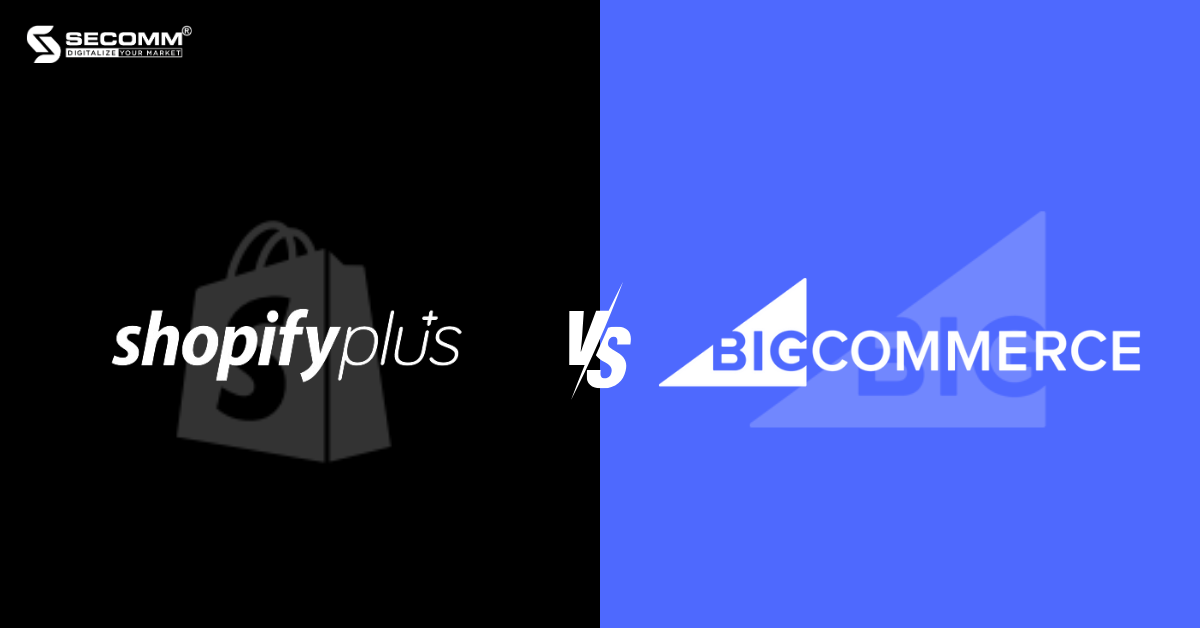
In today’s eCommerce landscape, it isn’t just open-source platforms that can meet the complex development and customization needs of large-scale enterprises, but SaaS platforms are also steadily rising with significant improvements. Among them, two SaaS platforms designed specifically for large enterprises are Shopify Plus and BigCommerce Enterprise.
However, these two platforms have many key differences. This article aims to clarify the pros and cons of each platform and compare the differences between the two platforms to help you — as a business leader — make well-informed decisions.
Learn more: Shopify vs BigCommerce: Which platform is right for you?
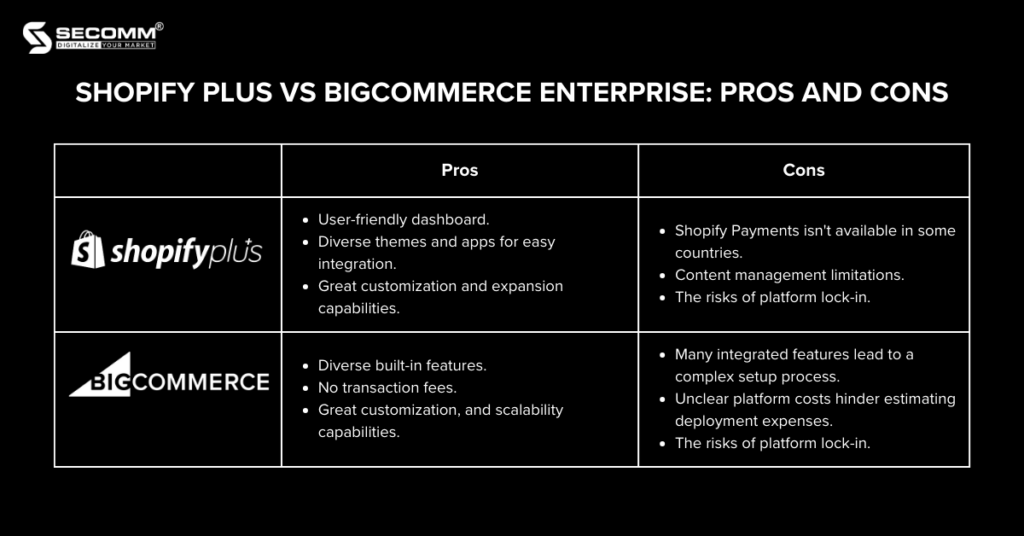
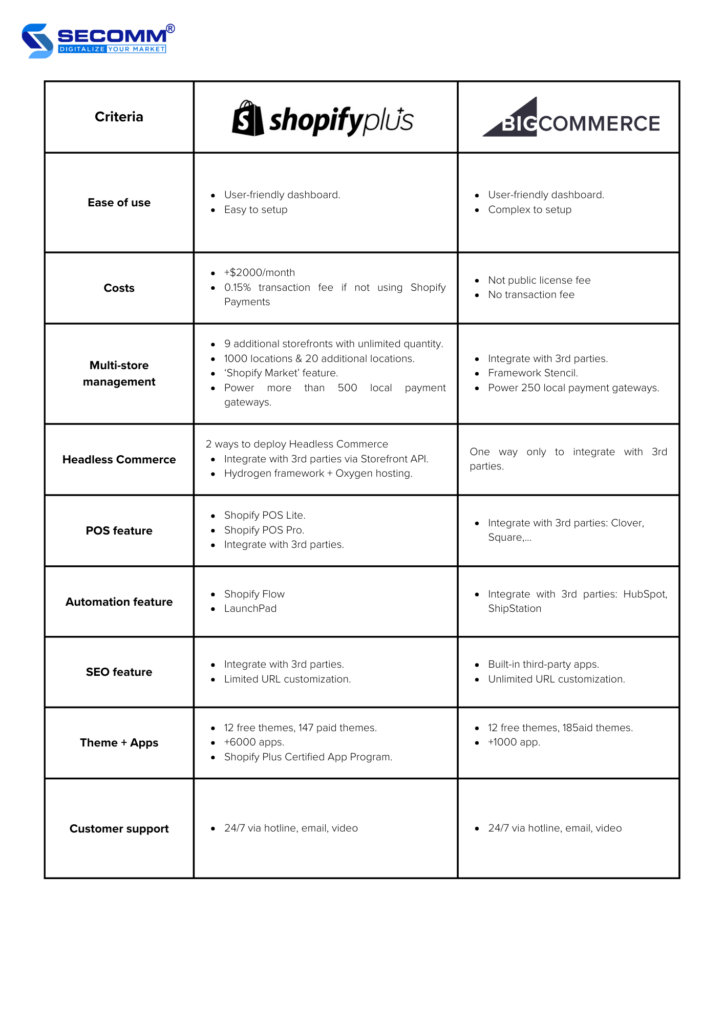
Both platforms are recognized for their user-friendliness compared to open-source platforms. Their intuitive dashboard and user-friendly navigation, along with features like drag-and-drop editing, extensive documentation, and 24/7 support, make them accessible for users of varying technical expertise.
However, Shopify, known for its inherent user-friendly design, ensures that users, whether using the Plus version or the regular ones, can easily explore and set up their eCommerce website with efficiency.
Both these two premium solution platforms — which are Shopify Plus and BigCommerce Enterprise — cater to the deployment needs of large enterprises, these platforms offer advanced features and technologies that require some learning.
For example, the ‘Plus’ users need to grasp the Liquid template language, while those opting for the ‘Enterprise’ may benefit from understanding the Google Cloud Platform for optimizing website performance.
BigCommerce, renowned for its built-in features, continues this trend with the ‘Enterprise’ version. Some features may suit specific businesses but might be unnecessary for others. While BigCommerce allows flexibility for customizing and configuring these advanced features, it can introduce complexity and intricacy into the setup process.
Similarly to other premium solutions on SaaS platforms, the license fee will depend on the deployment requirements and the current scale of the business. BigCommerce doesn’t disclose the fee publicly, requiring businesses to directly contact the platform for tailored consultation and pricing.
On the other hand, Shopify Plus has a license fee starting at $2000 per month. Once you reach a monthly revenue threshold of $800,000, the platform fee becomes revenue-based, amounting to 0.25% of monthly revenue, capped at $40,000 per month or $480,000 per year.
Considering transaction fees is also important. While BigCommerce doesn’t charge transaction fees, Shopify Plus charges a 0.15% transaction fee for not using Shopify Payments.
To estimate deployment costs effectively, you should partner with development agencies and engage in detailed consultations with BigCommerce or Shopify for comprehensive guidance.
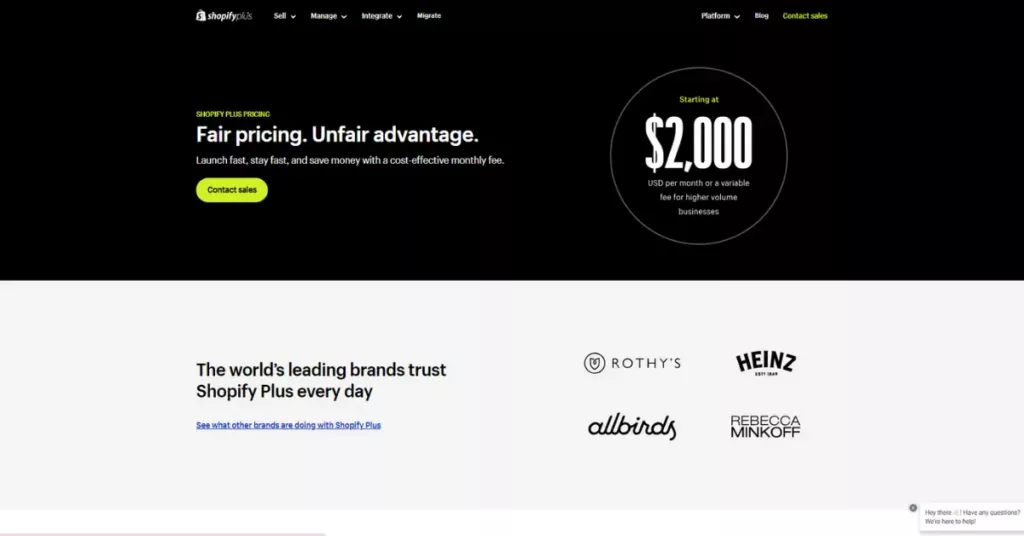
For large enterprises, the multi-store management feature is crucial and a primary consideration when selecting an eCommerce platform to sell globally. To engage in sales across various markets worldwide, your eCommerce website needs to be crafted to suit the preferences of each target audience in different markets.
This involves addressing issues related to language conversion, currency units, and payment methods with flexibility. Moreover, stores should be administered efficiently in a centralized manner rather than separately.
Shopify Plus allows you to create up to 9 additional storefronts alongside the main storefront at 1000 different inventory locations and 20 additional inventory locations. All these storefronts can be centrally managed through a single dashboard.
Plus, the Shopify Market feature will help you select the markets you want to sell in. The system will then automatically convert and manage multiple languages, currency units, shipping options, and payment methods based on the user’s IP address. Currently, Shopify Plus supports a range of local payment gateways, and you can refer to the provided list.

BigCommerce Enterprise doesn’t provide many solutions or features for global selling. Instead, it allows you to deploy multiple stores within the platform and then integrate with 3rd-party PIM solutions to manage data across these stores.
Another option is to leverage the BigCommerce Stencil framework to tailor content language for each local market. Also, the Enterprise version supports multi-currency payments through more than 250 local payment gateways.
The demand for adopting Headless eCommerce is on the rise, especially among large enterprises seeking to deliver a seamless and optimized experience for their customers. Both Shopify Plus and BigCommerce Enterprise offer effective solutions for going Headless.
BigCommerce Enterprise allows you to integrate with various frameworks (Next.js, Gatsby.js, Nuxt.js), APIs (REST, GraphQL), and your preferred or previously used tools.
When using Shopify Plus, there are three approaches. You can use the Storefront API to connect and develop with your preferred frameworks, hosting solutions, and tools. Or, you can leverage Shopify Hydrogen framework and Oxygen hosting to facilitate a headless eCommerce website flexibly.
Just like their regular pricing plans, both the ‘Enterprise’ and the ‘Plus’ include Point of Sale (POS) features for eCommerce transactions, catering to both online and offline stores, as well as Omnichannel operations.
POS can be configured on various devices like mobile devices (tablets, smartphones), and other hardware like cash registers and barcode scanners.
BigCommerce Enterprise offers smooth integration with third-party POS systems like Square, Vend, Clover, and Heartland Retail. It’s good for those who already using POS software from these third-party providers.
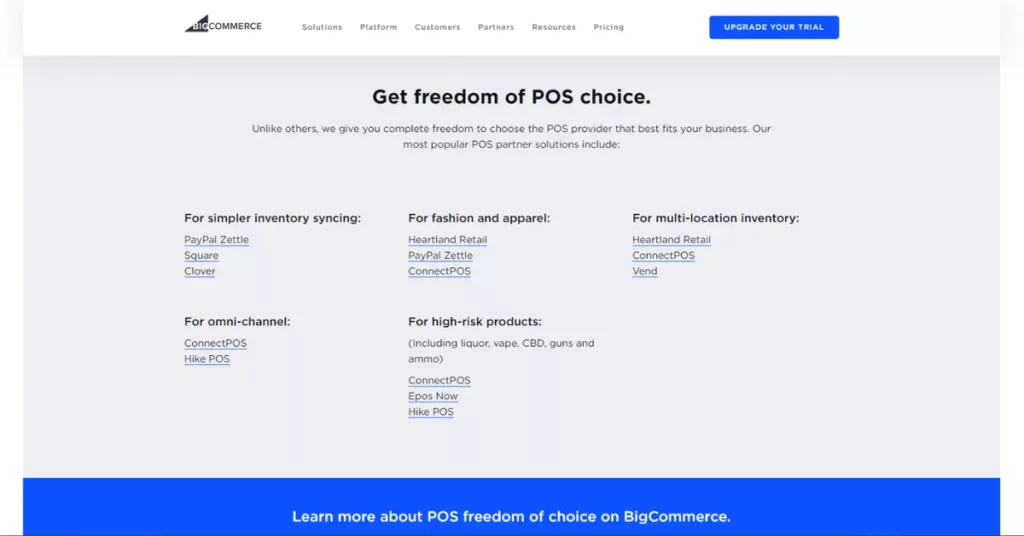
For Shopify Plus, beyond the option to integrate with third-party POS systems like BigCommerce Enterprise (Clover, Square, Zend), Shopify offers its own Shopify POS solution, available in two plans:
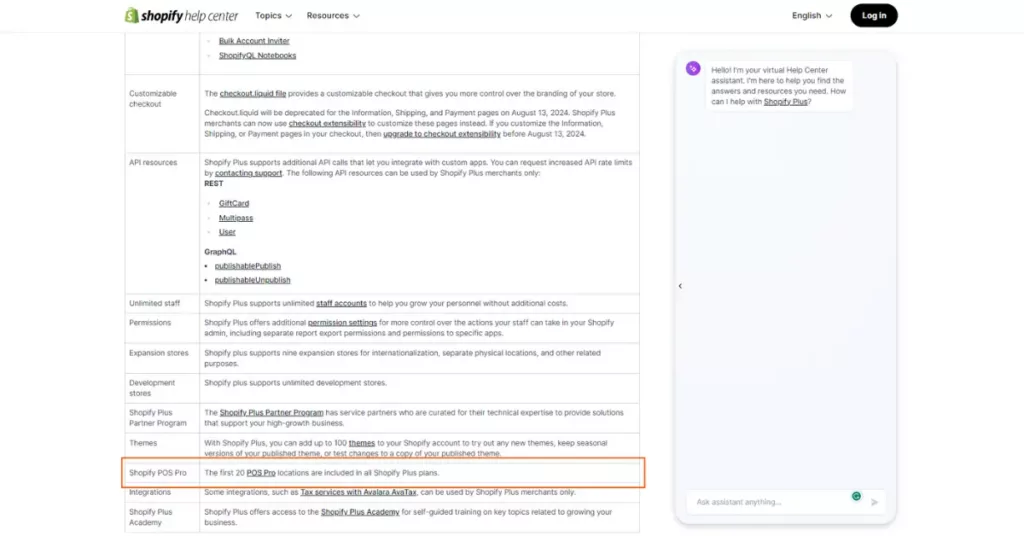
Both ‘Plus’ and ‘Enterprise’ offer tools and solutions to help you automate your eCommerce website operations.
Shopify Plus offers an exclusive solution, Shopify Flow, and LaunchPad, allowing you to automate routine tasks and set up automated workflows for tasks like email marketing campaigns or new product launches.
On the other hand, BigCommerce Enterprise takes a different automation approach which enables you to smoothly integrate with 3rd-party apps. Some of them are HubSpot, Avalara, ShipStation, etc.
SEO plays a crucial role in improving the search visibility of an eCommerce site and attracting potential customers. Both platforms offer features to enhance SEO efforts.
The ‘Plus’ stands out for its user-friendly interface and an integrated app ecosystem that can enhance SEO, incorporating tools such as Google Search Console and Analytics. However, it comes with limitations in URL control and customization.
The ‘Enterprise’, on the other hand, provides more versatile SEO capabilities, including complete control over URLs and integration with applications like Google Search Console and Analytics. It makes the process more intricate compared to Shopify Plus, involving additional setup operations.
Shopify Plus offers businesses approximately 12 free themes and 147 paid themes, with prices ranging from $150 to $380 per theme. On the other hand, BigCommerce Enterprise provides around 12 free themes and 185 paid themes, with prices ranging from $150 to $400 per theme.
Both platforms offer a wide range of visually appealing and mobile-friendly theme options. While the ‘Enterprise’ themes are characterized by elegant, tidy, and modern designs with highly customizable features, the ‘Plus’ themes can meet higher requirements for user experience, making navigation easier.
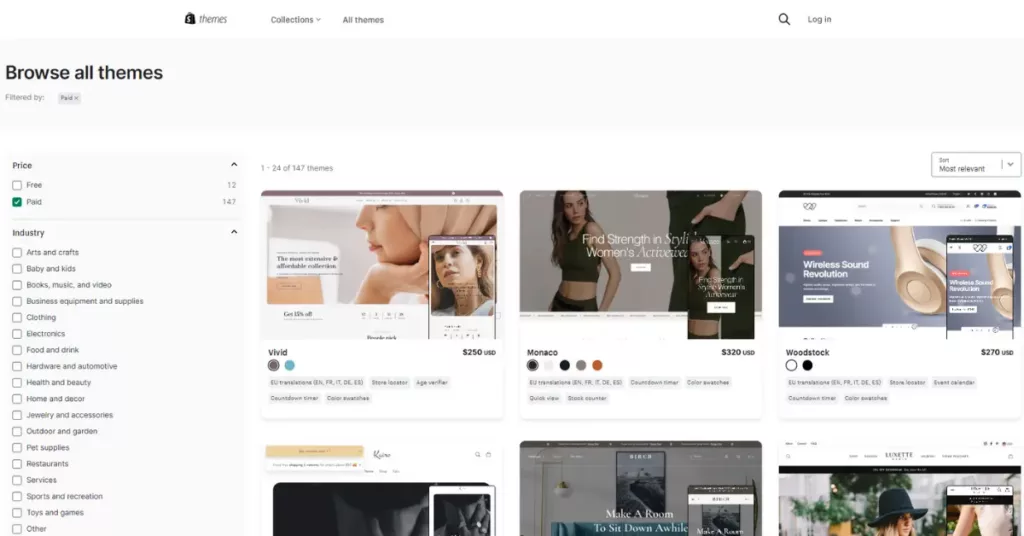
To facilitate efficient eCommerce deployment, the two provide vast app stores and extensions, tailored for ‘Plus’ and ‘Enterprise’ businesses. While both platforms offer free versions, access to comprehensive features requires a modest monthly fee.
Shopify Plus boasts over 6,000 apps and extensions, while BigCommerce Enterprise has around 1,000. This can be explained by Shopify’s widespread popularity among businesses and developers globally, providing them with ample documentation and resources for app and extension development, including the Shopify Plus Certified App Program.
For businesses that are ready to deploy the ‘Plus’ or the ‘Enterprise’ solutions, the demand for technical support and efficient eCommerce website operations is significant.
Both platforms receive high praise for their customer service. They offer 24/7 support via hotline, email, and video available in multiple languages. However, if you need specialized and complex technical support, Shopify Plus may be the preferable choice.
Final Thoughts
In the competitive business landscape, selecting the right platform for launching an eCommerce website is an important decision. Both Shopify Plus and BigCommerce Enterprise offer distinct advantages and cater to various business models.
Regardless of the platform chosen, you should prioritize the development and delivery of an exceptional shopping experience for your customers. eCommerce platforms serve as tools, and the ultimate key to success lies in an effective deployment strategy and great collaboration with a proficient team.
With extensive experience helping numerous businesses deploy diverse eCommerce development projects on both Shopify Plus and BigCommerce Enterprise, SECOMM boasts a team of seasoned experts capable of collaborating to create exceptional eCommerce experiences and help you enhance your brand positioning.
Reach out or directly call the hotline at 028 7108 9908 to explore how SECOMM can contribute to optimizing the potential of Shopify Plus and BigCommerce Enterprise for enduring your business success.
 2
2
 7,105
7,105
 0
0
 1
1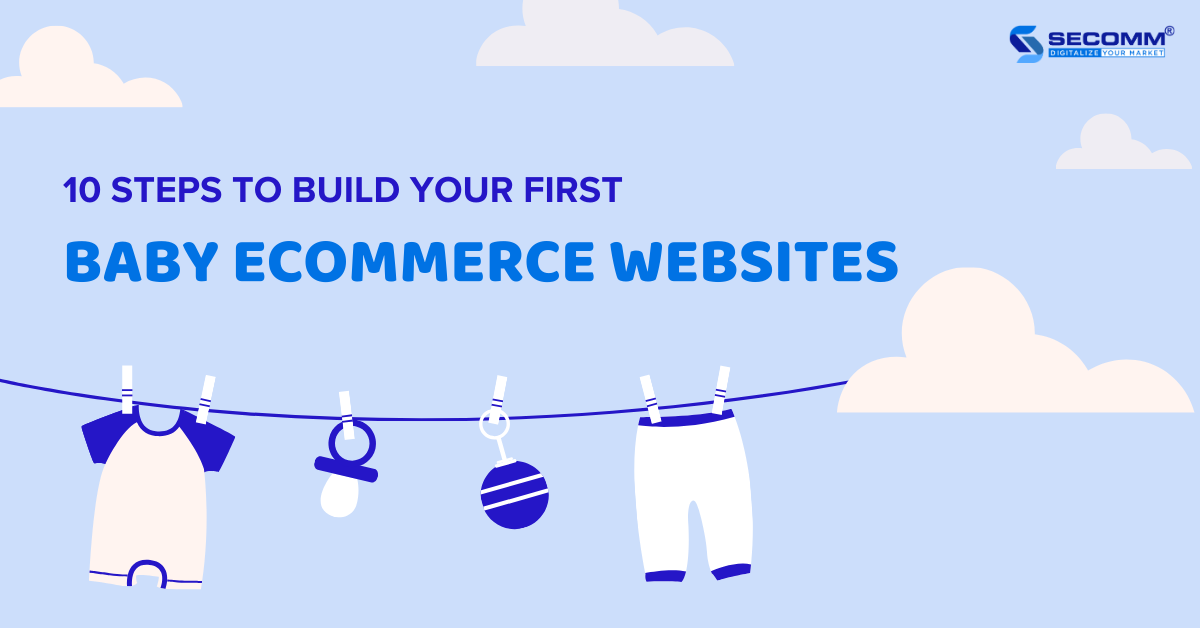
Baby eCommerce is a promising market experiencing a steady annual growth rate (CAGR 2023-2027) of 9.86%, projected to reach a market value of approximately USD 129.40 billion by 2027.
To tap into this market, you’ll need to develop a professional and efficient eCommerce website. Here are 10 steps to create an eCommerce website tailored for maternity and baby products.
The first step is to identify your business goals and prioritize them, forming a plan tailored to develop an effective Baby eCommerce website.
Concerning long-term goals, you may focus on objectives like establishing a strong brand presence, reaching potential customers, and enhancing the efficiency of both online and offline operations.
For short-term goals, businesses can give priority to activities like monitoring, analyzing customer behavior, assessing the effectiveness of marketing campaigns, and boosting revenue.
When it comes to timeline, you can decide to deploy quickly to enter the market or proceed gradually to test and adapt to this eCommerce world.
As for the budget, it depends on your business strategy and financial capacity for this Baby eCommerce development project.
Currently, there are two types of eCommerce platforms to help you build your first Baby website: SaaS (Software as a Service) and Open-Source platform.
Some popular SaaS eCommerce platforms include Shopify, BigCommerce, Squarespace, and Wix.
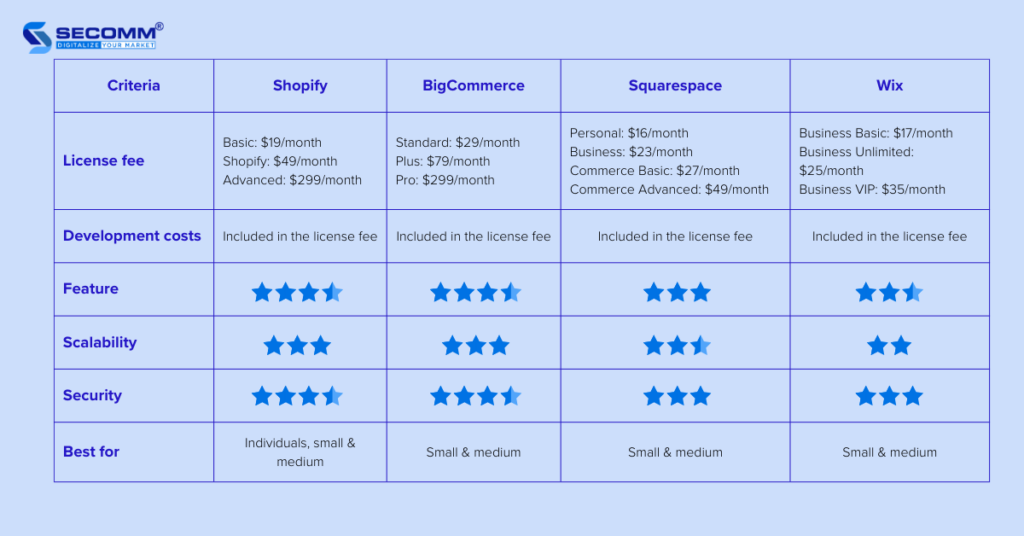
In addition, there are premium versions of these SaaS platforms such as Shopify Plus, BigCommerce Enterprise, and Goflow.
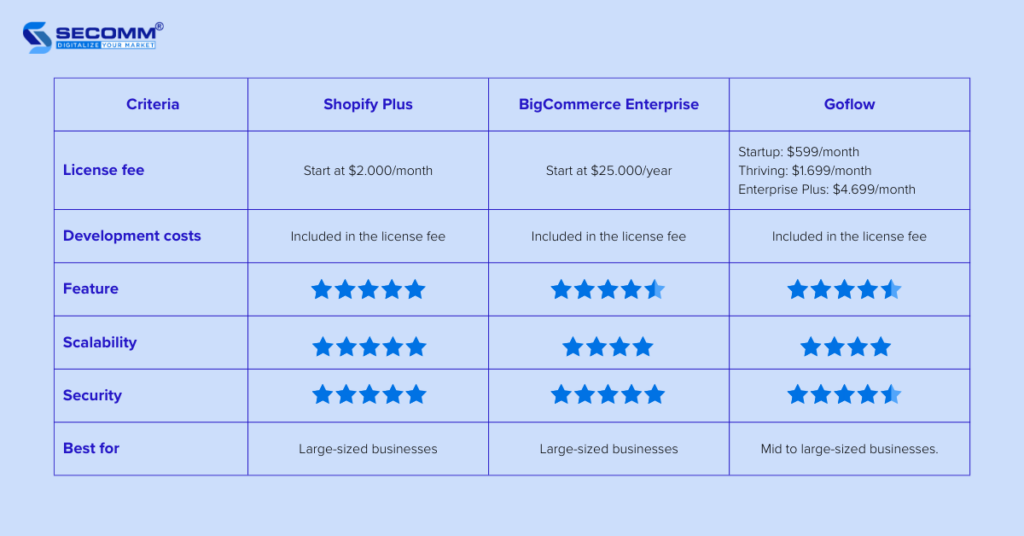
Some open-source platforms are widely used: Adobe Commerce (Magento), WooCommerce, OpenCart, and PrestaShop.
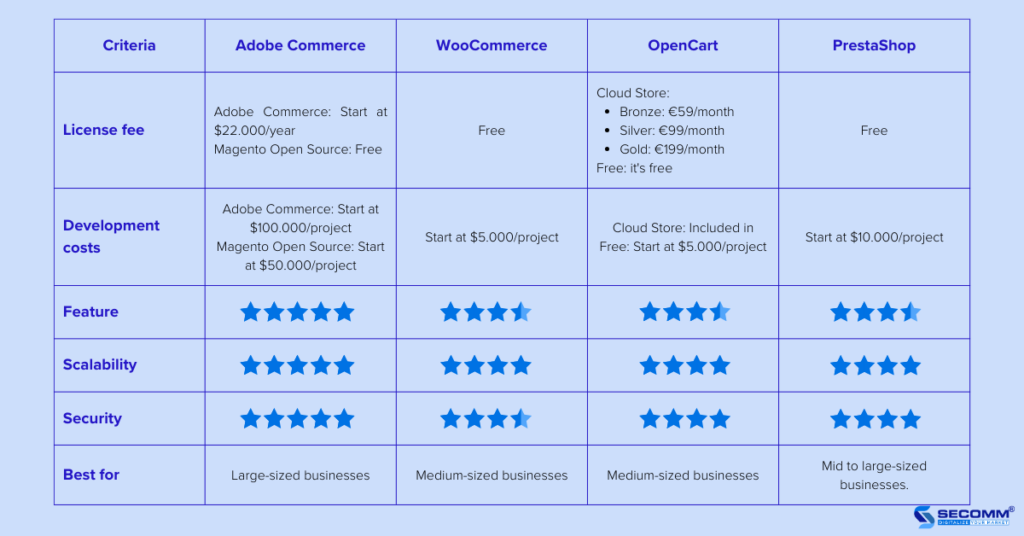
Typically, some new businesses choose basic SaaS platforms to save time and budget in the initial phase of the Baby eCommerce website development. After a while, they may switch to a premium SaaS or an open-source platform to develop their baby websites more advanced.
In another case, some businesses opt for open-source platforms to build a basic eCommerce website and then gradually upgrade the system over time to minimize the need for platform switching in later phases.
Typically, most eCommerce businesses decide to initially partner with a professional development agency and gradually build their in-house team.
For establishing an in-house team, you’ll need to recruit and train IT and eCommerce professionals for expertise on the chosen platform. It’ll take you significant time and budget but allow you to have full control over your resources. You can develop and adjust your Baby eCommerce website according to your needs and wants.
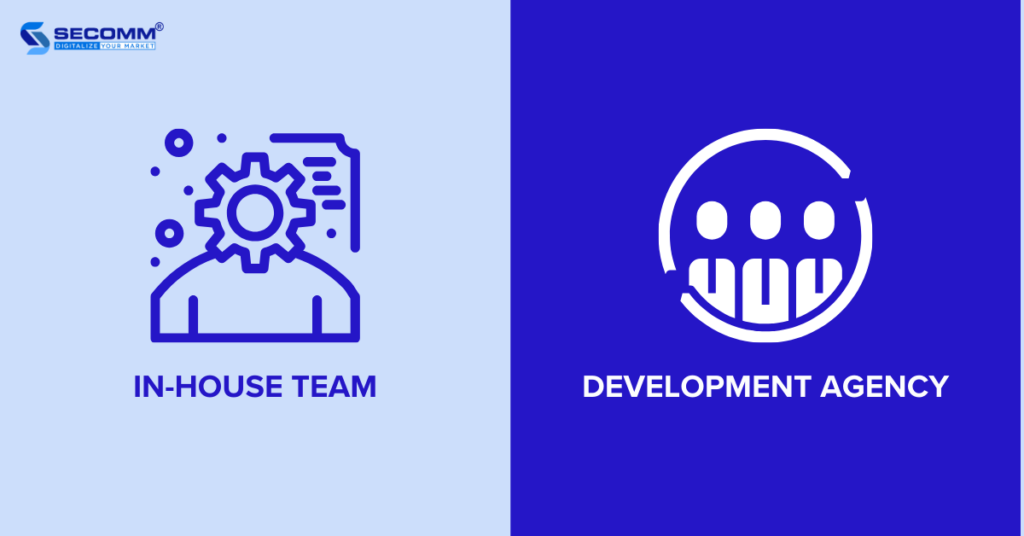
When it comes to partnering with an agency, here are some criteria you need to evaluate:
Partnering with a professional development agency gains you specialized eCommerce knowledge, enhances your technical skills, and above all, you’ll facilitate the eCommerce website exactly what you need, tailoring it to the unique features of the maternity and baby industry.
When it comes to UI/UX design, it’s important to showcase the brand image, products, user guide, etc. There are three popular ways to make your design:
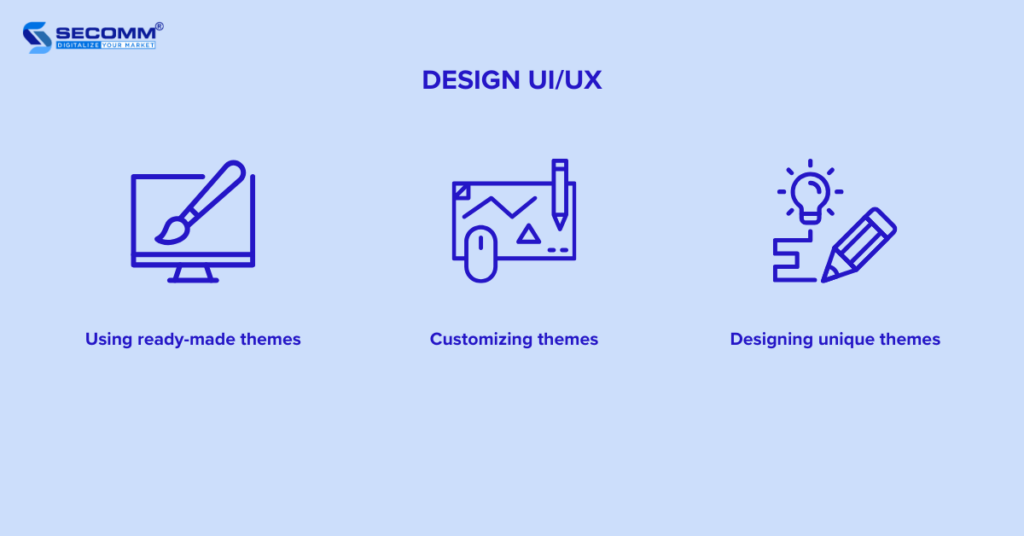
Some essential features that a Baby eCommerce website should have include
Some advanced features for the baby eCommerce industry:
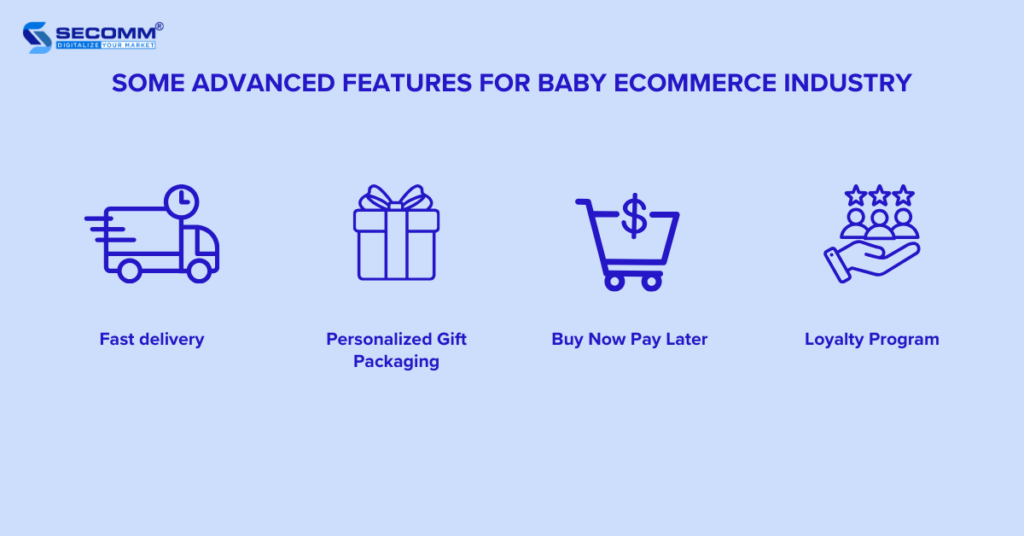
After developing features and ensuring a successful testing and website launch, you’ll need to complete the legal procedures associated with eCommerce operations.
According to Decree 52/2013/ND-CP by the Government of Vietnam, any individual or organization owning an eCommerce website for sales is required to notify or register with the Ministry of Industry and Trade through the online public service portal of the Ministry of Industry and Trade.
Note: Websites that operate beyond the specified period or fail to register/notify the authorized management agency within the designated timeframe may be subject to administrative penalties as per regulations.
When QC/testing your eCommerce website, you can leverage either the Waterfall or Agile model to test the entire system.
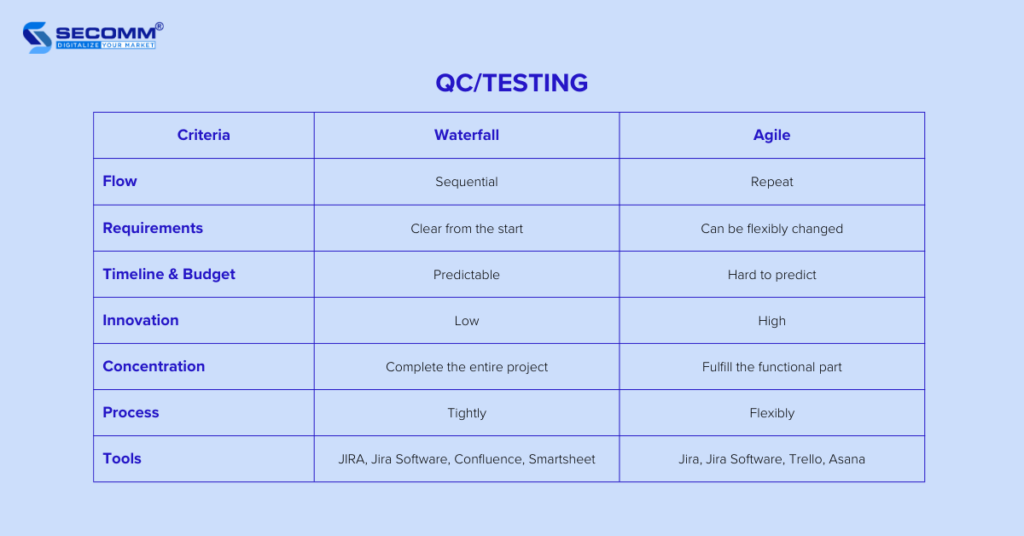
Using these models helps you review and test your entire eCommerce system, functions, and features within a specified timeframe, ensuring optimal order processing speed and overall website stability. In case of any issues, your in-house team or development partner will help you to address them before officially going live.
When the QC/testing process is done, your baby eCommerce website is ready to launch. To ensure a smooth go-live process, here are three steps you should prepare:
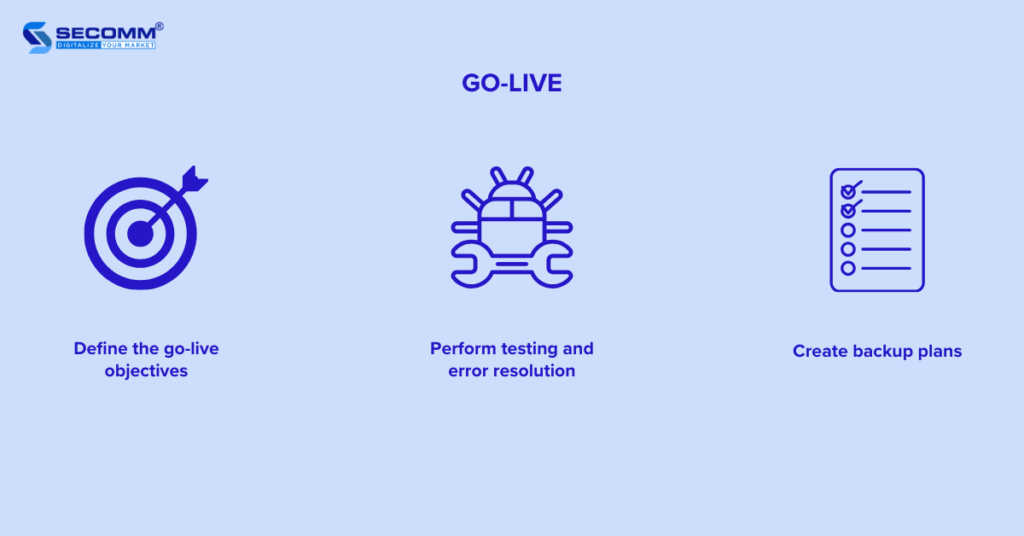
Running a baby website is an ongoing effort aimed at ensuring the steady and effective functioning of the system. This involves various activities, including:
Furthermore, you should regularly maintain, update, and upgrade the website system to achieve sustainable growth, adapting quickly to shifts in the eCommerce world or the maternity and baby products market.
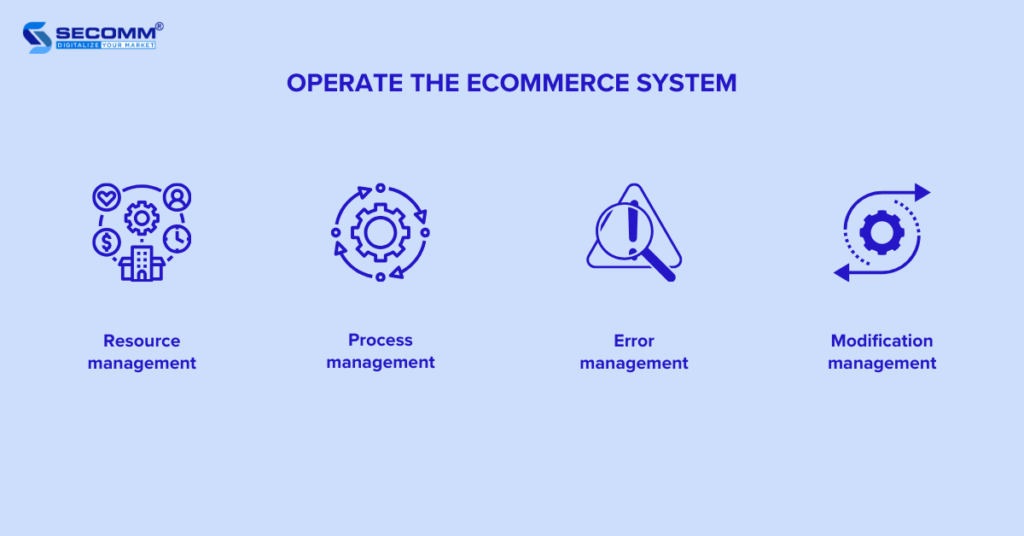
After a period of operation, you should shift your focus toward eCommerce marketing strategies or Omnichannel to expand your online presence in the market of maternity and baby products
businesses should redirect their focus toward implementing eCommerce marketing strategies or embracing Omnichannel approaches to expand their online presence in the market of mother and baby products.
Implementing Omnichannel involves setting up a seamless sales, marketing, and management system across channels such as the website, social media platforms (Facebook, Instagram, Zalo, TikTok Shop), and online marketplaces (Shopee, Tiki, Lazada, Sendo) to optimize the customer experience and boost business efficiency.
Developing a comprehensive marketing strategy, centered around key eCommerce marketing channels like Content Marketing, SEO/SEM, Email Marketing, and Affiliate Marketing, becomes crucial for achieving rapid sales growth.
The Bottom Line
In general, the journey of building a baby eCommerce website for the Vietnamese market isn’t an easy task. It requires you to invest a significant amount of time and budget in researching the most fitting strategies tailored to each phase of your eCommerce development.
Understanding the difficulties and challenges that businesses may encounter when building a baby eCommerce website, SECOMM is ready to provide free consultation on detailed eCommerce solutions.
Reach out or call the SECOMM hotline at 028 7108 9908 to get started!
 2
2
 5,876
5,876
 0
0
 1
1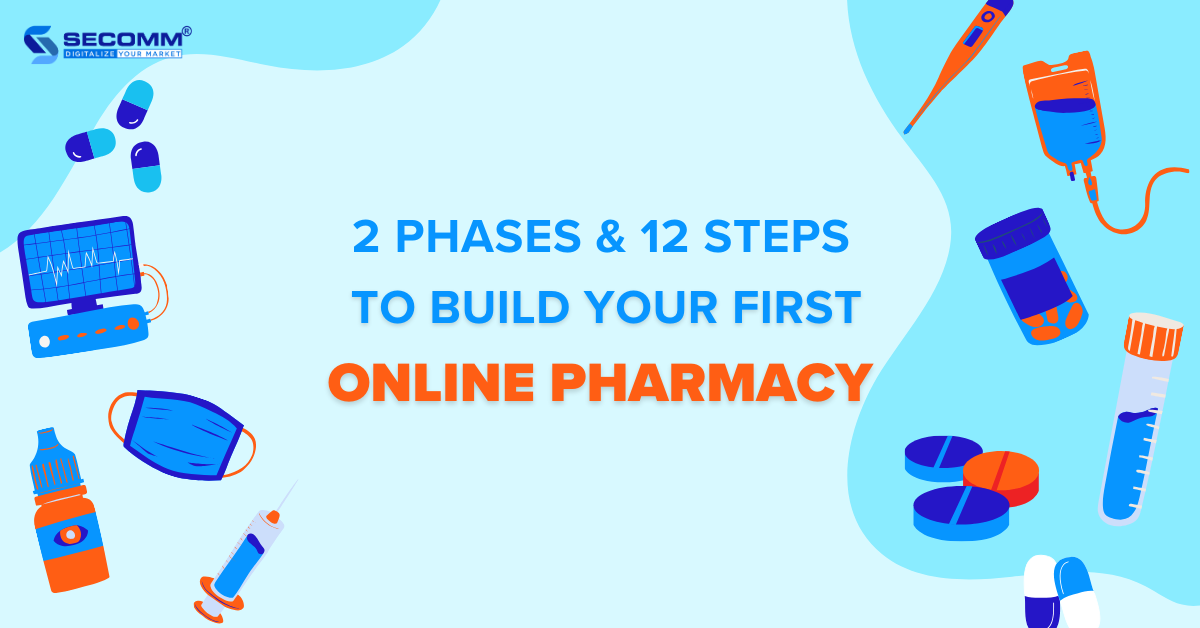
Since the advent of the COVID-19 pandemic, the pharmaceutical industry has proven the potential of transitioning from offline to online pharmacy. In the United States, the number of remote health consultations surged by 2,600% in March 2020 (during the peak of COVID-19 in the U.S.) compared to the same month in 2019. According to Statista, the global pharmaceutical eCommerce sector is projected to reach 32 billion USD by the end of 2023.
Several brands have successfully embraced eCommerce early on, achieving unexpected successes. Examples include Apollo Pharmacy (India), FPT Long Châu (Vietnam), CVS Health (USA), and Droga Raia (Brazil). The common thread among these brands lies in their comprehensive eCommerce platforms, catering to the shopping needs of customers for healthcare, pharmaceutical, and medical products.
With nearly 10 years of experience in the eCommerce sector, SECOMM has outlined the journey of building pharmaceutical eCommerce websites for the Vietnamese market.
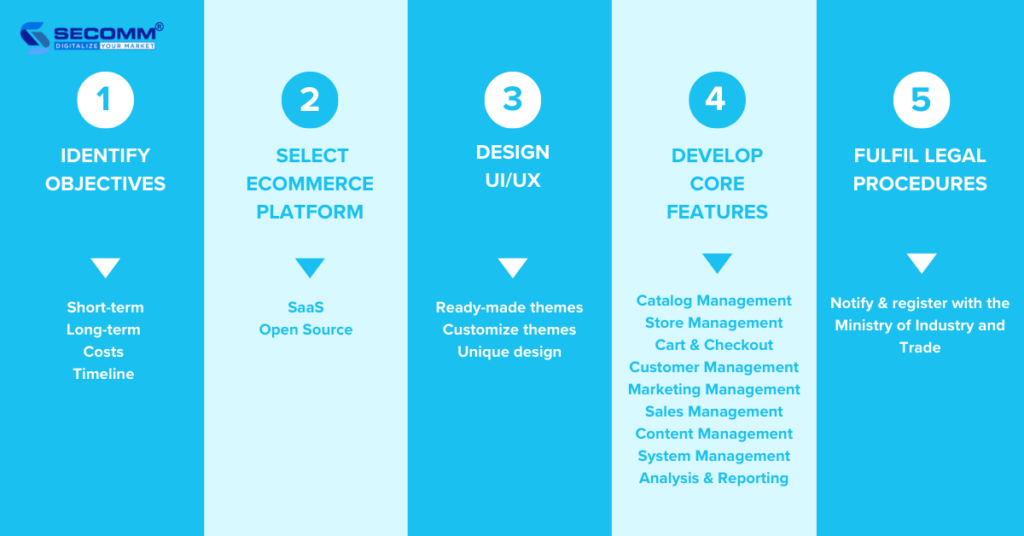
The first thing to do is identify and prioritize goals to plan the pharmacy eCommerce website development for each phase.
In the long run, businesses can consider goals like branding, generating potential customers, and optimizing online and offline operations.
For short-term goals, businesses should prioritize objectives like monitoring and analyzing customer behavior, evaluating marketing campaigns, and revenue growth.
In the first phase, businesses can decide to deploy quickly to enter the market or proceed gradually to test and adapt to this eCommerce world.
There are two types of platforms to help businesses facilitate pharmacy eCommerce websites: SaaS (Software as a Service) and open source.
Some popular SaaS eCommerce platforms include
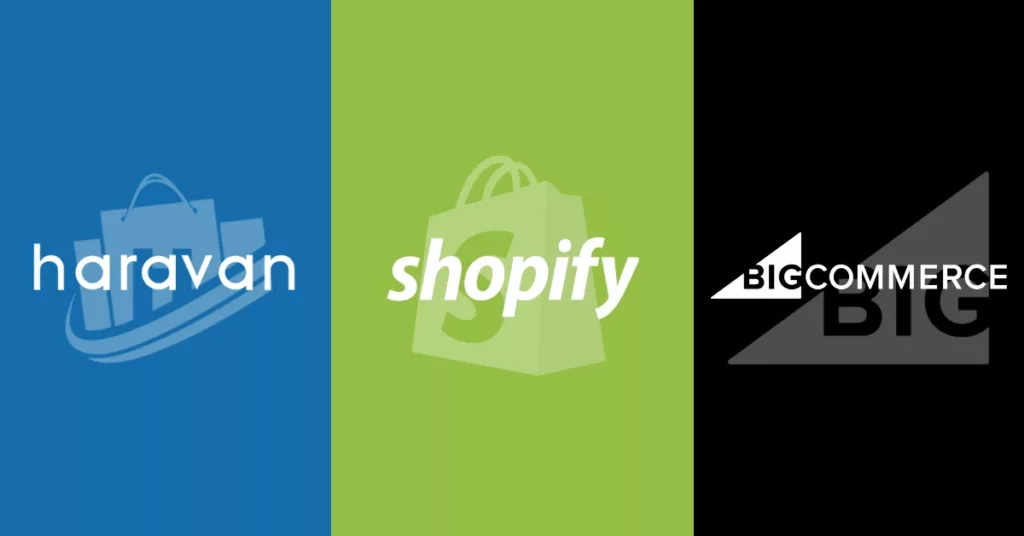
Some outstanding open-source eCommerce platforms include
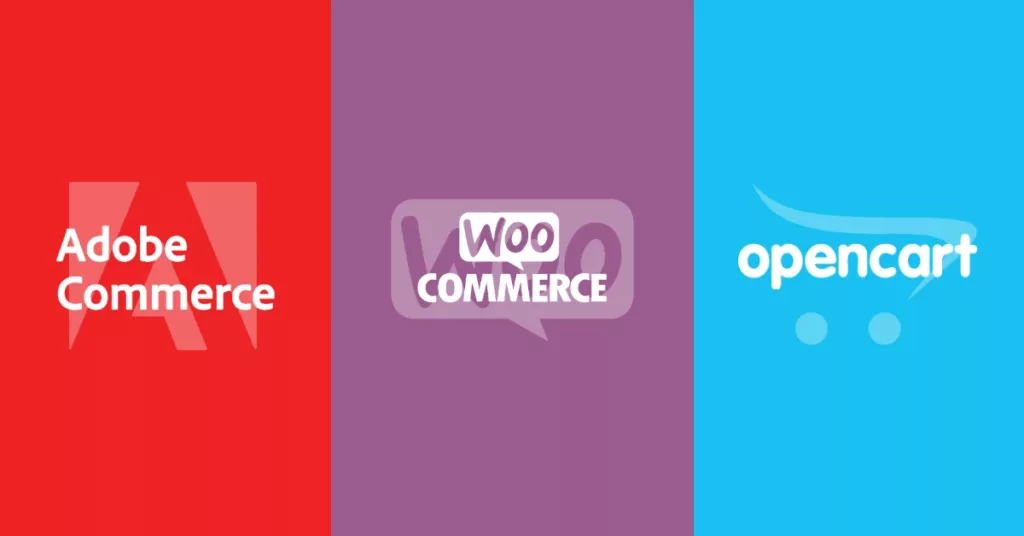
Typically, new eCommerce businesses will choose SaaS platforms to save time and budget in the initial phase of building a basic eCommerce website or an online pharmacy. Then, businesses will re-platform to an open-source platform to develop more advanced eCommerce systems.
However, some businesses decide to build their eCommerce websites in the basic phase on an open-source platform and then upgrade the system over time to remove the re-platforming step in the later phase.
When designing the interface, businesses need to meet basic criteria such as UI/UX standards, showcasing the brand’s characteristics, maintaining consistent product presentation, providing sufficient user guidance, etc.
When it comes to UI/UX design, it’s important to showcase the brand image, products, user guide, etc.
There are three ways to design UI/UX:
In this phase, businesses often choose ready-made themes to minimize costs, but some financially robust businesses may opt for the other two methods to better position their brand.
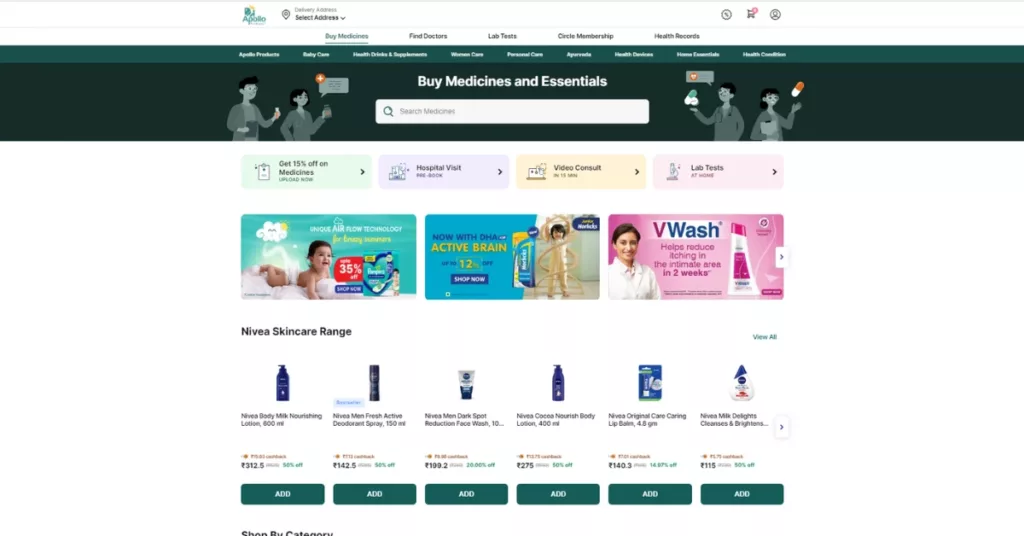
In the basic development phase, businesses should prioritize developing core features for an online pharmacy.
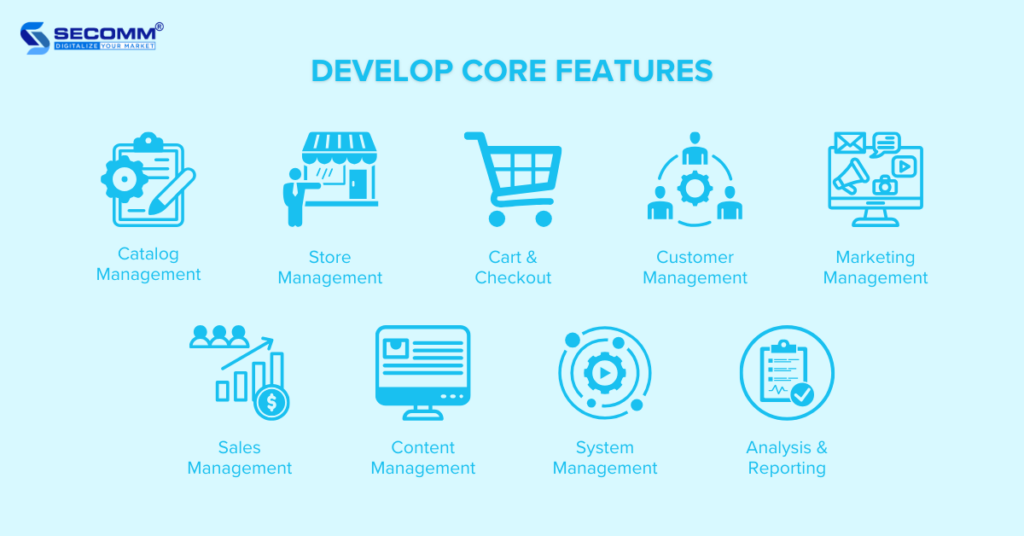
Some essential features that a pharmacy eCommerce website should have include
After developing features and ensuring a successful testing and website launch, businesses are obligated to complete the legal procedures associated with eCommerce operations.
According to Decree 52/2013/ND-CP by the Government of Vietnam, any individual or organization owning an e-commerce website for sales is required to notify or register with the Ministry of Industry and Trade through the online public service portal of the Ministry of Industry and Trade.
Note: Websites that operate beyond the specified period or fail to register/notify the authorized management agency within the designated timeframe may be subject to administrative penalties as per regulations.
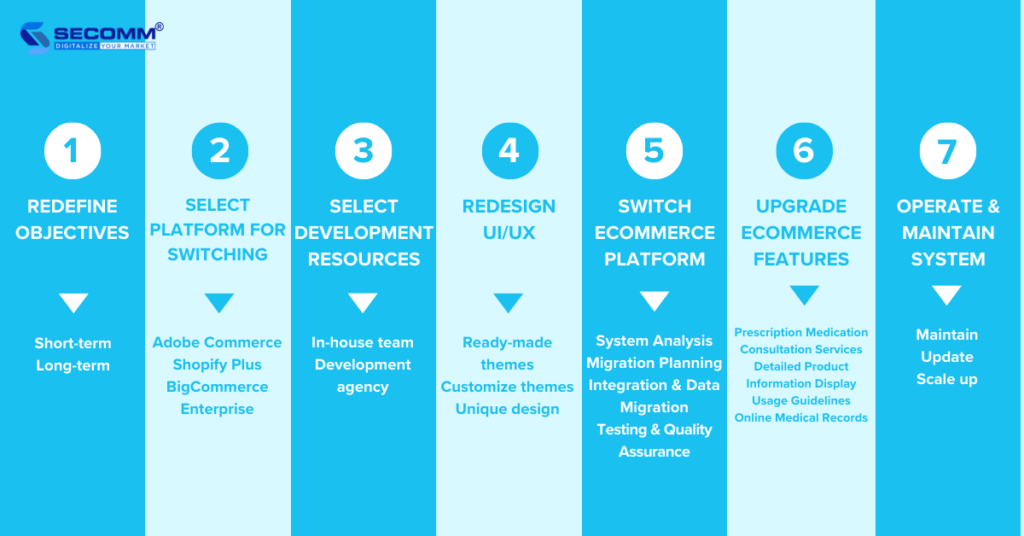
In the process of business development and amidst significant market changes, it’s important to realign goals to suit the evolving landscape. This time for business leaders to redefine objectives regarding the overall strategy, timeline, and budget for investing in the pharmacy eCommerce website.
During this phase, businesses often focus on short-term and long-term goals related to expanding the online pharmacy
For long-term goals, businesses may consider goals such as expanding market segments, establishing a loyalty program, and cultivating shopping habits for healthcare products, pharmaceuticals, and medical equipment.
For long-term goals, businesses may prioritize goals related to tapping into new potential customers, revenue growth, and supporting eCommerce marketing strategies such as livestreaming, gamification, affiliate marketing, and influencer marketing.
When SaaS platforms can’t support businesses to expand the system anymore, re-platforming to another robust platform is a top choice. Platforms like Adobe Commerce, Shopify Plus, and BigCommerce Enterprise can help businesses facilitate a deeply custom pharmacy eCommerce website.
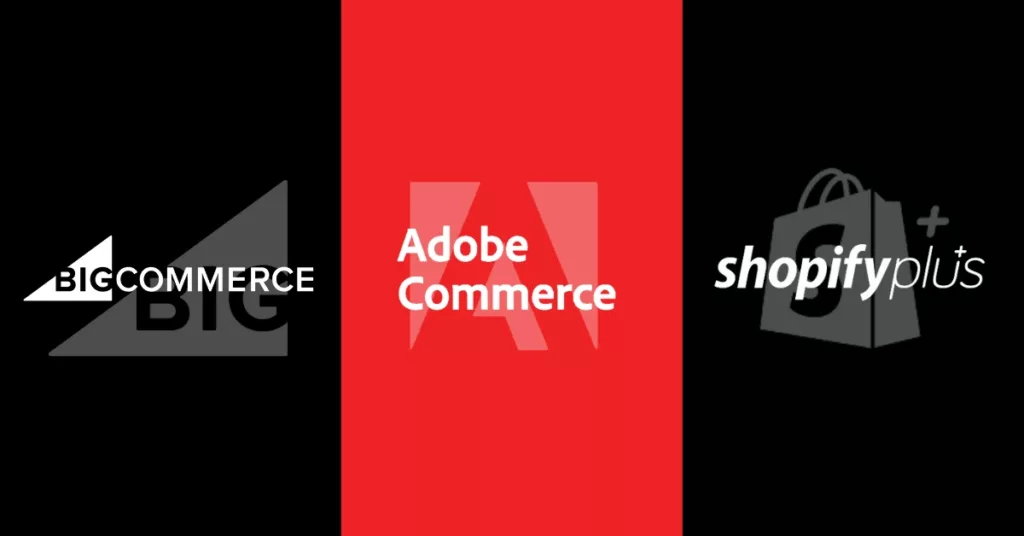
When re-platforming, businesses have challenges such as switching costs, time to train personnel, and data loss throughout the platform migration process.
To build a high-complexity online pharmacy on a professional platform, businesses need resources to facilitate it effectively.
Businesses can decide to build an in-house team or seek a development agency. Regardless of the choice, it requires businesses to have practical experience on the selected platform.
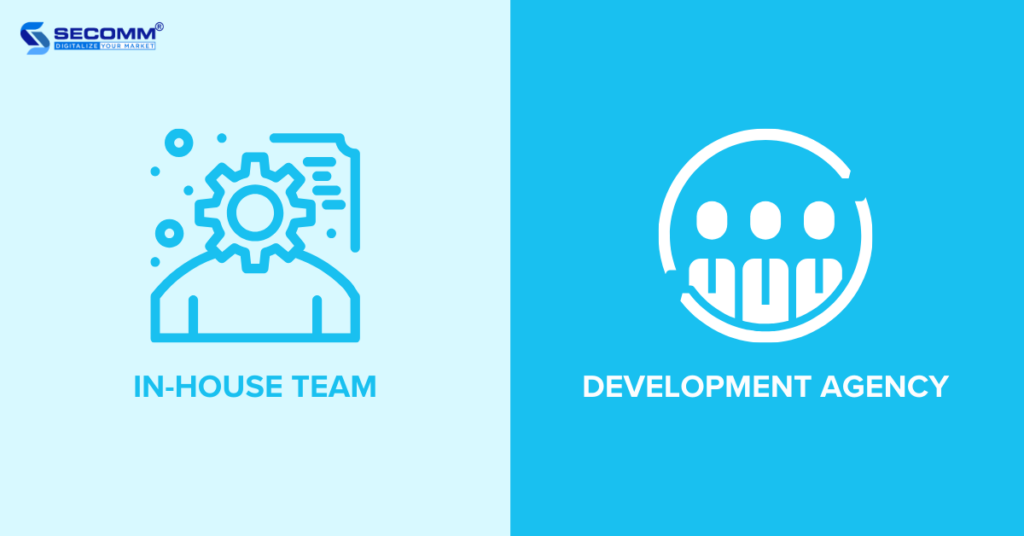
For building an in-house team, businesses need to recruit and train IT and eCommerce personnel to develop on the selected platform. This option may take time and budget to establish a high-performing team but it allows the business to have better control over resources and actively adjust or develop the website system.
In case businesses hire a development agency, here are some criteria to consider:
Partnering with a professional development agency will help businesses gain specialized knowledge, enhance experience, and create an online pharmacy tailored to the specific needs of the industry.
During the platform migration process, businesses can keep the current website design without making any changes. However, some businesses tend to redesign their websites to align with new strategies and the new platform.
Similar to the previous phase, businesses have three options to design their pharmacy eCommerce websites: using ready-made themes, customizing themes, or designing a unique interface.
However, in phase 2, businesses often decide to customize themes or design a unique interface to express the brand image and the pharmaceutical eCommerce industry.
After the right eCommerce platform for migrating, businesses should carry out the process to minimize the risk of data loss or errors. Typically, the migration process is automated as much as possible to avoid potential issues.
The migration process includes the following steps:
After re-platforming, the business needs to perform thorough checks to ensure that the data has been migrated completely and accurately according to the plan.
Beyond core features, businesses should focus on building a system with more complex features, including advanced and industry-specific functionalities for pharmaceutical eCommerce.
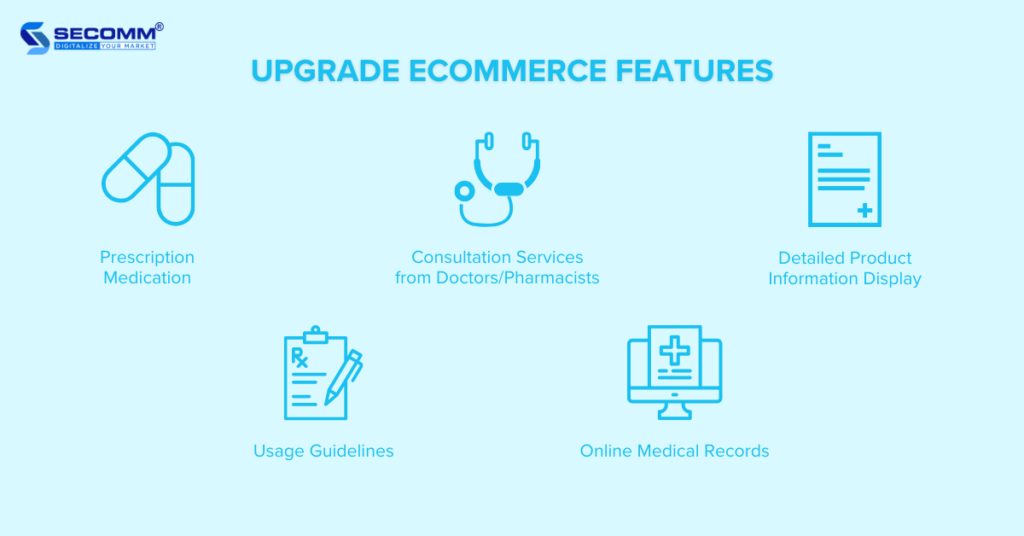
In addition, businesses need to consistently update and enhance these features to meet user needs and keep pace with market trends.
When testing the eCommerce system, businesses need to thoroughly check the entire website and its features over a specific period to ensure order processing speed and website stability. If any issues arise, businesses should immediately contact the in-house team or development partner to adjust and improve the website accordingly before officially going live.
Once the pharmacy eCommerce website system is stable, businesses should focus on eCommerce marketing strategies or Omnichannel approaches to enhance their online pharmacy.
Additionally, regular maintenance, updates, and continuous system upgrades are essential to sustain growth and quickly adapt to changes in the eCommerce market in general and the healthcare market in particular.
The Bottom Line
In general, the journey of building a pharmacy eCommerce website in Vietnam is not an easy task. This work demands substantial investments of time and budget from businesses to research the most suitable eCommerce strategy for each stage of their development.
Understanding the challenges that businesses may encounter when building an online pharmacy, SECOMM is ready to provide custom solutions for developing an eCommerce system.
Contact SECOMM or call the hotline at 028 7108 9908 for a free consultation.
 2
2
 6,455
6,455
 0
0
 1
1Subscribe to get the latest eBook!
Hotline